Information
Masahiro Harada + MAO

原田 真宏
Masahiro Harada
Career:
- 1973
- Born in Yaidu, Shizuoka Prefecture, Japan
- 1997
- Graduate from Shibaura Institute of Technology (Tokyo, Japan): Master of Architecture
- 1997-2000
- Worked in an architectural office of Kengo Kuma (Tokyo, Japan): Chief Architect
- 2001-2002
- Worked in an architectural office of Jose Antonio Martinez Lapena and Elias Torres (Barcelona, Spain): Chief Architect as National Fellowship for Artist(Japanese Government Scholarship)
- 2003
- Worked in an architectural office of Arata Isozaki (Tokyo, Japan): Project Manager
- 2004
- Established an Architectural office, MOUNT FUJI ARCHITECTS STUDIO (Tokyo, Japan)
- 2005-2006
- University of Keio (Tokyo, Japan),COE(Center of Excellence): Lecturer
- 2007
- Shibaura Institute of Technology (Tokyo, Japan): Lecturer
- 2007
- University of Keio (Tokyo, Japan): Lecturer
- 2008-2016
- Shibaura Institute of Technology (Tokyo, Japan): Associate Professor
- 2014-2015
- University of Tokyo (Tokyo, Japan): Lecturer
- 2015-
- Tohoku University (Sendai,Japan): Lecturer
- 2016-
- Shibaura Institute of Technology (Tokyo, Japan): Professor
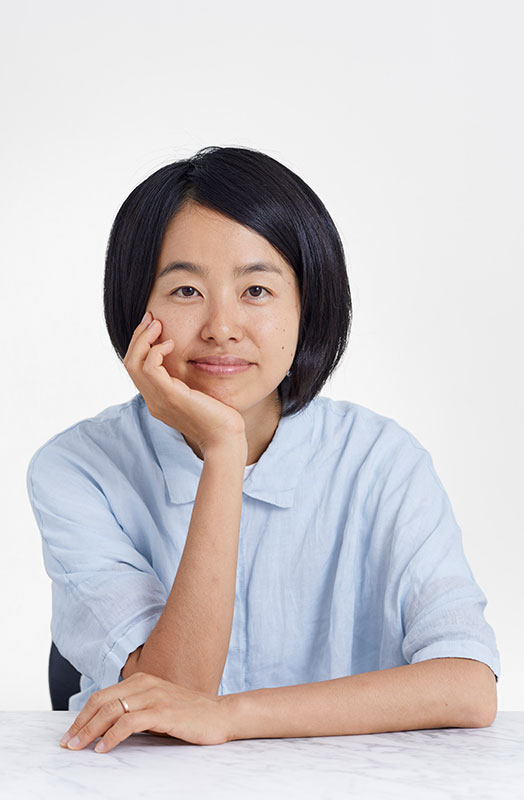
原田 麻魚
Mao Harada
Career:
- 1976
- Born in Sagamihara,Kanagawa Prefecture,Japan
- 1999
- Graduate from Shibaura Institute of Technology (Tokyo, Japan): Bachelor of Architecture
- 2000-2003
- Worked in an Editorial office of Workshop for Architecture and Urbanism (Tokyo, Japan)
- 2004
- Established an Architectural office, MOUNT FUJI ARCHITECTS STUDIO (Tokyo, Japan)
- 2013-
- Tohoku University (Sendai,Japan): Lecturer
Information
Awards
- 2025
- GOOD DESIGN AWARD「Ento」「Kintetsu-Hanzomon SQUARE」
- 2025
- 66th BCS Award "STROOG"
- 2025
- "Maebashi Creative City Urban Space Design from Prefectural Office to Maebashi Station – International Competition, Grand Prize"
- 2024
- CLT OF THE YEAR ―PIONEER― "STROOG"
- 2024
- 34th AACA Award, Excellence Award by the Japan Association of Artists, Craftsmen & Architects "ROOFLAG"
- 2024
- GOOD DESIGN AWARD 2024 "ROOFLAG"
- 2024
- Red Dot Design Award 2024
- 2024
- The 64th BCS Award 「Entô」
- 2023
- JIA Excellent Architecture Award「Ento」
- 2023
- Urban Landscape Award, Excellence Award「FLAPS」
- 2022
- 14th JIA Chugoku Architecture Award, Grand Prize「A&A LIAM FUJI」
- 2022
- Proposal for Detailed Design of the Road in the Center District near Nagareyama Otakanomori Station, Granprix, Joint venture: Tonichi Consultant & Mount Fuji Architects Studio
- 2022
- Urban Park Competition 2022, President's Award from the Japan Park and Greenery Association「FLAPS」
- 2022
- GOOD DESIGN AWARD「FLAPS」
- 2022
- ICONIC AWARD, Winner「Sengyoji
- 2022
- 32th Japan Association of Artists Craftsman & Architects Award(Japan):「Ento」
- 2022
- 30th Shimane Landscape Award, Excellence Award「Ento」
- 2022
- Selected for JIA Excellent Architecture Selection 2022「Ento」
- 2022
- Selected for JIA Excellent Architecture Selection 2022「ROOGLAG」
- 2022
- Proposal for Design Supervision of the Hitachitaga Station Area Development, Granprix
- 2021
- Shimane Architecture and Housing Competition, Excellence Award「Ento」
- 2021
- 31th Japan Association of Artists Craftsman & Architects Award(Japan):「A&A LIAM FUJI」
- 2021
- The 62th BCS Award 「Chiryu After school」
- 2021
- Public Design Proposal for Architectural Basic Design of the Kawaguchi City Green Center and 7 Other Facilities, Granprix
- 2021
- Public Proposal for Hiroshima City Soccer Stadium Development, 2nd Prize
- 2020
- Wood Design Award 2020 - 「ROOFLAG」
- 2020
- Architectural Institute of Japan Award (Works)「Roadsidestation Mashiko」
- 2020
- 23rd Wood Utilization Competition, Excellence Award (Chairman's Award from the Federation of Japan Wood Youth Organizations)「Sunagawa Printing Co., Ltd. Headquarters」
- 2019
- 14th Japan Structural Design Award「Roadsidestation Mashiko」
- 2019
- Proposal for Basic Design Work for the Nagi Town Children's Facility, Selected Candidate (Best Award), Joint venture: Kusuyama Design & Mount Fuji Architects Studio
- 2019
- Proposal for Design Work of the (Tentative Name) Towada City Community Exchange Center, Finalist
- 2019
- Environmental and Equipment Design Award 2017: First Prize「Roadsidestation Mashiko」
- 2019
- 22nd Wood Utilization Competition, Wood Utilization Award「Chiryu Afterschool」
- 2018
- The 59th BCS Award 「Roadsidestation Mashiko」
- 2017
- GOOD DESIGN AWARD「Roadside Station MASHIKO」
- 2017
- LEAF Awards 2018 -Mixed Use Building,Public Building:shortlist 「Roadside Station Mashiko」
- 2018
- GOOD DESIGN AWARD 2018 - 「Kiraku no Ie」
- 2018
- JAPAN WOOD DESIGN AWARD 2018「Kiraku no Ie」
- 2018
- Architectural Institute of Japan Works Selection Award 「House toward Tateyama」
- 2018
- JIA Japan Architecture Award, Excellence Award: Japan Architecture Award「Roadside Station Mashiko」
- 2018
- 25th Aichi Townscape Architecture Award: Aichi Townscape Architecture Award 「tonarino」
- 2017
- 33th Urban Park Contest: the Director-General of the City Bureau of MLIT Award「tonarino」
- 2017
- GOOD DESIGN AWARD 2017: GOOD DESIGN AWARD「Chiryu Afterschool」
- 2017
- 29th Maronie Architecture Award in Tochigi Prefecture: The first prize「Roadside Station Mashiko」
- 2017
- International Biennial Barbara Cappochin Prize: Best 40 of the 8「Roadside Station Mashiko」
- 2017
- 2017 JIA Tokai Architectural Prize For Housing Projects 2017:1st Prize 「KASA」
- 2017
- 2017 Architectural Institute of Japan Annual Architectural Design Commendation:「Shore House」
- 2016
- 56th Toyama design Exhibition:「UCHI-MIZU」
- 2016
- LOCUS DESIGN FORUM[書・築] AWARD:2nd prize
- 2016
- TOYAMA PRODUCTS 2016:「UCHI-MIZU」
- 2016
- GOOD DESIGN AWARD 2016:「UCHI-MIZU」
- 2016
- Open Proposal for Meijo Park in Nagoya(Japan):1st Prize
- 2016
- arcVision Prize 2016(Italy):Nominee**
- 2015
- 25th Japan Association of Artists Craftsman & Architects Award 14th Yoshinobu Ashiwara Award(Japan):「Seto」
- 2015
- T-1 Grand Prix 2014(Japan):Grand Prix「Salon in Kazo」
- 2015
- Taga Town Central Public Hall Competition(Japan):Final 5
- 2015
- The Japan Institute of Architects 100 Selected Works(Japan):「Log H」
- 2015
- Selected Architectural Designs of the Architectural Institute of Japan 2016(Japan):「Salon in Kazo」
- 2015
- Selected Architectural Designs of the Architectural Institute of Japan 2016(Japan):「Log H」
- 2015
- German Design Award 2016(Germany):Winner「Seto」
- 2015
- AR HOUSE 2015(UK):Finalist「Log H」
- 2015
- Selected Architectural Designs of the Architectural Institute of Japan 2015(Japan):「Seto」
- 2015
- JIA Young Architects Award 2014(Japan):「Shore house」
- 2014
- LEAF Awards 2014 -Residential Building of the Year-Multiple Occupancy-(UK):Winner「Seto」
- 2014
- Iconic Award 2014(Germany):Winner「Seto」
- 2014
- Nichijiren Architectural Award(Japan):Award of Excellence「Seto」
- 2014
- The 6th Chugoku Architecture Award 2014(Japan):Award of Excellence「Seto」
- 2014
- The Japan Institute of Architects 100 Selected Works(Japan):「Shore house」
- 2014
- Open Proposal for Mount Fuji World Heritage Center(Japan):2nd Prize
- 2013
- Selected Architectural Designs of the Architectural Institute of Japan 2014(Japan):「Geo Metria」
- 2013
- Selected Architectural Designs of the Architectural Institute of Japan 2014(Japan):「VALLEY」
- 2013
- Open Proposal for Roadside Station in Mashiko(Japan):1st Prize
- 2012
- The Japan Institute of Architects 100 Selected Works(Japan):「Tree House」
- 2012
- The 44th Chubu Architecture Award 2012(Japan):「VALLEY」
- 2012
- Iakov Chernikhov International Prize(Russia)Best 10 Architects under 44 Years Old in the World
- 2011
- ar+d Awards for Emerging Architecture 2011(UK):Commended「Sagacho Archives」
- 2011
- AR House 2011(UK):Commended「near house」
- 2010
- MODERN DECORATION INTERNATIONAL MEDIA PRIZE 2010(China):Annual Residential Space Award「Tree house」
- 2010
- The 42th Chubu Architecture Award 2010(Japan):「PLUS」
- 2010
- LEAF AWARDS 2010 -Residential Building of the Year-Single Occupancy(UK):1st Prize「PLUS」
- 2010
- RECORD HOUSES 2010 Architectural Records(USA):「Tree house」
- 2009
- Design Vanguard 2009 Architectural Records(USA):TOP 10 ArchitectS in the World
- 2009
- AR Awards for Emerging Architecture 2009(UK):Commendation「PLUS」
- 2008
- Logical Sense of Design and Structure Award(Japan):「M3/KG」
- 2008
- AR Awards for Emerging Architecture 2008(UK):Honourable Mentions「Rainy/Sunny」
- 2007
- The Barbara Cappochin Prize for Architecture(Italy):Best International Works「XXXX」
- 2006
- Competition of the 100th Anniversary Hall at Yamagata University(Japan, support:JIA):Final 22
- 2006
- Kokueikan Project(Japan, support:Shinkenchiku-sha):Final 25
- 2006
- Wood Architecture Design Competition(Japan):Merit Award「Secondary Landscape」
- 2004
- American Wood Design Award 2004(Japan):Honor Award「XXXX」
- 2003
- SD Review 2003(Japan):Grand Prix(Kajima Award)「XXXX」
- 2002
- Architecture for Humanity World Competition 2002(USA):Selected Work
- 2001
- Tokyo Designer's Block 2001(Japan)
- 2001
- National Fellowship for Artist Japanese Government(Japan)*
- 2000
- Tokyo Designer's Block 2000(Japan)
- 2000
- SD Review 2000(Japan):Merit Award
- 2000
- Director General of Forestry Agency Award(Japan)「Museum of Hiroshige Ando」*
- 2000
- Advan Stone Design Competition(Japan):Merit Award*
- 1998
- Museum of Hiroshige Ando Competition(Japan):1st Prize*
- 1997
- Master's Thesis Arimoto Shiro Memorial Award(Japan):1st Prize*
- 1997
- The Second Living Design Competition(Japan):2nd Prize*
- 1995
- Kansai-kan of the National Diet Library Competition(Japan):Honorable Mention*
- 1995
- Competition of Architectural Institute of Japan -Temporary Housing-(Japan):Merit Award*
*Masahiro Harada single
**Mao Harada single
Information
Lecture/Workshop
- 2025
- Japan Architecture Student Challenge Competition Jury Member*
- 2025
- 37th JIA Young Architects Award Jury Member**
- 2025
- Maebashi City Street Furniture Exhibition Special Jury Member**
- 2025
- Sato Kogyo Co., Ltd. Lecture*
- 2025
- Nikkenren Outstanding Architecture Selection Committee Member*
- 2025
- Phase-Free Award Jury Member*
- 2025
- Good Design Award 2025 Jury Member (Unit Leader)*
- 2025
- Japan Federation of Architects & Building Engineers Associations, Architectural Award Selection Committee Member*
- 2025
- 12th JIA Tokai Housing Architecture Award 2025 Jury Member**
- 2025
- Fujishi Mirai Lecture – Guest Speaker*
- 2025
- Safety Global Promotion Organization GISHW 2025 Chair Speaker*
- 2025
- ICS College of the Arts Lecture**
- 2025
- 12th POLUS Student Architecture Design Competition Jury Member*
- 2025
- Japan Structural Design Award – Selection Committee Member**
- 2025
- Kengo Kuma Architecture Scholarship Foundation – Selection Committee Member*
- 2025
- National Student Architecture Challenge Competition – Judge*
- 2025
- Tokyo Architecture Award – Selection Committee Member*
- 2025
- Chubu Graduation Design Exhibition – Judge*
- 2025
- Akarenga Graduation Design Exhibition – Judge*
- 2025
- Nagaoka Institute of Design – Visiting Lecturer**
- 2024
- CLT DESIGN AWARD 2024 Jury*
- 2024
- Osaka Building Association Technical Seminar*
- 2024
- Gamogori City Otsuka District Nursery Jury*
- 2024
- The 4th Architectural Science Festival ~ Rookie Selection Jury**
- 2024
- Nippon Electric Glass Building Materials Architect Seminar Lecture*
- 2024
- Nikken Sekkei Lecture*
- 2024
- Nagoya City University Graduate School of Design Special Lecture*
- 2024
- the 15th Global Architecture Masters Forum Xiamen Lecture*
- 2024
- LIXIL Tile Business 100th Anniversary Seminar Lecturer*
- 2024
- 2024 Architectural Institute of Japan Awards Selection Committee (Works Division)**
- 2024
- "Kengo Kuma & Higashikawa Town" KAGU Design Competition Jury*
- 2024
- Wood Design Award 2024 Jury*
- 2024
- Wood City TOKYO Model Architecture Award Jury*
- 2024
- Living Design Center OZONE Professional Seminar Lecturer*
- 2024
- Ministry of Land, Infrastructure, Transport and Tourism Specialized Course for Wood Utilization Promotion Lecture (FY2024)*
- 2024
- Tabayama Village HOOP CHALLENGE Implementation Competition 2024 Jury*
- 2024
- Lecture on Promoting Wooden and Wood-based Architecture Using Cedar Materials*
- 2024
- JIA Architectural Award Selection Committee*
- 2024
- Maruoka Corporation Keynote Speech*
- 2024
- Shizuoka Prefecture Urban Planning Association Lecture*
- 2024
- Phase Free Award Jury*
- 2024
- Ibaraki University Graduation Design Exhibition Guest Lecturer**
- 2024
- Hiroshima Architectural Student Challenge Competition 2024 Jury Chair*
- 2024
- The 11th POLUS Student & Architectural Design Competition Jury*
- 2024
- Lighting Competition 2024 Jury**
- 2024
- Good Design Award / Jury*
- 2024
- Japan Structural Design Award Selection Committee Member**
- 2023
- Mitsubishi Estate Design Completion Project Excellence Award / Jury*
- 2023
- Tokyo Architecture Collection 2024 Design Exhibition / Jury*
- 2023
- Musashino University Graduation Design Review Meeting / Jury**
- 2023
- Kogakuin University Graduation Design Final Review / Guest Critique*
- 2023
- CLT DESIGN AWARD 2023 / Jury*
- 2023
- Meiji University Special Lecture*
- 2023
- Forestry Agency Wood Utilization Symposium 2023*
- 2023
- Tokyo Metropolitan MOCTION Seminar*
- 2023
- JIA Excellent Architecture Selection Committee Member*
- 2023
- Wood City Tokyo Model Building Award / Jury*
- 2023
- Architectural Cost Management System Research Institute / Lecture*
- 2023
- Japan Association of Structural Engineers Ice Stick Bridge Contest / Jury**
- 2023
- Japan Architectural Institute Awards Selection Committee (Works Section)**
- 2023
- "DABURA.m Solo Exhibition" Talk Event / Speaker*
- 2023
- Ministry of Land, Infrastructure, Transport and Tourism Expert Course Wood Utilization Promotion Training / Lecture*
- 2023
- Nagareyama Graphic Award 2022 / Jury*
- 2023
- Japan Architectural Institute Architectural Design Presentation Meeting / Invited Critique**
- 2023
- JIA Tokyo Student Graduation Design Competition 2023 / Jury**
- 2023
- Wood Design Award 2023 / Jury*
- 2023
- 10th JIA Tokai Residential Architecture Award 2023 / Chief Jury*
- 2023
- Nihon Jishinren Architecture Award / Jury*
- 2023
- 10th POLUS Student Architectural Design Competition / Jury*
- 2023
- Phase Free Award / Jury*
- 2023
- Forestry Agency Wooden Architecture Exchange Meeting*
- 2023
- KMEW Architect Special Lecture*
- 2023
- 3rd "Kengo Kuma & Tokigawa Town" KAGU Design Competition / Jury*
- 2023
- Chiba University Graduation Design Exhibition / Guest Critique*
- 2023
- Japan Architectural Institute Awards Selection Committee (Technical Section)*
- 2023
- Tokyo Metropolitan Architect Training Seminar / Lecture*
- 2023
- 5th COFI Wooden Architecture Design Award / Jury*
- 2022
- Hitachitaga Station Area Grand Design Workshop*
- 2022
- JIA Tokai Residential Architecture Award /Jury*
- 2022
- Nikkenren Architecture Seminar / Lecture*
- 2022
- General Incorporated Association Houbi Lecture / Lecture*
- 2022
- University of Tokyo Graduate School Final Review / Guest Critique
- 2022
- Daiko Electric Online Seminar / Lecture**
- 2022
- Kinomachi Conference 2022 Talk Session
- 2022
- Daito Trust Construction Course Yumeie. / Lecture*
- 2022
- JIA Rookie Award / Jury*
- 2022
- CLT DESIGN AWARD - Design Competition / Jury*
- 2022
- Wood Design Award / Jury*
- 2022
- Nagareyama Graphic Award 2022 / Jury*
- 2022
- Yoshioka Bunko Educational Foundation Seminar / Lecture*
- 2022
- Wood City Tokyo Model Building Award / Jury*
- 2022
- KMEW Architect Special Lecture*
- 2022
- SD Review / Jury*
- 2022
- 9th POLUS Student Architectural Design Competition / Jury*
- 2022
- 2nd "Kengo Kuma & Tokigawa Town" KAGU Design Competition / Jury*
- 2022
- 31st JIA Tokyo Student Graduation Design Competition 2022 / Jury**
- 2022
- 2022 Good Design Award / Jury(Unit Leader)*
- 2022
- Red Brick Graduation Design Exhibition 2022 / Jury*
- 2022
- Shizuoka Prefecture Forestry Promotion Division CLT Utilization Seminar / Lecture*
- 2022
- 4th COFI Wooden Architecture Design Award / Jury*
- 2021
- Japan Institute of Architects Tokai Chapter Mie Regional Architectural Culture Lecture / Lecture*
- 2021
- JIA Excellent Architecture Selection 2021 / Jury*
- 2021
- ROOFLAG First Anniversary Event / Speaker*
- 2021
- JSCA Structural Idea Competition / Jury*
- 2021
- Seian Design University / Lecture*
- 2021
- CLT Summit Public Discussion*
- 2021
- Interior Coordinator Club TOYAMA Lecture / Lecture*
- 2021
- Nagareyama Otakanomori S.C. Graphic Award 21 / Jury*
- 2021
- JSCA Structural Idea Competition / Jury*
- 2021
- CLT Idea Contest 2021 / Jury*
- 2021
- Nikkei BP Architecture Summit / Speaker*
- 2021
- Publication Commemoration Online Seminar for "Structural Guidebook for Large-Scale Wooden Buildings"
- 2021
- SD Review / Jury*
- 2021
- Waseda University Special Lecture / Lecture**
- 2021
- Wood City Tokyo Model Building Award / Jury*
- 2021
- 8th POLUS Student Architectural Design Competition / Jury*
- 2021
- 2021 Good Design Award Architecture (Industrial/Commercial Facilities) / Jury(Unit Leader)*
- 2021
- 1st "Kengo Kuma & Tokigawa Town" KAGU Design Competition / Jury*
- 2021
- Architectural Research and Development Consortium Lecture / Lecture*
- 2021
- COFI Mid-rise Wooden Architecture Design Award / Jury*
- 2021
- CLT Idea Contest 2020 Design Section / Lecture*
- 2020
- Okinawa Prefecture Architect Association Engineer Training Program Architectural Lecture / Lecture*
- 2020
- CLT Architecture Promotion Council (Kochi) CLT Forum in Kochi / Lecture*
- 2020
- Housing Challenge Award 2020 / Jury**
- 2020
- 60th Toyama Prefecture Design Exhibition / Jury*
- 2020
- Maeda Corporation ICI Camp Idea Competition / Jury*
- 2020
- CLT Association CLT PARK HARUMI Event Interview Appearance*
- 2020
- 2020 Good Design Award Architecture and Interiors for Industry and Commerce / Jury (Unit Leader)*
- 2020
- 18th Iraka Award / Jury*
- 2020
- 7th POLUS Student Architectural Design Competition / Jury*
- 2020
- Keynote Speaker at the International Conference "Green Initiative Week in the Philippines" in Cebu*
- 2020
- Japan Women's University / Masako Yoshioka Award Selection Committee Chair*
- 2020
- Japan CLT Association CLT Seminar / Lecture*
- 2020
- Workshop on CLT for Developers / Lecture*
- 2020
- Takenaka Corporation "The Now of Form" / Lecture*
- 2020
- Nikkei BP Comprehensive Research Institute Seminar on Designing Medium-Sized Wooden Structures / Lecture*
- 2020
- Comprehensive Qualification Academy Graduation Celebration Event Special Project / Lecture**
- 2019
- CLT Idea Contest 2019 / Jury*
- 2019
- Architectural Student Alliance Hokkaido Group Lecture Series 61 / Lecture*
- 2019
- "Mirai no Tane Award" Symposium, Tour, and Seminar "Landscape and Architecture" / Lecture*
- 2019
- CLT Forum 2019 "New Spaces Opened by CLT" / Lecture*
- 2019
- Maeda Corporation ICI Grand Opening Ceremony / Speaker*
- 2019
- 2020 Japan Architectural Institute Works Selection Award / Jury*
- 2019
- Nagoya University Comprehensive Architecture Seminar 2019 / Lecture*
- 2019
- JIA Shizuoka Housing Month Lecture "Architecture of Landscape" / Lecture*
- 2019
- 7th Symposium for Students and Professionals on "Environmental and Equipment Design" / Lecture*
- 2019
- TWOODRISE (Canada) / Lecture/Panel Discussion*
- 2019
- Daiko Electric Lighting Seminar / Lecture*
- 2019
- Tajima Roofing Lecture / Lecture*
- 2019
- Wood City Tokyo Model Building Award / Jury*
- 2019
- 26th Spatial Design Competition / Jury*
- 2019
- 14th Aichi Prefecture Architect Association Student Competition 2019 / Jury*
- 2019
- Student Competition "Creating Future Landscapes: Plan for the Richness of the Town for the Reiwa Era!" / Jury*
- 2019
- Future Design Lab "Next-Generation Richness and Future Architecture" / Lecture*
- 2019
- Mirai no Tane Award / Jury*
- 2019
- Talk Show @ Cassina ixc. @ Fukuoka "New Landscapes" / Lecture*
- 2019
- 6th POLUS Student Architectural Design Competition / Jury*
- 2019
- 2019 Good Design Award Residential Buildings / Jury*
- 2019
- Wooden Structure Terrace 3rd Public Seminar "Speaking of the Possibilities of Wooden Architecture" / Lecture*
- 2019
- Okayama Prefecture Architect Association Architecture Fest 2019 Architectural Lecture / Lecture**
- 2019
- Taisei Corporation DESIGN FORUM 2019 / Lecture
- 2019
- JIA Kanto Koshinetsu Chapter Kanagawa Architectural Festival 2019 Kanagawa Graduation Design Competition / Jury**
- 2019
- Kyoto Prefecture Architect Association Wooden Design Seminar for Architects / Lecture*
- 2019
- KMEW Special Lecture / Lecture*
- 2019
- JIA Nagano Prefecture Club 13th Architectural Festival "People, Town, Architecture: Looking at Living Spaces 2019" Nagano Prefecture Student Graduation Design Competition / Chief Jury*
- 2019
- JIA Nagano Prefecture Club 13th Architectural Festival "People, Town, Architecture: Looking at Living Spaces 2019" / Lecture*
- 2019
- National Graduate School of Land, Infrastructure, Transport and Tourism / Lecture**
- 2019
- COFI Mid-rise Wooden Architecture Design Award 2018 / Jury*
- 2019
- Wooden Forum Hamamatsu International Conference Expert Meeting / Lecture*
- 2019
- Wooden Forum Hamamatsu International Conference Symposium / Panelist**
- 2019
- 175th Architect Forum / Lecture*
- 2018
- Wood City Tokyo Model Building Award / Jury*
- 2018
- Learn with Mokei! Structure of Architecture / Lecture*
- 2018
- JIA Architects Club Friday Meeting Talk Event / Speaker**
- 2018
- 2019 Japan Architectural Institute Works Selection Award / Jury*
- 2018
- AACA Landscape Symposium / Panelist**
- 2018
- Michi-no-Eki Mashiko Earth Festival Talk Session / Lecture*
- 2018
- Oimachi Station Public Space Design Competition / Lecture**
- 2018
- 4th La Atelier Student Implementation Competition / Chief Jury*
- 2018
- Hamamatsu City Architecture Staff Training Course / Lecture*
- 2018
- Chiba Institute of Technology / Invited Critique*
- 2018
- 19th JAPNET Symposium / Lecture*
- 2018
- AIJ 14th Student Summer Seminar 2018 "Accumulation or Changing Structural Art" / Jury*
- 2018
- TBCA2018 28th Takara Space Design Competition / Jury**
- 2018
- Architectural Lecture Series 217 / Lecture*
- 2018
- Japan Architectural Art Crafts Association Landscape Symposium**
- 2018
- JIA Tohoku Chapter Fukushima Regional Citizen Lecture 2018 / Lecture**
- 2018
- Shinshu University Wooden Coexistence Architecture Research Center Research Presentation Meeting / Lecture*
- 2018
- JIA Kinki Chapter KINKI Housing Section Award / Jury**
- 2018
- COFI (Canada Wood Council) Mid-rise Wooden Architecture Design Award / Jury*
- 2018
- Daito Trust Construction Design Department Architecture Design Training Course / Lecturer*
- 2018
- Tokyo Architecture Collection / Jury*
- 2018
- Ibaraki Prefecture Architect Association Skill-Up Seminar / Lecturer*
- 2018
- Tokyo Architect Association Premium Architect Day / Lecture**
- 2018
- Daito Trust Construction Seminar for First-Class Architects Passers**
- 2018
- Fuji Watershed Forestry Activation Center / Lecture*
- 2017
- Confort / Lecture
- 2017
- Mitsui Sumitomo Space Design Competition / Jury*
- 2017
- Toshimagaoka Girls High School / Lecture*
- 2017
- Tokyo University of Science / Lecture*
- 2017
- Toyama Prefecture Architectural Culture Lecture / Lecture*
- 2017
- Design Competition for Innovative Wood Joint Systeme, Indonesia / Lecture*
- 2017
- Green Initiative Week in Indonesia – Joint Program on Green City and Architecture with South East Asian Countries, Indonesia / Lecture Workshop*
- 2017
- 10th Mitsui Jyukukan design competition / Jury*
- 2017
- 4th POLUS Architectural Design Competition / Jury*
- 2017
- Woodrise Bordeaux 2017, France / Video Lecture
- 2017
- Tokyo Gemboku Cooperative Association, Architects Training Course / Lecture**
- 2017
- Kogakuin University / Guest Jury*
- 2017
- Toyo City University / Guest Jury*
- 2017
- China Architectural Energy Conservation Centre, China / Lecture*
- 2017
- Kyoto University of Art and Design / Guest Jury*
- 2017
- KEYTEC "Futures of Wooden Construction" / Symposium
- 2017
- Kenchiku-Soko “Lecture 7:Secret Models” / Lecture
- 2017
- Nagoya City University / Lecture*
- 2017
- Toyo University / Guest Jury*
- 2016
- Kenchiku-Soko “Round Table on Wood and Architecture among French and Japanese Architects“ / Lecture**
- 2016
- JIA Kagoshima Chapter / Lecture Workshop*
- 2016
- Workshop for Young Architects in Japan, Korea and China ,Korea*
- 2016
- EAST-ASIAN ARCHITECTURE & URBAN DESIGN WORKSHOP, Korea*
- 2016
- 3rd L'attrait Competion for Student / Chief Jury*
- 2016
- Kanazawa Institute of Technology / Guest Jury*
- 2016
- Aqura home / Lecture*
- 2016
- T-1 Grand Prix / Lecture
- 2016
- Diploma Contest in JIA / Jury*
- 2016
- JIA Hokuriku Chapter / Guest Jury*, Lecture
- 2016
- DISCONTINUOUS UNITY Architecture of YOSHIZAKA Takamasa + Atelier U / Talkshow**
- 2016
- Daikanyama TSUTAYA, Tokyo / Talkshow**
- 2016
- Aichi Society of Architects & Building Engineers / Lecture*
- 2016
- tonica Kita-Kyushu Architecture Contest 2016 / Guest Jury*
- 2016
- Tokai University / Guest Jury*
- 2015
- JIA Kita-Fukuoka JAPAN-KOREA Architectural Student Workshop / Lecture
- 2015
- 5th Renovation Idea Competition / Jury**
- 2015
- Kogakuin University Vertical Review / Guest Jury**
- 2015
- OPENHOUSE・DEVELOPMENT CCOMPETITION / Jury*
- 2015
- TAKEO PAPER, The Shape of Paper / Talkshow*
- 2015
- International Policy Forum on Urban Growth and Conservation Tehran-Hamadan Conference 2015, Iran / Lecture*
- 2015
- TOTO Design Seminar 2015 / Lecture*
- 2015
- 2nd L'attrait Competion for Student / Chief Jury*
- 2015
- Minami-Sanrikucho Bridge for Rehabilitation Design Competition / Jury*
- 2015
- Architects Garden 2015 Architectural Festival / Lecture
- 2015
- MADE IN JAPAN | The Japanese Architecture of Tomorrow, Thailand / Lecture*
- 2015
- Graduation Design Contest in Niigata 2015 / Guest Critique*
- 2015
- JIA Miyagi Chapter / Lecture*
- 2015
- JIA Young Architect Award / Award lecture
- 2015
- JIA Miyagi Chapter / Lecture**
- 2015
- JIA Kinki Chapter / Lecture**
- 2015
- Tohoku Institute of Technology / Guest Critique*
- 2015
- Kenchiku x Gasshuku / Jury
- 2015
- Sankyo Alumi Design Forum / Talkshow
- 2014
- Tohoku University Architectural Design CⅡ / Lecture**
- 2014
- Innovation in Architecture and Design - International convention organized by Bait and Noy, Israel / Lecture*
- 2014
- TOKYO DESIGNERS WEEK 2014 Architectural Model & Project Proposal / Talk Session(with Minetaro Mochizuki)
- 2014
- 5th Architectural Design Competition for high school students」 / Jury
- 2014
- FLAT Competion / Jury*
- 2014
- 1st L'attrait Competion for Student / Chief Jury*
- 2014
- AandA VECTORWORKS Educational Symposium 2014 / Lecture*
- 2014
- The University of Tokyo / Lecture*
- 2014
- JIA Architects' Club on Friday / Lecture*
- 2014
- Architectural Session between Denmark & Japan "Access to Urban city through Architecture" / Panelist*
- 2014
- Sri Lanra Institute of Architects National Conference on Architecture, Sri Lanka / Invited Panelist*
- 2013
- 16th DOMANI-ten Pre-Event / Panelist*
- 2013
- the School of Steel and Wood at Kichijoji Grand Kiosk / Workshop*
- 2013
- Lecture at 35th Summer Seminar, Kochi Society of Architects*
- 2013
- Tokyo Skip Garden Project / Panelist*
- 2013
- Tohoku University Architectural Design CⅡ / Lecture**
- 2013
- THREE AOYAMA「OPEN THREE」/ Workshop
- 2013
- EAST-EAST4 WORKSHOP / Workshop, Kaunas, Lithuania*
- 2013
- 1st "Mira-No-Fukei" Design Competition for Student / Jury*
- 2013
- STEP UP SEMINAR ARCHITECTURE PROGRAM, Chuo College of Technology / Lecture*
- 2013
- AGC studio design forum no.33, AGC Studio / Lecture*
- 2013
- Living Design Center OZONE / Lecture*
- 2013
- Kobe Design University / Lecture*
- 2013
- New force of architecture:Leading Young Architects Lecture Series, Shanghai, China / Lecture*
- 2013
- G-Tokyo 2013 / Talk Session「Can architects make good art spaces?」(with Toshiko Ferrier, Moderator:Yoshikuni Shirai)
- 2013
- Diploma in Hiroshima 2013 / Jury*
- 2013
- 24th Diploma Contest in JIA Kanagawa / Jury
- 2012
- Mn'M Symposium, Keio University / Lecture*
- 2012
- Kinki University / Lecture*
- 2012
- ICS College of Arts / Lecture*
- 2012
- Bucharest, Romania / Lecture*
- 2012
- RESET 11.03.11 #New Paradigms, Barcelona, Spain / Lecture*
- 2012
- Keio University / Lecture*
- 2011
- K-MIX CARAMEL POCKET, 13SEP 10:10-20, K・MIX 78.4MHz / Interview*
- 2011
- Chair City Exhibition, Marunouchi OAZO / Lecture
- 2011
- UIA 2011 TOKYO Congress Design Works, Tokyo International Forum / Presentation*
- 2011
- young architects plaza #2, orie gallery / Lecture*
- 2011
- Nagoya Chamber of Commerce & Industry Endowed chair / Lecture**
- 2011
- Meiji University / Guest Critique**
- 2011
- Boom SP Design 2011 Sao Paulo, Brasil / Lecture*
- 2011
- Associacio Japonesa d'Amistat amb Catalunya / Lecture*
- 2011
- Tokyo University of the Arts / Guest Critique*
- 2011
- Kyoto Institute of Technology / Guest Critique*
- 2010
- Meiji University / Guest Critique**
- 2010
- The Design Center of Toyama / Talk*
- 2010
- Dialogue and Studies in XXXX / Talk*
- 2010
- ROUND TABLE / Lecture
- 2009
- PAPER'S no.32, TAKEO Co.,Ltd. MIHONCHO HONTEN / Talk, http://www.web-papers.net/taidan.html*
- 2009
- Exhibition of Japanese Contemporary Architecture 「(IN)VISIBLE PROCESS - Lisbon 2009」, Portugal*
- 2009
- KANAME EXHIBITION「Gold Titanium」*
- 2009
- LIVE ROUND ABOUT 2009 / Lecture*
- 2008
- Architectural Institute of Japan, Tokai / Lecture*
- 2008
- Dipcolle 2008 / Guest Critique*
- 2008
- AIJ Congress 2008 Architectual Design Presentation「M3・KG」*
- 2007
- OZONE Symposium, SCANNED ARCHITECTURE IN TOKYO~Lisbon Architecture Triennale 2007 / Panelist*
- 2007
- Pecha-kucha night45 / Lecture
- 2007
- SD Review 2007 / Talk
- 2007
- DETAILjapan / Talk「Ornament and Contemporary Architecture」*
- 2007
- TNprove Symposium, SCANNED ARCHITECTURE IN TOKYO~Lisbon Architecture Triennale 2007 ”Architectural Tokyo in Photography” / Panelist*
- 2007
- Chiba Institute of Technology / Guest Critique
- 2007
- Musashi Institute of Technology / Guest Critique
- 2007
- Workshop for the Student Major in Architecture / Guest Jury
- 2007
- Osaka Institute of Technology / Guest Jury*
- 2007
- University of Keio / Lecturer「Recent Works」*
- 2007
- Chiba Institute of Technology / Guest Critique
- 2006
- Nishigahara Elementary School, Tokyo / Workshop**
- 2006
- Architecture Biennial Bucharest 2006, Rumania / Lecture
- 2006
- Tokyo Metropolitan University / Guest Critique
- 2006
- Kogakuin University / Guest Critique*
- 2006
- Pecha-kucha night32 / Lecture
- 2006
- Tokyo Metropolitan University / Guest Critique*
- 2005
- Shibaura Institute of Technology / Workshop
- 2004
- Pecha-kucha night13 / Lecture
- 2002
- Emotional Site Exhibition / Workshop
- 2002
- Aomori Contemporary Art Center Artist-in-Residence Program 2002 / Workshop
- 2002
- Edo-Tokyo Open Air Architectual Museum / Workshop**
- 2001
- Meguro Museum of Art, Tokyo / Workshop**
- 2001
- British Council / Workshop**
- 2001
- School For The Blind, Miyagi / Workshop**
- 2001
- Edo-Tokyo Open Air Architectual Museum / Workshop**
- 2000
- Technical School / Visiting Professor*
- 2000
- Collaboration Work with Kiyoshi Yasui(craftsman of tea-ceremony house)*
- 1999
- Technical School / Visiting Professor*
- 1999
- Kids Play Campus EXPO2005 pre-event / Workshop*
*Masahiro Harada single
**Mao Harada single
Information
Article
"dialogue" between the old and the new "substance"(French)
XXXX
XXXX(French)
Secondary Landscape
Secondary Landscape(French)
LIGHT-LIGHT SHELTER
Gothic on the Shore
Gothic on the Shore(French)
M3・KG
SAKURA
ART SITE
Rainy/Sunny
PLUS
Tree House
in flakes
near house
Sagacho Archives
VALLEY
YOTSUBAKO
Geo Metria
Shore House
Mother's House
Seto
SHIFT
Harmonica Yokocho Mitaka
THREE AOYAMA
Salon in kazo
Log H
Hill House
YUI BOX
House in Araiyakushi
House toward Tateyama
Chiryu Afterschool
A&A LIAM FUJI
hotel Siro
Information
Publication
- “Phase Free Journal Website Feature / Interview” November 20, 2025 /
"https://jn.phasefree.net/2025/11/20/interview-aw2025-07/" - “Tsuchioto” Autumn 2025 Issue / Gunma Prefecture Construction Industry Association
“Ridgeline-Connected Urban Development: Maebashi Ridgeline” - “GA JAPAN 197” October 17, 2025 / A.D.A.EDITA Tokyo
“Fuji Station North Exit Public Facility” - “Entô Press Release ‘Good Design Award 2025’” October 17, 2025 /
"https://ento-oki.jp/news/12233.php"
“Entô” - “Tokyo MOCTION Kumanowa Column” October 10, 2025 /
"https://moction.jp/mmgag_category/kumanowa/"
“xxxx” “m3/kg Big House” “near house” “Shore House” “Tree House” “House in Tateyama” “Liam Fuji” “ROOFLAG” “Entô” “Stroog” - “Today’s Detail Autumn Issue” September 17, 2025 / Shokokusha Publishing Co., Ltd.
Explanatory Article - “Asahi Shimbun Evening Edition – Kenmono-gatari” September 2, 2025 / Asahi Shimbun Company
“Shoeizan Sengyoji Temple” - “Itoto no.649 September 2025” September 1, 2025 / Maebashi Chamber of Commerce and Industry Bulletin
Award Comment for “Maebashi Creative City Urban Space Design International Competition from Prefectural Office to Maebashi Station” - “ARCHIES vol.5” September 1, 2025 / ArchiTap LLC
“XXXX” “Big House” “Michi-no-Eki Mashiko” - “Architectural Journal” August Issue, August 10, 2025 / Architectural Institute of Japan
Jury Commentary - “Architecture Regulations That Are Too Interesting” August 10, 2025 / Gakugei Publishing
“hotel Siro” - “eclat October Issue” August 1, 2025 / Shueisha
“Peninsula House” - “CONFORT No.204” August 1, 2025 / Architecture Documents Research Institute Co., Ltd.
Judge for “National Student Architecture Challenge Competition” - “Understanding Structural Mechanisms Through Models” July 19, 2025 / Seibundo Shinkosha
“stroog” - “GA JAPAN 195” July 1, 2025 / A.D.A.EDITA Tokyo
“csw” - “japan architects” April 22, 2025 /
"https://japan-architects.com/ja/architecture-news/ibento/sakeweek2025-mount-fuji"
“CRAFT SAKE WEEK 2025 at ROPPONGI HILLS” - “tecture” April 20, 2025 /
"https://mag.tecture.jp/event/20250420-127431/"
“CRAFT SAKE WEEK 2025 at ROPPONGI HILLS” - “Pen” April 18, 2025 /
"https://www.pen-online.jp/article/018566.html"
“CRAFT SAKE WEEK 2025 at ROPPONGI HILLS” - “GOETHE” April 14, 2025 /
"https://goetheweb.jp/person/article/20250414-csw"
“CRAFT SAKE WEEK 2025 at ROPPONGI HILLS” - “good design café vol.5” April 7, 2025 / Nakamura Tokichi Shijo Store
“Nakamura Tokichi Shijo Store” - “a+tec” March 24, 2025 / PAO Construction Co., Ltd.
“stroog” - “artlogue” March 20, 2025 /
"https://www.artlogue.org/node/9076"
“CRAFT SAKE WEEK at ROPPONGI HILLS” - “PR times” March 12, 2025 /
"https://prtimes.jp/main/html/rd/p/000000007.000044190.html"
“CRAFT SAKE WEEK at ROPPONGI HILLS” - “Casa BRUTUS 297” January 2025 / Magazine House
“A&A LIAM FUJI” - “JIA Architecture Yearbook 2023–2024” August 2024 / Japan Institute of Architects
Jury Comments - “DETAIL No.242” June 17, 2024 / Shokokusha Publishing Co., Ltd.
“A&A LIAM FUJI” - “Shinkenchiku – The LINEs RIA” August 29, 2024 / Shinkenchiku-sha
- “DETAIL No.241” June 17, 2024 / Shokokusha Publishing Co., Ltd.
“House of Raw Finish” - 『Nikkei Architecture』 May 23, 2024 / Nikkei BP
「Nagikko Children's Garden」 - 『SHINKENCHIKU』 May 2024 / Shinkenchiku-sha
「Nagikko Children's Garden」 - 『SHOTEN KENCHIKU』 April 2024 / Shoten Kenchiku-sha
「Nakamura Tokichi Shijo Store」 - 『Casa BRUTUS』 February 2024 / Magazine House
「Soji House」 - 『Shinkenchiku January 2024 Supplement』 January 2024 / Shinkenchiku-sha
「Ento」 - 『Housing Journal』 December 2023 / LLI Publishing
- 『Housing Special Feature』 July 2023 / Shinkenchiku-sha
「Report on the Gaudí and Sagrada Familia Exhibition」 - 『Structure #167』 July 2023 / Japan Structural Engineers Association
- 『DETAIL #237』 June 2023 / Shokokusha Publishing
「Stroog Headquarters」 - 『CONFORT #191』 June 2023 / Architectural Information Institute
「SHIHARA TOKYO」 - 『GA JAPAN #182』 April 2023 / A.D.A.EDITA Tokyo
「Shoeizan Sengyoji」 - 『SHINKENCHIKU』 March 2023 / Shinkenchiku-sha
「ROVAL Headquarters」 - 『Red Brick Graduation Exhibition 2022』 February 2023 / Sogo Shikaku-sha
- 『Housing Special Feature』 February 2023 / Shinkenchiku-sha
「Soji House」 - 『SHINKENCHIKU』 January 2023 / Shinkenchiku-sha
「Monthly Review」 - 『SHINKENCHIKU』 January 2023 / Shinkenchiku-sha
「STROOG Headquarters」 - 『BRUTUS Special Edition』 October 20, 2022 / Magazine House
- 『Housing Special Feature』 August 2022 / Shinkenchiku-sha
「Tone of Seashore」 - 『Casa BRUTUS Special Edition 'Architecture Travel Guide'』 September 10, 2022 / Magazine House
「ROOFLAG」「Entô」 - 『Nikkei Architecture』 July 14, 2022 / Nikkei BP
- 『CONFORT NO.175』 June 1, 2022 / Architectural Information Institute
「Takamasu Yoshisaka Exhibition」 - 『SHOTEN KENCHIKU』 June 2022 / Shoten Kenchiku-sha
「Banana and Yellow」 - 『Diversifying Structural Design』 May 20, 2022 / Architectural Technology『PEN』 April 28, 2022 / CCC Media House
- 『PEN』 April 28, 2022 / CCC Media House
- 『CERA Traveller,』 February 1, 2022 / Bungei Shunju
「Ento」 - 『I'm Home』 May 16, 2022 / Shoten Kenchiku-sha
「Shore House」 - 『CONFORT NO.184,』 April 1, 2022 / Architectural Information Institute
「Ento」 - 『Architectural Journal, February 2022』 February 1, 2022 / Architectural Journal
「Ento」 - 『Nikkei Architecture』 January 27, 2022 / Nikkei BP
「STROOG New Headquarters Construction Plan」 「ROVAL New Headquarters Construction Plan」 - 『PRECIOUS』 January 7, 2022 / Shogakukan
「Peninsula House」 - 『Hanako February 2022』 December 25, 2021 / Magazine House
「Shoeizan Sengyoji」 - 『Nikkei Architecture #1206』 December 23, 2021 / Nikkei BP
- 『Casa BRUTUS Hot Springs 200』 January 25, 2022 / Magazine House
「Ento」 - 『Modern Living no.260』 December 14, 2021 / Hearst Fujingaho
- 『JUTAKU KADAI 09 Housing Challenge Award 2020』 October 15, 2021 / Sogo Shikaku-sha
- 『Asahi Shimbun』 October 8, 2021 / Asahi Shimbun-sha
「Okayama A&A」 - 『Yomiuri Shimbun』 October 8, 2021 / Yomiuri Shimbun-sha
「Okayama A&A」 - 『Sotokoto November Issue #259』 October 5, 2021 / Sotokoto Planet
「Roadside Station Mashiko」 - 『DETAIL #230』 September 17, 2021 / Shokokusha
「ROOFLAG」 - 『JIA Architecture Yearbook 2020-2021』 September 2021 / Japan Institute of Architects
「Okayama A&A」 「Shoeizan Sengyoji」 - 『Nikkei Architecture』September 9, 2021 / Nikkei BP
- 『SHINKENCHIKU』 September 2021 / Shinkenchiku-sha
「Ento」 - 『SHOTEN KENCHIKU』 September 2021 / Shoten Kenchiku-sha
「FLAPS」 - 『Architecture and Culture』 August 1, 2021 / A&C Publishing
「Hotel Siro」 - 『Casa BRUTUS』 September 2021 / Magazine House
「Ento」 - 『Nikkei Architecture』 August 12, 2021 / Nikkei BP
「Ento」 - 『Thinking About Residential Design from the Stairs』 July 10, 2021 / Shokokusha
「VALLEY」 - 『I'm Home』 September 2021 / Shoten Kenchiku-sha
「Shore House」 - 『Archello』 June 2021 / Archello
「Hotel Siro」 - 『Archdaily』 June 2021 / Archdaily
「Hotel Siro」 - 『Wood Structure Guidebook』 June 2021 / Wood Structure Design
- 『Technical Home Economics Comprehensive Materials』 April 2021 / Seishinsha
「Roadside Station Mashiko」 - 『PRECIOUS』 June 2021 / Shogakukan
「Peninsula House」 「Ento」 - 『SHINKENCHIKU』April 2021 / Shinkenchiku-sha
「FLAPS」 - 『Robb Report』 May 2021 / Pensuke Media Corporation
「Peninsula House」 - 『Modern Living #256』 April 14, 2021 / Hearst Fujingaho
- 『The Wall Book KABEBON』 March 2021 / Kenbunsha
「Hotel Siro」 - 『Modern Living #255』 February 5, 2021 / Hearst Fujingaho
「VALLEY」 - 『Creating Comfortable Homes: Notable Designers & Architects 100』 PIE International
「XXXX」「Shore House」「PLUS」「KASA」「House toward Tateyama」「 Peninsula House」「Tree House」「LogH」「M3/kg」 - 『Casa BRUTUS』 February 2021 / Magazine House
「Hotel Siro」 - 『SHINKENCHIKU』 February 2021 / Shinkenchiku-sha
「Hotel Siro」 - 『Nikkei Architecture』 January 28, 2021 / Nikkei BP
「STROOG New Headquarters」 「Nagicho kindergarden」 - 『Good Design Award Office Report』 January 18, 2021 / Good Design Award Secretariat
- 『Report on Industry and Commercial Architecture in the City - 2020 Good Design Award』
- 『designboom』 January 2021 / Designboom
「Hotel Siro」 - 『SHOTEN KENCHIKU』 January 2021 / Shoten Kenchiku-sha
「Shihara Osaka」 - 『Casa BRUTUS』 January 2021 / Magazine House
「Shoeizan Sengyoji」 - 『C3DIZ』 December 2020 / C3DIZ
「Hotel Siro」 - 『Asahi Shimbun Evening Edition 'Building Story'』 November 24, 2020 / Asahi Shimbun-sha
「Chiryu Afterschool」 - 『I'm Home,』 January 2021 / Shoten Kenchiku-sha
「Shore House」 - 『Japan-Architects.com,』 October 5, 2020 / Japan-Architects.com
「Hotel Siro」 - 『Fun of New Architecture 2020 #4』 October 1, 2020
「Ento」 - 『Nikkei Architecture Special Edition Beautiful Roofs 2020』 October 8, 2020 / Nikkei BP
「ICI CAMP」 - 『National Federation of Architectural Firms Associations Special Feature on Roadside Stations』 October 10, 2020 / Japan Architectural Office Association Federation
「Roadside Station Mashiko」 - 『Detail Textbook Large-Scale Wood Construction』 September 23, 2020 / Nikkei BP
「Roadside Station Mashiko」 「ROOFLAG」「Sunagawa Printing」 - 『CONFORT #175』October 1, 2020 / Architectural Information Institute
- 『Fukko Media』 2020 / https://media.fukko-japan.com/?p=1391
「Hotel Siro」 - 『SHOTEN KENCHIKU』 September 1, 2020 / Shoten Kenchiku-sha
「Hotel Siro」 - 『JIA MAGAZINE』, August 15, 2020 / Japan Institute of Architects
- 『Architecture and Society』 August 2020 / Japan Institute of Architects
- 『Kindai Kenchiku』 August 5, 2020 / Kindai Kenchiku-sha
「ROOFLAG」 - 『WaCoCa』 August 4, 2020 / https://www.wacoca.com/1371378/elledecorjapan-%E3%80%90%E5%90%8D%E5%BB%BA%E7%AF%89%E5%AE%B6%E3%81%8C%E6%89%8B%E6%8E%9B%E3%81%91%E3%81%9F%E5%9B%BD%E5%86%85%E3%81%AE%E7%BE%8E%E3%81%97%E3%81%84%E9%A7%85%E3%80%91%E9%81%93%E3%81%AE/
「Roadside Station Mashiko」 - 『AXIS Web Magazine』 July 14, 2020 / https://www.axismag.jp/posts/2020/07/245830.html
「Hotel Siro」 - 『Nikkei Architecture』, July 10, 2020 / Nikkei BP
- 『【】TECTURE MAG』 #44022 / https://mag.tecture.jp/feature/20200710-report_hotel-siro/
「Hotel Siro」 - 『ELLE』 July 9, 2020 / https://www.elle.com/jp/decor/decor-architecture/g27248304/architectsstations-19-0515-20-0708/
「Roadside Station Mashiko」 - 『Casa BRUTUS』, July 9, 2020 / Magazine House
「ROOFLAG」 - 『HOTERES Online』 July 2, 2020 / http://hoteresonline.com/articles/8852
「Hotel Siro」 - 『Kensetsu Tsushin Shimbun』 July 1, 2020 / https://www.kensetsunews.com/web-kan/468246
「Hotel Siro」 - 『JIJI.COM』 June 17, 2020 / https://www.jiji.com/jc/article?k=000000001.000060180&g=prt
「Hotel Siro」 - 『25ans』 June 14, 2020 / Hearst Fujingaho
「House of Rain and Sun」 - 『JIJI.COM』 June 5, 2020 / https://www.jiji.com/jc/article?k=000000171.000035668&g=prt
「ROOFLAG」 - 『【】TECTURE MAG』 May 29, 2020 / https://mag.tecture.jp/feature/20200529-interview-movie-with-masahiro-harada-mao-harada-01/
「Roadside Station Mashiko」 - 『eclat』 May 2020 / Shueisha
「Peninsula House」 - 『Architecture & Culture』 May 2020 / A&C Publishing (Korea)
「Roadside Station Mashiko」 - 『SHOTEN KENCHIKU vol.65』 May 2020 / Shoten Kenchiku-sha
「Okayama A&A」 - 『Meiju Story』 March 2020 / Eidai Sangyo Co., Ltd.
- 『Nikkei Architecture』 April 26, 2020 / 「SITE TOUR/SITE CAFÉ」
- 『JT』 April 2020 / Shinkenchiku-sha
「House in Setagaya」 - 『PRECIOUS』 April 2020 / Shogakukan
「Peninsula House」 - 『SHINKENCHIKU』 April 1, 2020 / Shinkenchiku-sha
「ROOFLAG」 - 『ELLE』 April 2020 / Hearst Fujingaho
「Shore House」 - 『KINDAI KENCHIKU』 March 5, 2020 / Kindai Kenchiku-sha
「ICI CAMP」 - 『GA JAPAN #163』 February 27, 2020 / A.D.A.EDITA Tokyo
「Shouei-san Sengyou-ji Temple」 - 『ONESTORY』 January 26, 2020 / https://www.onestory-media.jp/post/?id=3461
「Okayama A&A」 - 『KJ』, January 2020 / KJ Co., Ltd.
「Okayama A&A」 「Shoueizan Sengyoji」 「Peninsula House」 - 『Nikkei Architecture』 January 23, 2020 / Nikkei BP
「FLAPS」 - 『Casa BRUTUS』 January 2020 / Magazine House
「Okayama A&A」 - 『SHINKENCHIKU』 January 2020 / Shinkenchiku-sha
「Okayama A&A」 - 『Nikkei XTECH』 December 25, 2019 / Nikkei BP
「Nagi Town Children's Center」 - 『South China Morning Post』 December 19, 2019 / https://www.scmp.com/magazines/post-magazine/design-interiors/article/3042715/japanese-hotel-inspired-climate-science
「Okayama A&A」 - 『BRUTUS #905』 December 1, 2019 / Magazine House
「Okayama A&A」 - 『Ace Construction Industry』 December 2019 / Japan Construction Industry Association Public Relations Committee
「Roadside Station Mashiko」 - 『SHINKENCHIKU』December 2019 / Shinkenchiku-sha
「ICI CAMP」 - 『Casa BRUTUS』 December 2019 / Magazine House
- 『CONFORT #171』 December 2019 / Architectural Institute of Japan
「JINS」 - 『Building Materials News Circular #81』 November 2019 / Nippon Electric Glass Co., Ltd.
- 『Modern House Detailing Handbook』 November 10, 2019 / Published by Shokokusha
「near house」 - 『Nikkan Mokuzai Shimbun』 October 11, 2019 / Nikkan Mokuzai Shimbun-sha
「Okayama A&A」 - 『Nikkei Architecture』 October 10, 2019 / Nikkei BP
「ROOFLAG」 - 『Modern Living』 October 7, 2019 / Hearst Fujingaho-sha
「Peninsula House」 - 『Nikkei Architecture』 August 22, 2019 / Nikkei BP
「ROOFLAG」 - 『Casa BRUTUS』 August 9, 2019 / Magazine House
「Shoeizan Sengyoji」 - 『Nikkei xTECH』 August 1, 2019 / Nikkei BP
「ROOFLAG」 - 『Nikkei MJ (Nikkei Marketing Journal)』 July 8, 2019 / Nikkei Marketing Journal
「Shoeizan Sengyoji」 - 『pen』 July 1, 2019 / CCC Media House
「Peninsula House」 - 『Bijutsu Techo』 June 7, 2019 / https://bijutsutecho.com/magazine/news/headline/19960
「TARO NASU GALLERY」 - 『BRUTUS no.892』 May 2019 / Magazine House
「Log H」 - 『MINI 60 STORIES』 https://cp.mini.jp/60years/stories/14.html April 18, 2019 / MINI, Magazine House
「Shoeizan Sengyoji」 - 『Casa BRUTUS』 April 9, 2019 / Magazine House
「Shoeizan Sengyoji」 - 『Architecture Journal』 April 2019 / Architecture Journal
「Shoeizan Sengyoji」 - 『Shop Design #64』 March 2019 / Shop Design Publishing
「Shoeizan Sengyoji」 - 『Yomiuri KODOMO Shimbun』 February 28, 2019 / Yomiuri Shimbun-sha
- 『Casa BRUTUS #227』 January 9, 2019 / Magazine House
「Peninsula House」 - 『Residential Special #393』 January 2019 / Shinkenchiku-sha
「Peninsula House」 - 『SD 2018』 December 20, 2018 / Kajima Publishing
- 『SHINKENCHIKU』 November 1, 2018 / Shinkenchiku-sha
- 『Architecture Highlights Vol.10』 / Shanglin Edition
「Seto」「Shore House」「Geo Metria」 - 『100 Works by Notable Designers Creating Trending Shops』 / PIE International
「THREE AOYAMA」 - 『SHINKENCHIKU』 September 1, 2018 / Shinkenchiku-sha
「Shoeizan Sengyoji」 - 『Casa BRUTUS #225』 November 9, 2018 / Magazine House
「Roadside Station Mashiko」 - 『Modern Architecture』 October 5, 2018 / Modern Architecture-sha
「Shoeizan Sengyoji」 - 『Zeppelin #151』 / Zeppelin Magazine (Romania)
「Roadside Station Mashiko」 - 『Copper #186』 September 30, 2018 / Japan Copper Center
「Shoeizan Sengyoji」 - 『SHINKENCHIKU』 September 1, 2018 / Shinkenchiku-sha
「Shoeizan Sengyoji」 - 『GA JAPAN 154』 August 2018 / A.D.A.EDITA Tokyo
「Shoeizan Sengyoji」 - 『HOTERES』 August 3 & 10, 2018 Combined Issue / Ohta Publications
「Ento」 - 『Nikkan Mokuzai Shimbun』 July 28, 2018 / Nikkan Mokuzai Shimbun-sha
「Roadside Station Mashiko」 - 『Nikkan Kensetsu Tsushin Shimbun』 July 20, 2018 / Nikkan Kensetsu Tsushin Shimbun-sha
「Roadside Station Mashiko」 - 『Nikkan Kensetsu Tsushin Shimbun』 July 18, 2018 / Nikkan Kensetsu Tsushin Shimbun-sha
「Shibaura Institute of Technology, Faculty of Architecture, Harada Masahiro Laboratory」 - 『https://www.archdaily.com/897190/chiryu-afterschool-mount-fuji-architects-studio』 June 28, 2018
「Chiryu Afterschool」 - 『db』June 2018 / Konradin Medien GmbH (Germany)
「Chiryu Afterschool」 - 『MODERN LIVING MOOK EXTRA ISSUE』 June 7, 2018 / Hearst Fujingaho-sha
「Shore House」 - 『Jutaku Tokushu #386』 June 2018 / Shinkenchiku-sha
「Kiraku House」 - 『Jutaku Kenchiku』 June 1, 2018 / Kenchiku Chosho Kenkyujo
「Lecture」 - 『JIA MAGAZINE』 April 15, 2018 / Japan Institute of Architects
「Roadside Station Mashiko」 - 『Tekko Gijutsu』 February 28, 2018 / Tekkozou Publishing
「Log H」「Chiryu Afterschool」 - 『Commemorative Dialogue for the JIA Japan Architectural Grand Prize - Professor Harada Masahiro × Architect Kengo Kuma』 https://www.shibaura-it.ac.jp/news/2018/40180001.html
「Roadside Station Mashiko」 「XXXX」 - 『Kenchiku Gaho』March 22, 2018 / Kenchiku Gaho-sha
「SHIFT」「Kazo Beauty Salon」 - 『Moka Shimbun』March 30, 2018 / Moka Shimbun-sha
「Roadside Station Mashiko」 - 『Nikkei Architecture』 March 22, 2018 / Nikkei BP
「Ogikubo Residence」 - http://www.svenskttra.se/tidningen-tra/2018-1/hangtak-formade-fritids/ March 12, 2018
「Chiryu Afterschool」 - 『Nikkan Kensetsu Tsushin Shimbun』 March 9, 2018 / Nikkan Kensetsu Tsushin Shimbun-sha
「Roadside Station Mashiko」 - 『Nikkan Kensetsu Kogyo Shimbun』 March 6, 2018 / Nikkan Kensetsu Kogyo Shimbun-sha
「Roadside Station Mashiko」 - 『Selected Architectural Works 2018』 March 2018 / Architectural Institute of Japan
「Tateyama House」 - 『Selected Architectural Works 2018』 March 2018 / Architectural Institute of Japan
「Umbrella House」 - 『Shimotsuke Shimbun』 February 27, 2018 / Shimotsuke Shimbun-sha
「Roadside Station Mashiko」 - 『LANDSCAPE DESIGN No.119』 February 23, 2018 / Marumo Publishing
「tonarino」 - 『GA JAPAN 151』 February 26, 2018 / A.D.A.EDITA Tokyo
「Log H」 - 『Nikkan Kensetsu Tsushin Shimbun』 February 27, 2018 / Nikkan Kensetsu Tsushin Shimbun-sha
「Roadside Station Mashiko」 - 『5th JIA Tokai Residential Architecture Awards 2017 Catalog』 February 2018 / JIA Tokai
「Umbrella House」 - 『Architecture and Culture』 February 2018 / A&C Publishing (Korea)
「Chiryu Afterschool」 - 『SHINKENCHIKU』 February 2018 / Shinkenchiku-sha
「Mitsui Sumitomo Design Competition」 - Review - 『Nikkei Architecture』 January 25, 2018 / Nikkei BP
「Shoeizan Sengyoji」 - 『http://www.biz-lixil.com/column/architecture_urban/future/space_vol05』/ January 2018
「Tateyama House」 - 『http://www.archello.com/en/project/rainysunny』 January 19, 2018
「Rainy Sunny」 - 『http://www.archello.com/en/project/house-toward-tateyama』 January 18, 2018
「Tateyama House」 - 『BRUTUS #862』 January 2018 / Magazine House
- 『100 Books and Magazines by Kajima Publishing』 November 2017 / Kajima Publishing
「What SD Review Supports」 - 『http://www.biz-lixil.com/column/architecture_urban/future/vol28/index.html』2017.11
「Roadside Station Mashiko」 - 『roval pamphlet』2017.11/roval(Japan)
「Chiryu Afterschool」「House toward Tateyama」「PLUS」 - 『SHOTENKENCHIKU vol.58 no.09』2013.9 / SHOTENKENCHIKU-SHA(Japan)
「the 3rd Burger」 - 『https://www.roval.co.jp/architect/』2017.11
「Interview」 - 『traumhaus』2017.11/BL Verlag AG(Switzerland)
「House toward Tateyama」 - 『TAKUMI vol.11』2017.9/TAKUMI Editorial Department(Japan)
「relay essay #11」 - 『https://architizer.com/projects/house-toward-tateyama/』2017.9.13
「House toward Tateyama」 - 『https://architizer.com/projects/chiryu-afterschool/』2017.9.13
「Chiryu Afterschool」 - 『& Premium』2017.9.20 / Magazine House(Japan)
「Interview」 - 『ja #107』2017.9 / Shinkenchiku-sha(Japan)
「Seto」 - 『FRAME #118』2017.9 / FRAME(Netherlands)
「TRUNK HOTEL」 - 『Journal of Architecture and Building Science』2017.8 / Architectural Institute of Japan(Japan)
「Shore House」 - 『CasaBRUTUS Extra Edition』2017.8 / Magazine House(Japan)
「Shore House」「KASA」「House in Araiyakushi」 - 『SHINKENCHIKU』2017.7 / Shinkenchiku-sha(Japan)
「tonarino」 - 『Brutus no.850』2017.7 / Magazine House(Japan)
「Roadside Station Mashiko」 - 『http://www.gooood.hk/salon-in-kazo-by-mount-fuji-architects-studio.htm』2017.6.28
「Salon in Kazo」 - 『http://www.gooood.hk/kasa-by-mount-fuji-architects-studio.htm』2017.6.28
「KASA」 - 『JyutakuKenchiku#464』2017.8/Kenchiku Shiryo Kenkyusha(Japan)
「House toward Tateyama」 - 『Tradição e Contemporaneidade no Japão - 10 Arquiteturas Emergentes』2017.7/Edições CIAMH(Portugal)
「Tree House」 - 『Wooden Architecture in the World』2017.6.26 / Nikkei BP Publishing(Japan)
「Roadside Station Mashiko」 - 『https://divisare.com/projects/345900-mount-fuji-architects-studio-ryota-atarashi-house-toward-tateyama』2017.6.5
「House toward Tateyama」 - 『https://divisare.com/projects/346435-mount-fuji-architects-studio-mitsumasa-fujitsuka-kasa』2017.6.13
「KASA」 - 『DETAIL』2017.6 / Shokokusha(Japan)
「CLT House」 - 『MONOCLE #104』2017.5 / Monocle(UK)
「Trunk (Hotel)」 - 『JT #374』2017.6 / Shinkenchiku-sha(Japan)
「CLT House」 - 『CONFORT』2017.6 / Kenchiku Siryo Kenkyujo(Japan)
「Chiryu Afterschool」 - 『Kensetsu Tsushin Shinbun』2017.4.28 / Kensetsu Tsushin Shinbunsha(Japan)
「tonarino」 - 『Japon, l'archipel de la maison』2017.4.20 / Kajima Shuppankai(Japan)
「Rainy/Sunny」 - 『https://divisare.com/projects/342069-mount-fuji-architects-studio-kawabe-akinobu-salon-in-kazo』2017.4.11
「Salon in Kazo」 - 『tokyo no ie』2017.4.8 / Seigen-sha(Japan)
「Rainy/Sunny」「SAKURA」 - 『MODERN LIVING』2017.4.7 / Hearst Fujingaho-sha(Japan)
「House toward Tateyama」 - 『Kindai Kenchiku』2017.4.5 / Kindai Kenchiku-sya(Japan)
「Chiryu Afterschool」 - 『http://afasiaarchzine.com/2017/03/mount-fuji-2/』2017年3月20日
「Roadside Station Mashiko」 - 『steeldoc 01/17』2017.3 / STAHLBAU ZENTRUM SCHWEIZ(Switzerland)
「Log H」 - 『Architects in Okayama and Chugoku Area』2017.3/Kibito-Shuppan(Japan)
「seto」 - 『MOMUNTUM』2017.3 / Nikkei Business Publications,Inc.(Japan)
「KASA」 - 『https://www.youtube.com/watch?v=4fEeh-8OFT8』2017.3.19 / Youtube
「near house」 - 『JT #372』2017.4 / Shinkenchiku-sha(Japan)
「House in Ogikubo」「Okayama A&A Project」 - 『DETAIL』2017.4 / Shokokusha(Japan)
「Roadside Station Mashiko」 - 『AIJ Selected Architectural Designs 2017」2017.4 / Architectural Institute of Japan(Japan)
「shore house」 - 『ELLE DECOR #149』2017.4 / Hearst Fujingaho-sha(Japan)
「House toward Tateyama」 - 『Nikkei Architecture』2017.2/Nikkei Business Publications,Inc.(Japan)
「House toward Tateyama」 - 『MARK #66』2017.2/Mark Publishers(Netherlands)
「Chiryu Afterschool」「House toward Tateyama」「KASA」 - 『Architect of Aichi』2017.2/Aichi Society of Architects & Building Engineers(Japan)
interview - 『https://divisare.com/projects/335236-mount-fuji-architects-studio-ken-ichi-suzuki-shift』2017.1.18
「SHIFT」 - 『H.O.U.S.E.』2017.11.10/graphic-sha(Japan)
「XXXX House」 - 『ELLE DECOR #148』2017.1 / Hearst Fujingaho-sha(Japan)
「Roadside Station Mashiko」 - 『CasaBRUTUS no.203』2017.1 / Magazine House(Japan)
「KASA」 - 『Nikkei Architecture』2016.12/Nikkei Business Publications,Inc.(Japan)
「Roadside Station Mashiko」 - 『DETAIL』2017.1 / Shokokusha(Japan)
「Chiryu Afterschool」 - 『http://www.archello.com/en/project/shore-house-1』2016.12
「shore house」 - 『http://www.archello.com/en/project/m3%E3%83%BBkg』2016.12
「M3・KG」 - 『http://www.archello.com/en/project/geo-metria』2016.12
「Geo Metria」 - 『Kindai Kenchiku』2016.12.5/Kindai Kenchiku-sya(Japan)
「Roadside Station Mashiko」 - 『Nikkan Mokuzai Shinbun』2016.11.18 / Nikkan Mokuzai Shinbun-Sya(Japan)
「Chiryu Afterschool」 - 『Nikkan Mokuzai Shinbun』2016.11.11 / Nikkan Mokuzai Shinbun-Sya(Japan)
「Roadside Station Mashiko」 - 『TONICA Kita-Kyusyu Exhibition catalogue』2016.9/Sogo Shikaku(Japan)
「July's Comment」 - 『TAKUMI』2016.10/TAKUMI Henshubu(Japan)
「Panel Discussion」 - 『CONFORT』2016.12/Kenchiku Siryo Kenkyujo(Japan)
「Wooden Architecture think by MOUNT FUJI ARCHITECTS STUDIO」 - 『SHINKENCHIKU』2016.11 / Shinkenchiku-sha(Japan)
「Chiryu Afterschool」 - 『SHINKENCHIKU』2016.11 / Shinkenchiku-sha(Japan)
「Roadside Station Mashiko」 - 『SHINKENCHIKU』2016.11 / Shinkenchiku-sha(Japan)
Review:Rediscovering Wood as a New Technology - 『House Design Inspirations from Form and Living Style』2016.10.10/Shokokusha(Japan)
「Rainy/Sunny」 - 『JT #367』2016.11 / Shinkenchiku-sha(Japan)
「House toward Tateyama」 - 『MODERN LIVING』2016.10.7/Hearst Fujingaho-sha(Japan)
「House toward Tateyama」 - 『MODERN LIVING』2016.10.7/Hearst Fujingaho-sha(Japan)
「KASA」 - 『GA HOUSES 149』2016.9/ A.D.A.EDITA Tokyo(Japan)
「House toward Tateyama」 - 『HOUSING』2016.11/Recruit Holdings(Japan)
「Geo Metria」 - 『Espaces Contemporains』2016.7 / Editions Prestige SA(Switzerland)
「Shore House」 - 『ELLE DECOR #146』2016.9 / Hearst Fujingaho-sha(Japan)
「Shore House」 - 『Nikkan Mokuzai Shinbun』2016.7.9 / Nikkan Mokuzai Shinbun-Sya(Japan)
「Salon in Kazo」T-1 Grand prix - 『INTERNI #663』2016.7 / The Mondadori Group(Italy)
「Shore House」 - 『https://www.youtube.com/watch?v=QwnTkMuNLpE』2016.7.25
「Shore House」 - 『ja #102』2016.6 / Shinkenchiku-sha(Japan)
- 『JT #363』2016.7 / Shinkenchiku-sha(Japan)
「UCHI-MIZU」 - 『JT #363』2016.7 / Shinkenchiku-sha(Japan)
「Kasa」 - 『DETAIL』2016.7 / Shokokusha(Japan)
「Salon in Kazo」 - 『AD』2016.6 / Publications Conde Nast /AD Deutschland(Germany)
「Shore House」 - 『ASB #181』2016.4 / JAGA(Italy)
「Geo Metria」「Tree House」 - 『http://www.roomie.jp/2016/05/331359/」
「near house」 - 『SHINKENCHIKU』2016.5 / Shinkenchiku-sha(Japan)
Contribution - 『SHINKENCHIKU』2016.5 / Shinkenchiku-sha(Japan)
Book Review - 『Kensetsu Tsushin Shinbun』2016.4.26 / Kensetsu Tsushin Shinbunsha(Japan)
「Open Proposal for Meijo Park in Nagoya」 - 『Chubu Keizai Shinbun』2016.4.26 / Chubu Keizai Shinbunsha(Japan)
「Open Proposal for Meijo Park in Nagoya」 - 『Nihon Keizai Shinbun Evening Paper』2016.4.25 / Nihon Keizai Shinbunsha(Japan)
「Open Proposal for Meijo Park in Nagoya」 - 『arcVision Prize Woman and Architecture 2016 Edition』2016.4 / Italcementi Group(Italy)
「Seto」「Tree House」 - 『Kichijoji Harmonica Yokocho no tsukurikata』2016.4 / Shokoku-Sha(Japan)
「Harmonica Yokocho Mitaka」 - 『GERMAN DESIGN AWARD 2016』2016.3 / GERMAN DESIGN COUNCIL(Germany)
「Seto」 - 『aaca report #73』2016.3/Japan Association of Artists Craftsman & Architects(Japan)
Yoshinobu Ashiwara Award & Contribution - 『Nikkei Architecture』2016.1/Nikkei Business Publications,Inc.(Japan)
Interview - 『AIJ Selected Architectural Designs 2016」 2016.4/ Architectural Institute of Japan(Japan)
「Salon in Kazo」 - 『AIJ Selected Architectural Designs 2016」2016.4 / Architectural Institute of Japan(Japan)
「Log H」 - 『LIXIL eye no.10』2016.2 / LIXIL(Japan)
「Log H」 - 『Nikkei Architecture』2016.1/Nikkei Business Publications,Inc.(Japan)
「Roadside Station Mashiko」 - 『CasaBRUTUS no.191』2016.2 / Magazine House(Japan)
「House in Araiyakushi」 - 『JT #357』2016.1 / Shinkenchiku-sha(Japan)
「House in Araiyakushi」 - 『T-1 Grand prix」http://www.timberize.com/t1gp/t1gp2014_2.html
「Salon in Kazo」 - 『Nikkan Mokuzai Shinbun』2015.12.9 / Nikkan Mokuzai Shinbun-Sya(Japan)
「Salon in Kazo」T-1 Grand prix - 『JIA National Graduate Awards 2015』2015.11/JIA(Japan)
Jury's Comment - 『Tensai kenchikuka no seikou suru design no housoku』2015.11.19 / X-Knowledge(Japan)
Interview - 『AGC studio 5th Anniversary booklet』2015.10 / AGC studio(Japan)
「Harmonica Yokocho Mitaka」 - 『JIA MAGAZINE Vol.319』2015.9 / JIA(Japan)
JIA National Graduate Awards 2015 Jury - 『MY HOME+ 2015 Autumn Issue』2015.12 / X-Knowledge(Japan)
「Shore House」 - 『MODERN LIVING LUXURY HOUSES SPECIAL ISSUE』2015.10 / HEARST FUJINGAHO(Japan)
「VALLEY」 - 『TOTO tsushin 2015 Autumn Issue』2015.10 / TOTO(Japan)
「Log H」 - 『JT #354』2015.10 / Shinkenchiku-sha(Japan)
Talk - 『Richesse No.13』2015.9 / HEARST FUJINGAHO(Japan)
「Shore House」「PLUS」 - 『SHINKENCHIKU』2015.9 / Shinkenchiku-sha(Japan)
Minamisanriku-cho Design Competition Review Comment - 『World Residences for Living Dreams』2015.8.24 / PIE International(Japan)
「near house」 - 『The guide of planning that create a dramatic improvement to the house design』2015.7.31 / X-Knowlwdge(Japan)
「PLUS」「VALLEY」 - 『SHOTEN KENCHIKU』2015.8 / Shoten Kenchiku-sha publishing Co.,Ltd.(Japan)
「YUI BOX」 - 『http://www.architectural-review.com/buildings/log-h-in-tokyo-by-mount-fuji-architects-studio/8685426.article?blocktitle=AR-House-2015-Finalist&contentID=13784』2015.7
「Log H」 - 『THE ARCHITECTURAL REVIEW』2015.7 / THE ARCHITECTURAL REVIEW(UK)
「Log H」 - 『Mark #56』2015.7 / Mark Publishers(Netherlands)
「Log H」 - 『KENCHIKU JOURNAL』2015.6 / KENCHIKU JOURNAL(Japan)
Interview - 『JIA Architect of the Year 2014』2015.5 / JIA(Japan)
「Seto」「Shore House」 - 『JIA MAGAZINE Vol.316』2015.6 / JIA(Japan)
JIA Young Architects Award 2014 Interview - 『http://planet.vectorworks.net/2015/06/inspiration-a-designs-dialogue-with-nature/』2015.6.8 / A&A
「Shore House」 - 『Kensetsu Tsuushin shimbun』2015.5.12 / Nikkan Kenchiku Tsushin shimbun-Sha(Japan)
JIA Young Architects Award 2014 Lecture - 『Chunichi shimbun』2015.5.9 / Chunichi shimbun-Sha(Japan)
「Chiryu Afterschool」 - 『Kensetsu Tsuushin shimbun』2015.5.8 / Nikkan Kenchiku Tsushin shimbun-Sha(Japan)
JIA Young Architects Award 2014 Lecture - 『http://www.wsj.com/articles/japans-creative-ephemeral-homes-1429196510』2015.4
- 『http://solomo.xinmedia.com/archi/19184-MountFujiArchitect』2015.3
「Seto」「Rainy/Sunny」「near house」「Tree House」 - 『Nikkan Kensetsu Kogyo Shimbun』2015.3.20 / Nikkan Kensetsu Kogyo Shimbun-Sha(Japan)
「Shore House」 Interview, JIA Young Architects Award 2014 - 『GA HOUSES 141』2015.4 / A.D.A.EDITA Tokyo(Japan)
「Hill House」 - 『http://www.japandesign.ne.jp/space/150318_kazo.html』2015.3
「Salon in Kazo」 - 『CasaBRUTUS Special Issue FINEST HOMES OF THE 21ST CENTURY VOL.4』2015.4 / Magazine House(Japan)
「VALLEY」 - 『AIJ Selected Architectural Designs 2015」2015.4 / Architectural Institute of Japan(Japan)
「Seto」「VALLEY」 - 『TOKYO DESIGN WEEK 2014 official book "ALL RECORDS"』2015.3 / Design Association NPO(Japan)
- 『SHINKENCHIKU』2015.3 / Shinkenchiku-sha(Japan)
「Shore House」JIA Young Architects Award 2014 - 『CasaBRUTUS no.180』2015.3 / Magazine House(Japan)
Interview - 『Kensetsu Tsuushin shimbun』2015.2.26 / Nikkan Kenchiku Tsushin shimbun-Sha(Japan)
「Shore House」Interview, JIA Young Architects Award 2014 - 『Dwell』2015.2 / dwell(USA)
「Geo Metria」 - 『ARCHITECTURE & CULTURE NO.405』2015.2 / A&C Publishing(Korea)
「Seto」 - 『Fuji Sankei Business i』2015.2.18 / Nihon Kogyo Shimbun-Sha(Japan)
「Shore house」JIA Young Architects Award 2014 - 『URBAN ENVIRONMENT DESIGN 090』2015.2 / UED Magazine International Edition(China)
「Seto」 - 『Kensetsu Tsuushin shimbun』2015.2.3 / Nikkan Kenchiku Tsushin shimbun-Sha(Japan)
「Shore House」 JIA Young Architects Award 2014 - 『http://www.archello.com/en/project/Seto』2015.1
「Seto」 - 『Nichijiren』2015.1 / Japan Association of Architectural Firms(Japan)
「Seto」Interview, Nichijiren Architectural Award - 『SHINKENCHIKU JAPAN 20:Wooden Architecture』2014.12 / Dalian University of Technology Press(China)
「Salon in Kazo」 - 『https://thisispaper.com/mount-fuji-architects-treehouse』2014.12
「Tree House」 - 『JA no.96 Winter 2015 WORLD YEARBOOK 2014』2014.12 / Shinkenchiku-sha(Japan)
「Salon in Kazo」 - 『JT #345』2014.12 / Shinkenchiku-sha(Japan)
「House in Nakano」 - 『Bait ve Noy 139』2014.12 / baitvenoy(Israel)
「Shore House」 - 『Brutus Special Issue』2014.12 / Magazine House(Japan)
「Tree House」 - 『SUUMO 2015 Winter』2014.12 / Recruit(Japan)
「VALLEY」 - 『Casa BRUTUS no.176』2014.11 / Magazine House(Japan)
「Seto」 - 『http://www.designboom.com/architecture/mount-fuji-architects-studio-Seto-shipbuilders-japan-01-21-2015/』2014.11
「Seto」 - 『http://www10.aeccafe.com/blogs/arch-showcase/2014/11/28/Seto-in-hiroshima-japan-by-mount-fuji-architects-studio/』2014.11
「Seto」 - 『http://www.archdaily.com/563480/Seto-mount-fuji-architects-studio/』2014.11
「Seto」 - 『http://www.gooood.hk/Seto-housing-by-mount-fuji.htm』2014.10
「Seto」 - 『Tatemono Tanbou BOOK』2014.10 / Asahi shimbun Publications(Japan)
「Tree House」 - 『Architectural Model and Project Proposal 』2014.10 / Design Association(Japan)
「XXXX」「Log H」「local development base in Mashiko」「House toward Tateyama」「SHIFT」 - 『Iconic Award 2014』2014.10 / Rat fur Formgebung(Germany)
「Seto」 - 『Kenchiku Tsuushin shimbun』2014.10.16 / Nikkan Kenchiku Tsushin shimbun-Sha(Japan)
「Seto」 Nichijiren Award - 『Nikkei Architecture』2014.10 / Nikkei BP Publishing(Japan)
「Log H」 - 『Nichijiren』2014.10 / Japan Association of Architectural Firms(Japan)
「Seto」 - 『tokyo no ie』2014.9 / Le Lezard Noir(France)
「SAKURA」 「Rainy/Sunny」 - 『JT #342』2014.9 / Shinkenchiku-sha(Japan)
「Log H」 - 『DFUN MAGAZINE』2014.9 / C & A Media Co.,Ltd.(Taiwan)
「Tree House」& Interview - 『http://www.archilovers.com/projects/136731/shore-house.html』2014.9
「Shore House」 - 『http://www.gooood.hk/shore-house-by-mount-fuji.htm』2014.9
「Shore House」 - 『http://www.archello.com/en/project/plus』2014.9
「PLUS」 - 『http://divisare.com/projects/267143-Mount-Fuji-Architects-Studio-Shore-House』2014.8
「Shore House」 - 『http://divisare.com/projects/267146-Mount-Fuji-Architects-Studio-Valley』2014.8
「Valley」 - 『http://divisare.com/projects/267142-Mount-Fuji-Architects-Studio-Geo-Metria』2014.8
「Geo Metria」 - 『Living in Style』2014.7 / Redaktionsburo van Uffelen(Germany)
- 『Chugoku shimbun』2014.7.28 / Chugokushimbun-Sha(Japan)
「Seto」 - 『SHINKENCHIKU』2014.7 / Shinkenchiku-sha(Japan)
「Tree House」 - 『GA JAPAN 129』2014.6 / A.D.A.EDITA Tokyo(Japan)
「Log H」 - 『JIA Architect of the Year 2013』2014.6 / JIA(Japan)
「Shore House」 - 『FURNISHING/ZONING』2014.6 / BIRKHAUSER(Switzerland)
「Tree House」 - 『GA JAPAN 128』2014.5 / A.D.A.EDITA Tokyo(Japan)
「Mount Fuji World Heritage Center Proposal」 - 『Casa Brutus Extra Issue FINEST HOMES of the 21ST Century Vol.3』2014.4 / Magazine House(Japan)
「PLUS」 - 『Kenchiku Tsuushin shimbun』2014.4.3 / Nikkan Kenchiku Tsushin shimbun-Sha(Japan)
「Mount Fuji World Heritage Center Proposal」 - 『GA Houses 136』2014.4 / A.D.A.EDITA Tokyo(Japan)
「House toward Tateyama」 - 『JT #336』2014.4 / Shinkenchiku-sha(Japan)
「near house」 「Mother's House」 「Shore House」 - 『AERA STYLE MAGAZINE vol.22』2014.3 / Asahi shimbun Publications,Inc.(Japan)
- 『AIJ Selected Architectural Designs 2014」2014.4 / Architectural Institute of Japan(Japan)
「VALLEY」「Geo Metria」 - 『SHINKENCHIKU』2014.3 / Shinkenchiku-sha(Japan)
「Salon in Kazo」 - 『Modern Living no.213』2014.2 / Hachette Fujingahosha(Japan)
Best House of MODERN LIVING - 『MONOCLE issue70. volume07』2014.2 / Monocle(UK)
「THREE AOYAMA」 - 『KENCHIKUCHISHIKI #711』2014.2/X-Knowlege(Japan)
「PLUS」「VALLEY」 - 『JT #334』2014.2 / Shinkenchiku-sha(Japan)
「SHIFT」 - 『world-architects.com Profiles of Selected Architects vol.1』2014.1 / PSA Publishers Ltd.(Switzerland)
「Shore House」 - 『Casa BRUTUS no.167』2014.1 / Magazine House(Japan)
「Seto」 - 『DETAIL』2013.12 / Shokokusha(Japan)
「Rainy/Sunny」 「near house」 「Seto」 - 『JA no.92 Winter 2014 WORLD YEARBOOK 2013』2013.12 / Shinkenchiku-sha(Japan)
「Seto」 - 『BRUTUS no.768』2013.12 / Magazine House(Japan)
「Tree House」 - 『SHINKENCHIKU』2013.12 / Shinkenchiku-sha(Japan)
「Harmonica Yokocyo Mitaka」 - 『SHOTENKENCHIKU vol.58 no.12』2013.12/ SHOTENKENCHIKU-SHA(Japan)
「THREE AOYAMA」 - 『THE YOMIURI shimbun AD suppelement』2013.11.9 / Yomiuri shimbun-Sha(Japan)
「Shore House」 - 『Misses』2013.12 / Bunka Publishing Bureau(Japan)
「Shore House」 - 『The Japan Journal of Remodeling』2013.11.5 / The Remodeling Business Journal(Japan)
SACLAB Project「-2.6°」 - 『Modern Living no.211』2013.10 / Hachette Fujingahosha(Japan)
「THREE AOYAMA」 - 『Oris #82』2013.9 / ORIS d.o.o (Croatia)
「Geo Metria」 - 『KJ Kensetsu Journal』2013.9 / KJ co. ltd(Japan)
「Masahiro Harada + MAO - 1/1」 - 『DETAIL』2013.9 / Shokokusha(Japan)
「Seto」 - 『CONFORT #134』2013.9 / Kenchiku Shiryo Kenkyusha(Japan)
「Shore House」 - 『JT』2013.9 / Shinkenchiku-sha(Japan)
「Mother's House」 - 『Detail extra issue: Staircase of residential projects』2013.9 / Shokokusha(Japan)
「VALLEY」 - 『Nikkei Architecture』2013.8.25 / Nikkei BP Publishing(Japan)
「Seto」 - 『The SD-sensho book』2013.9 / Kajima Publishing(Japan)
「My Sd-sensho」 - 『SHOTENKENCHIKU vol.58 no.09』2013.9 / SHOTENKENCHIKU-SHA(Japan)
「the 3rd Burger」 - 『HOW TO READ HOUSES』2013.8 / BLOOMSBURY (UK)
「PLUS」 - 『SHINKENCHIKU』2013.8 / Shinkenchiku-sha(Japan)
「Seto」 - 『INTERIOR DESIGNER』2013.8 / China Architecture & Building Press (China)
「Geo Metria」 - 『Landscape Installation Art』2013.7 / ifengspace publishing (China)
「in flakes」 - 『dwell』2013.6 / Dwel Media LLC(Japan)
「Rainy/Sunny」 - 『Modern Living no.209』2013.6 / Hachette Fujingahosha(Japan)
「Shore House」 - 『How to design height of space in a residence?』2013.5 / X-knowledge(Japan)
「PLUS」 - 『JIA Architect of the Year 2012』2013.5 / JIA(Japan)
「Tree House」 - 『GA Houses 131』2013.5 / A.D.A.EDITA Tokyo(Japan)
「Shore House」 - 『JT #327』2013.5 / Shinkenchiku-sha(Japan)
「Shore House」 - 『NIPPONNO』2013.4 / NIKKEI BP(Japan)
Three-way Conversation - 『PROUD」 Vol.16/Nomura Real Estate(Japan)
「the Masterpiece of Residntial Architecture」 - 『eleven designer's masterpieces』2013.4 / China Forestry Publishing House(China)
「PLUS」「Tree House」「near house」 - 『JA #89』2013.3 / Shinkenchiku-sha(Japan)
「Shore House」「Mother's House」 - 『Bulletin』2013.3 / JIA Kanko-Koshinetsu(Japan)
Chapter - 『Asahi shimbun(newspaper)』2013.2.22 / (Japan)
「Harmonica Yokocyo Mitaka」 - 『Wall Elements Art Wall』2013.2 / ifengspace(China)
「SAKURA」 - 『Japanese Home Design』2013.2 / Business Weekly Publishing(China)
「XXXX」 - 『BRUTUS』2013.2 / Magazine House(Japan)
Questionnaire for the Architect List - 『My Home no.144』2013.2 / Cite Publishers(China)
「near house」 - 『Materials in Architecture』2013.2 / SANDU Publishing(China)
「SAKURA」 - 『Directory Natural Stone in the Woorld 2013』2013.2 / Reed Business Information(Spain)
「PLUS」 - 『JT #322』2013.1 / Shinkenchiku-sha(Japan)
Comment to JT #321 - 『Casa BRUTUS no.155』2013.1 / Magazine House(Japan)
- 『CONFORT #130』2013.1 / Kenchiku Shiryo Kenkyusha Co.,Ltd.(Japan)
Dialogue "Thinking architecture from the staircase"「VALLEY」 - 『Casa BRUTUS extra issue Storage Complete Handbook』2012.12 / Magazine House(Japan)
「Tree House」「Geo Metria」 - 『The Kensetsutsushin Shimbun』2012.12.06 / The Kensetsutsushin Shimbun Corporation(Japan)
「VALLEY(the 44th Chubu Architectural Award)」 - 『Global Architecture Today』2012.11 / Tianjin University Publishing (China)
「PLUS」「Tree House」「near house」 - 『SUSU no.15』2012.10 / Musashi Books(Japan)
「Geo Metria」 - 『SHINKENCHIKU』2012.10 / Shinkenchiku-sha(Japan)
Survey about Medical and Welfare Field - 『CONFORT #128』2012.10 / Kenchiku Shiryo Kenkyusha Co.,Ltd.(Japan)
Review of STUDIO MUMBAI:PRAXIS - 『Landscape Design』2012.9 / Dalian University of Technology Press (China)
「in flakes」 - 『Discover Details in Residence』2012.9 / Phoenix (China)
「SAKURA」「Rainy/Sunny」「PLUS」「Tree House」「near house」 - 『Simplicity」 Curated by Kiril Ass(Japan)
「M3/KG」 - 『skyward』2012.8 / Japan Airlines(Japan)
「VALLEY」 - 『MODERN DECORATION HOME #252』2012.7 / Modern Decoration Magazine(China)
Interview - 『HOW TO MAKE A JAPANESE HOUSE」 Cathelijne Nuijsink / NAi Publishers (Netherlands)
「Rainy/Sunny」 - 『DETAIL』2012.7 / Shokokusha(Japan)
「PLUS」 - 『House Interior Ultimate Guide 2012-2013』2012.6 / X-knowledge(Japan)
「M3・KG」 - 『NA selection construction of wooden architecture』2012.6 /Nikkei-BP-sha(Japan)
「Tree House」 - 『Super News』2012.6.04 / Fuji Television(Japan)
「PLUS」 - 『SHINKENCHIKU』2012.6 / Shinkenchiku-sha(Japan)
「YOTSUBAKO」 - 『Construir Contemporaneas no.03』2012.6 / CASADOIS(Brazil)
「PLUS」 - 『Arquitectura Viva #142』2012.4 / Arquitectura Viva(Spain)
「Tree House」 - 『BRUTUS』2012.6 / Magazine House(Japan)
「Geo Metria」 - 『MODERN DECORATION HOME #244』2012.4 / Modern Decoration Magazine(China)
Interview - 『zeppelin #102』2012.3 / zeppelin magazine(Romania)
「PLUS」「Sagacho Archives」「"O"dome」 - 『2012 COMFORTABLE HOUSES』2012.12 / H.K.RIHAN INT'L CULTURE SPREAD LIMITED(Hong Kong)
- 『DETAIL』2012.4 / Shokokusha(Japan)
「Geo Metria」 「near house」 - 『JT #312』2012.4 / Shinkenchiku-sha(Japan)
「Geo Metria」 - 『MIMARLIK』2012.1 / BOYUT YAYIN GAUBU(Japan)
「PLUS」「Tree House」 - 『BRUTUS』2012.3.15 / Magazine House(Japan)
- 『le journal speciale Z no 03」/ecole specialea architecture(Japan)
- 『Roof Architecture」 / syousyu publishing(Japan)
「Secondary Lanscape」 - 『Modern Living no.201』2012.3/Hachette Fujingaho(Japan)
「VALLEY」 - 『ARCHITECTURE HIGH LIGHTS』2012.1 / Shanglin(Japan)
- 『100 CONTEMPORARY HOUSES』2012.1 / TASCHEN(Japan)
- 『Casa BRUTUS no.143』2012.2 /Magazine House(Japan)
「VALLEY」 - 『AECCafe.Com」 http://www10.aeccafe.com/blogs/arch-showcase/2012/01/04/plus-in-shizuoka-japan-by-mount-fuji-architects-studio
「PLUS」 - 『TOTO Tsushin #495』2012.1 / TOTO(Japan)
「Toririn」 - 『SHINKENCHIKU』2011.12 / Shinkenchiku-sha(Japan)
Monthly Review - 『THE ARCHITECTURAL REVIEW』2011.11 / ARCHITECTURAL REVIEW(Japan)
「Sagacho Archives」 - 『SUBLIME』2011.11 / gestalten
- 『KENCHIKUCHISHIKI #685』2011.11 / X-Knowlege(Japan)
「PLUS」「Tree House」 - 『JT #308』2011.12 / Shinkenchiku-sha(Japan)
- 『ZEIT MAGAZIN』2011.11 / ZEIT MAGAZIN(Japan)
「near house」 - 『SHINKENCHIKU』2011.11 / Shinkenchiku-sha(Japan)
Monthly Review - 『JT #307』2011.11 / Shinkenchiku-sha(Japan)
「Tree House」 - 『DAM N°30』2011.10 / damnmagazine(Japan)
- 『SUSU no.11』2011.10 / BUNKA PUBLISHING BUREAU(Japan)
- 『C3』2011.10 / C3 Publishing Co.(Korea)
- 『A Guide to working in Architectural Industry 2012」(Japan)
- 『SMALL HOUSES』2011.12 / Birkhauser(Switzerland)
「Tree House」「SAKURA」 - 『The Phaidon Atlas of 21st Century World Architecture travel edition』2011.11 / Phaidon Inc Ltd.(USA)
「XXXX」「SAKURA」 - 『SHINKENCHIKU』2011.10 / Shinkenchiku-sha(Japan)
Monthly Review - 『101 Small Buildings Ⅰ』2011 /CA Press Co.(Korea)
「near house」 - 『JA #83』2011.9 / Shinkenchiku-sha(Japan)
「Tree House」 - 『SHINKENCHIKU』2011.8 / Shinkenchiku-sha(Japan)
Monthly Review - 『JT #305』2011.9 / Shinkenchiku-sha(Japan)
「VALLEY」 - 『SHINKENCHIKU』2011.8 / Shinkenchiku-sha(Japan)
Monthly Review - 『AMICS #92』2011.8 / Associacio Japonesa d'Amistat amb Catalunya会
- 『NEXT-A』2011.8 / ken-plats(Japan)
- 『CONFORT #121』2011.8 / Kenchiku Shiryo Kenkyusha Co.,Ltd.(Japan)
「Sagacho Archives」 - 『http://www.minimalhome.com/article/show/206』2011.8 / minimalhome
「M3・KG」 - 『http://www.minimalhome.com/article/show/187』2011.8 / minimalhome
「near house」 - 『http://www.minimalhome.com/article/show/182』2011.8 / minimalhome
「PLUS」 - 『piedras #1」 p54-61/2011.7 / revistapiedras(Argentina)
「PLUS」 - 『SHINKENCHIKU』2011.7 / Shinkenchiku-sha(Japan)
Monthly Review - 『X-Knowledge HOME no.15』2011.7 / X-Knowledge(Japan)
- 『ART BOX IN JAPAN vol.4 contemporary architecture in japan』2011.7 / ART BOX international,Inc.(Japan)
「Tree House」「PLUS」「XXXX」 - 『VILLAS OF THE WORLD』2011.7 / BOYUAN INT'L BOOK PRESS CO.,LIMITED(China)
「PLUS」 - 『MOUNTAINS AND OPENINGS RESIDENCE DESIGN』2011.6 / IFENGSPACE(China)
「SAKURA」「Rainy/Sunny」「Tree House」 - 『JA』2011.6 / Shinkenchiku-sha(Japan)
「Hills of the Future」 - 『SHINKENCHIKU』2011.6 / Shinkenchiku-sha(Japan)
Monthly Review - 『Casa BRUTUS no.135』2010.6 / Magazine House(Japan)
「Tree House」 - 『DESIGN TODAY』2011.5 / Living Media India,Ltd.(India)
「near house」 - 『Home Theater Hand Book』2011.4 / STEREO SOUND Publishing,Inc.(Japan)
「PLUS」 - 『SHINKENCHIKU』2011.5 / Shinkenchiku-sha(Japan)
Monthly Review - 『METSZET』2011.4 / tervlap(Hungary)
「Rainy/Sunny」 - 『SUSU no.9』2011.4 / BUNKA PUBLISHING BUREAU(Japan)
「Plana・mesa」 - 『MARU』2011.4 / CA PRESS Publishing Co.,Ltd.(Japan)
「in flakes」 - 『Life Style』2011.4 / Beijing LifeStyle Advertising Co.,Ltd.(China)
「PLUS」 - 『JT』2011.4 / Shinkenchiku-sha(Japan)
Talk - 『SHINKENCHIKU』2011.4 / Shinkenchiku-sha(Japan)
Monthly Review - 『de|zine』2011.3 / de|zine magazine(Greece)
「PLUS」 - 『inSIDE; outSIDE Residence』2011.3 / Artpower International Publishing Co.,Ltd.(Hong Kong)
「M3・KG」「SAKURA」「Rainy/Sunny」 - 『GA Houses 120』2011.3 / A.D.A.EDITA Tokyo(Japan)
「House in Southampton」 - 『JT』2011.3 / Shinkenchiku-sha(Japan)
「PLUS」 - 『SHINKENCHIKU』2011.3 / Shinkenchiku-sha(Japan)
Monthly Review - 『SHINKENCHIKU』2011.2 / Shinkenchiku-sha(Japan)
「Sagacho Archives」 - 『SHINKENCHIKU』2011.2 / Shinkenchiku-sha(Japan)
Monthly Review - 『architecture Asia #1」 p74-77/2010.1 / arcasia
「XXXX」 - 『VISION』2011.1 / VISION Magazine(China)
「in flakes」 - 『Sukkiri!!』2011.1.6 / Nihon Television(Japan)
「PLUS」 - 『TOTO Tsushin #492』2011.1 / TOTO(Japan)
「near house」 - 『JT』2011.1 / Shinkenchiku-sha(Japan)
「near house」 - 『SHINKENCHIKU』2011.1 / Shinkenchiku-sha(Japan)
Monthly Review - 『HOUSES IN DIFFICULT PLACES』2010 / monsa(SPAIN)
「PLUS」 - 『Chunichi Shimbun』2010.12.17(Japan)
「PLUS」 - 『http://www.toto.co.jp/gallerma/ex101119/exhbt_rpt.htm』2010.12 / TOTO(Japan)
「GLOBAL ENDS」Exb.Report - 『The First Decade of the Century Japanese Houses』2010.12 / Shinkenchiku-sha(Japan)
- 『the fundamentals of building a house 2011』2010.12 / Kenchiku Shiryo Kenkyusha(Japan)
「near house」 - 『SD2010』2010.12 / Kajima Institute Publishing Co.,Ltd.(Japan)
Text - 『architecture highlights』2010 / Shanglin A&C Limited(Hong Kong)
「M3・KG」「SAKURA」 - 『interior calender 2011』2010.12 / JAPAN ORNAMENT Co.,Ltd.(Japan)
「Tree House」 - 『HOW TO DESIGN THE SUPREME STAIRS』2010.12 / X-Knowledge(Japan)
「Rainy/Sunny」 - 『CONFORT #117』2010.12 / Kenchiku Shiryo Kenkyusha Co.,Ltd.(Japan)
「Tree House」 - 『architext』2010.11 / architextdesign(Romania)
「Tree House」 - 『a+a』2010.11 / (China)
「Tree House」 - 『MATERIA ARQUITECTURA #02』2010.11 / universidad san sebastian(Chile)
「near house」 - 『JT』2010.11 / Shinkenchiku-sha(Japan)
「PLUS(LEAF AWARDS 2010)」 - 『Pen no.278』2010.11 / Hankyu Communications Co.,Ltd.(Japan)
「Tree House」 - 『Casa BRUTUS no.128』2010.11 / Magazine House(Japan)
- 『http://www.channelbeta.net/2010/11/entree-house-tokyo-japan-mount-fuji-architects-studioittree-house-tokyo-japan-mount-fuji-architects-studio/』2010.11
「near house」 - 『http://www.archthai.com/home/index.php?/near-house-mount-fuji-architects-studio.html』2010.10月
「near house」 - 『http://www.architecture-buzz.com/near-house-mount-fuji-architects-studio/』2010.10
「near house」 - 『http://www.inhabitat.com/index.php?s=mount+fuji』2010.10
「near house」 - 『http://www.designboom.com/weblog/cat/9/view/11988/mount-fuji-architects-studio-near-house.html』2010.10
「near house」 - 『offer」 vol.36 2010.10 / The Design Center of Toyama(Japan)
- 『SHINKENCHIKU』2010.10 / Shinkenchiku-sha(Japan)
「PLUS」 - 『Casa BRUTUS extra issue finest houmes of the 21st century vol.2』2010.10 / Magazine House(Japan)
「SAKURA」「Rainy/Sunny」 - 『Encyclopedia of Detail in Contemporary Residential Architecture』2010.9 / Laurence King Publishing,Ltd.(UK)
「Rainy/Sunny」 - 『http://www.jia.or.jp/event/aword/2010/09riefu.htm』2010.9
「PLUS(LEAF AWARDS 2010」 - 『http://www.dezeen.com/2010/09/16/in-flakes-by-mount-fuji-architects-studio/』2010.9 / dezeen
「in flakes」 - 『http://www.dezeen.com/2010/09/15/near-house-by-mount-fuji-architects-studio/』2010.9 / dezeen
「near house」 - 『Nikkei shimbun(newspaper)』2010.9.12(Japan)
「PLUS」 - 『Tokyo Shimbun(evening newspaper)』2010.9.11(Japan)
「PLUS」 - 『Chunichi Shimbun(evening newspaper)』2010.9.11(Japan)
「PLUS」 - 『Shizuoka Shimbun(evening newspaper)』2010.9.11(Japan)
「PLUS」 - 『FRAME#76』2010.9 / FRAME(Netherlands)
「"O"dome」 - 『http://theoneblog.com/2010/09/07/meerblick-am-wochenende-aber-nur-am-wochenende/』2010.9
「PLUS」 - 『SHINKENCHIKU』2010.09 / Shinkenchiku-sha(Japan)
Talk - 『MARU』2010.9 / CA PRESS Publishing Co.,Ltd(KOREA)
「Tree House」 - 『Casa BRUTUS no.126』2010.9 / Magazine House(Japan)
「in flakes」 - 『INTERIOR DESIGN NO.53』2010.9 / DECO MAGAZINE(Taiwan)
「Tree House」 - 『MODERN DECORATION HOME』2010.8 / MODERN DECORATION MAGAZINE(Hong Kong)
「Tree House」 - 『http://cubeme.com/blog/2010/08/04/spiral-shape-house-tokyo-japan-by-mount-fuji-architects-studio/』2010.8 / cubeme
「Tree House」 - 『art4d』2010.7 / Corporation4d Ltd.(Thailand)
「Tree House」 - 『http://www.competitionline.de/』2010.7 / competitionline
「Tree House」 - 『http://www.arqa.com/?p=269415』2010.7 / Arqa.com
「Tree House」 - 『http://www.aboutblank.pt/en/arquitectura/tree-house-mount-fuji-architects/』2010.7 / about:blank magazine
「Tree House」 - 『Acura Style』2010.7 / ACURA(Canada)
「PLUS」 - 『arhitectura』2010.7 / arhitectura(Romania)
「PLUS」「Tree House」 - 『http://www.archdaily.com/70334/tree-house-mount-fuji-architects-studio/』2010.7 / archdaily
「Tree House」 - 『http://www.archiportale.com/news/2010/07/architettura/tokyo-la-tree-house-di-mount-fuji-architects_19717_3.html』2010.7 / Archiportale
「Tree House」 - 『http://www.edilportale.com/news/2010/07/architettura/tokyo-la-tree-house-di-mount-fuji-architects_19717_3.html』2010.7 / Edilportale
「Tree House」 - 『http://www.designboom.com/weblog/cat/9/view/10937/mount-fuji-architects-studio-tree-house.html』2010.7 / designboom
「Tree House」 - 『http://www.businessstone.com/2010/07/01/architecture-part-heaven-and-part-earth/』2010.7 / businessstone
「PLUS」 - 『INTERIORS』2010.7 / INTERIORS(KOREA)
「Tree House」 - 『THE SQUARE』2010.6 / THE SQUARE MAGAZINE(UK)
「PLUS」 - 『http://www.arcguide.de/arcguide/haus-und-hof/PLUS.php』2010.5 / arcguide.de
「PLUS」 - 『Casa BRUTUS no.124』2010.7 / Magazine House(Japan)
「near house」 - 『JT』2010.7 / Shinkenchiku-sha(Japan)
「PLUS」 - 『JT』2010.7 / Shinkenchiku-sha(Japan)
「near house」 - 『Watanabe Atsudhi no Tatemono Tanbou』2010.6.4 / tv asahi(Japan)
「Tree House」 - 『DETAIL#185』2010.6 / SHOKOKUSHA Publishing Co.,Ltd.(Japan)
「PLUS」 - 『Architekton』2010.6 / SOGO SHIKAKU(Japan)
「Tree House」 「"O"dome」 - 『Casa BRUTUS no.123』2010.6 / Magazine House(Japan)
「in flakes」 - 『CONFORT #114』2010.06 / Kenchiku Shiryo Kenkyusha Co.,Ltd.(Japan)
Serialization - 『MARK#25』20010.5 / Mark Publishers(Netherlands)
「Tree House」 - 『http://artscape.jp/focus/1214496_1635.html』2010.5 / artscape
「in flakes」 - 『http://www.studio5555.de/2010/05/27/plus-villa-von-mount-fuji-architects-studio/』2010.5
「PLUS」 - 『C3』2010.5 / C3 Publishing Co.(Korea)
「PLUS」 - 『CA』2010.5 / Casamica/Corriere della Sera(Italia)
「PLUS」 - 『http://www.plataformaarquitectura.cl/2010/05/11/the-plus-house-mount-fuji-architects-studio/』2010.5 / plataformaarquitectura
「PLUS」 - 『ARCH MAGAZINE』2010.5 / Hwaker Publishing Co.,Ltd(Taipei)
「PLUS」 - 『FRAME#74』2010.5 / FRAME(Netherlands)
「Tree House」 - 『Nikkei Architecture』2010.5.10 / Nikkei Business Publications,Inc.(Japan)
「Tree House」 - 『SHINKENCHIKU』2010.5 / Shinkenchiku-sha(Japan)
「"O"dome」 - 『dwell』2010.5/dwell(USA)
「Tree House」 - 『http://www.archinnovations.com/featured-projects/houses/mount-fuji-architects-studio-yaizu/』2010.5 / archinnovations
「XXXX」 - 『Arts Towada』2010.4 / Towada Art Center(Japan)
「in flakes」 - 『29GPS Architecture Magazines for the iPhone 」 (http://www.edition29.com/index.html)
(http://itunes.apple.com/app/29gps-architecture/id317903070?mt=8)2010.4 / edition29(Japan)
「PLUS」 - 『ARCHITECTURAL RECORD』2010.4 / the magazine of the AIA(USA)
「Tree House」 - 『http://www.archiweb.cz/buildings.php?&action=show&id=2514』2010.4
「PLUS」 - 『Shinkenchiku』2010.4 / Shinkenchiku-sha
- 『TOTO Tsushin #490』2010.4 / TOTO(Japan)
「XXXX」 - 『JT』2010.4 / Shinkenchiku-sha(Japan)
「Tree House」 - 『architecture Asia #2』2010.4 / ARCASIA
「PLUS」 - 『CONFORT #113』2010.04 / Kenchiku Shiryo Kenkyusha Co.,Ltd.(Japan)
Serialization - 『CONFORT #113』2010.04 / Kenchiku Shiryo Kenkyusha Co.,Ltd.(Japan)
「Tree House」 - 『New Architecture in Japan』2010.3 / MERRELL(UK)
「XXXX」「LIGHT-LIGHT SHELTER」 - 『hinge vol.176』2010.3 / hinge marketing ltd(Hong Kong)
「XXXX」「M3・KG」「SAKURA」「Rainy/Sunny」 - 『http://www.architecture-buzz.com/m3kg-mount-fuji-architects-studio/』2010.2
「M3・KG」 - 『http://www.plataformaarquitectura.cl/2010/02/20/m3kg-mount-fuji-architects-studio/』2010.2 / plataformaarquitectura
「M3・KG」 - 『http://www.libertarianmag.com/』2010.2 / libertarianmag
「PLUS」 - 『http://europaconcorsi.com/people/59575-Mount-Fuji-Architects-Studio/projects』2010.2 / europaconcorsi
「PLUS」 「Rainy/Sunny」 - 『d+a』2010.2 / key editions pte ltd(Singapore)
「PLUS」 - 『Modern Living no.189』2010.3 / Hachette Fujingaho(Japan)
「Tree House」 - 『X-Knowledge HOME no.14』2010.2 / X-Knowledge(Japan)
- 『archdaily http://www.archdaily.com/』2010.2
「PLUS」 - 『architecture-buzz http://www.architecture-buzz.com/plus-mount-fuji-architects-studio/』2010.2
「PLUS」 - 『Yatzer http://www.yatzer.com/2102_plus_residence_by_mount_fuji_architects_studio』2010.2
「PLUS」 - 『SHINKENCHIKU』2010.2 / Shinkenchiku-sha(Japan)
「Tree House」 - 『Casa BRUTUS no.119』2010.2 / Magazine House(Japan)
「PLUS」 - 『CONFORT #112』2010.2 / Kenchiku Shiryo Kenkyusha Co.,Ltd.(Japan)
Serialization - 『GA Houses 114』2010.1 / A.D.A.EDITA Tokyo(Japan)
「Tree House」 - 『dailytonic http://www.dailytonic.com/plus-by-mount-fuji-architects-studio-jp』2010.1
「PLUS」 - 『SHINKENCHIKU』2010.1 / Shinkenchiku-sha(Japan)
「Design Vanguard 2009」 - 『JT』2010.1 / Shinkenchiku-sha(Japan)
「Design Vanguard 2009」 - 『home theater 48』2010.01 / STEREO SOUND Publishing,Inc.(Japan)
「PLUS」 - 『Modern Living no.188』2010.1 / Hachette Fujingaho(Japan)
「PLUS」 - 『ARCHITECTURAL RECORD』2009.12 / the magazine of the AIA(USA)
- 『http://www.thecoolhunter.net/architecture』2009.12
「PLUS」 - 『http://archrecord.construction.com/features/designvanguard/2009/09Mount-Fuji-Architects-Studio/default.asp』2009.12 / Architectural Record website
「Plus」「SAKURA」「Rainy/Sunny」「ART SITE」「Gothic on the Shore」「M3・KG」 - 『JT』2009.12 / Shinkenchiku-sha(Japan)
「Plus」 - 『Design and the Scene of Topflight Architects』2009.11 / Masaki Uchino, obscure,Inc. / socym
Interview - 『CONFORT #111』2009.10 / Kenchiku Shiryo Kenkyusha Co.,Ltd.(Japan)
Serialization - 『Wallpaper#128』2009.11 / Wallpaper(UK)
「Plus」 - 『JT』2009.11 / Shinkenchiku-sha(Japan)
「Plus」 - 『Dentelles d'architecture』2009.10 / MAISON DE L'ARCHITECTURE ET DE LA VILLE(France)
「SAKURA」 - 『CONFORT #110』2009.10 / Kenchiku Shiryo Kenkyusha Co.,Ltd.(Japan)
Serialization - 『Architectures A VIVRE no.50』2009.9 / Architectures A VIVR(France)
「SAKURA」 - 『HEART #3』2009.8 / HEART international arts magazine(Japan)
「SAKURA」 - 『Shoten Kenchiku vol.54』2009.8 / Shoten Kenchiku-sha publishing Co.,Ltd.(Japan)
「Plana・mesa」 - 『SUSU 2009 no.2』2009.8 / BUNKA PUBLISHING BUREAU(Japan)
Interview - 『ELLEDECO no.103』2009.8 / Hachette Fujingaho(Japan)
「Rainy/Sunny」 - 『CONFORT #109』2009.8 / Kenchiku Shiryo Kenkyusha Co.,Ltd.(Japan)
Serialization - 『ARCHITECTURE NOW! HOUSES』2009 / TASCHEN(Japan)
「SAKURA」 - 『PAPER'S no.32』2009.7 / TAKEO Co.,Ltd.(Japan)
MIHONCHO HONTEN Talk - 『10×10/3 100 Architects 10 Critics』2009 / Phaidon Inc Ltd(Japan)
「XXXX」「M3・KG」「SAKURA」「ART SITE」 - 『arqa #70』2009.6 / Futur magazine(Portugal)
Exhibition of Japanese Contemporary Architecture "(IN)VISIBLE PROCESS - LISBON 2009" - 『CONFORT #108』2009.6 / Kenchiku Shiryo Kenkyusha Co.,Ltd.(Japan)
Serialization - 『ROUNDABOUT JOURNAL vol.8』2009.5
- 『FRAME#68』2009.5 / FRAME(Netherlands)
「HOUSE IN FOREST IN "MOKU"」 - 『CONFORT #107』2009.4 / Kenchiku Shiryo Kenkyusha Co.,Ltd.(Japan)
Serialization - 『de Architects no.40』2009.2 / Sdu UITGEVERS(Netherlands)
「Rainy/Sunny」 - 『X-Knowledge HOME no.12』2009.2 / X-Knowledge(Japan)
- 『MARK#18』2009.2 / Mark Publishers(Netherlands)
「Rainy/Sunny」 - 『Casa BRUTUS no.107』2009.2 / Magazine House(Japan)
「Rainy/Sunny」 - 『CONFORT #106』2009.2/ Kenchiku Shiryo Kenkyusha Co.,Ltd.(Japan)
Serialization - 『Modern Living no.182』2009.1 / Hachette Fujingaho(Japan)
「Rainy/Sunny」 - 『ROUNDABOUT JOURNAL vol.7』2009.1
- 『Atarashii Sumai no Sekkei』2009.1 / Fusosha(Japan)
Interview - 『THE ARCHITECTURAL REVIEW』2008.12 / Emap Construct(UK)
「Rainy/Sunny」 - 『Shinkenchiku』2008.12 / Shinkenchiku-sha(Japan)
「HOUSE IN FOREST IN "MOKU"」 - 『CONFORT #105』2008.12 / Kenchiku Shiryo Kenkyusha Co.,Ltd. (Japan)
Serialization - 『CONFORT extra issue』2008.12 / Kenchiku Shiryo Kenkyusha Co.,Ltd.(Japan)
「Rainy/Sunny」 - 『PHOTOGRAPHIC INDUSTRIES』2008.11 / SHASHINKOGYO SYUPPAN-SHA(Japan)
「Rainy/Sunny」 - 『JT』2008.11 / Shinkenchiku-sha(Japan)
「Rainy/Sunny」 - 『The Phaidon Atlas of 21st Century World Architecture』2008.11 / Phaidon,Inc.,Ltd.(Japan)
「XXXX」「SAKURA」 - 『CONFORT #104』2008.10 / Kenchiku Shiryo Kenkyusha Co.,Ltd.(Japan)
Serialization - 『DESIGN AND DIALOGUE interview with 127 interior designers』2008.10 / Liao Ning Technological Publishing Co.(China)
「SAKURA」 - 『BIRKHAUSER Complete Catalogue 2008-2009』2008.10 / BIRKHAUSER(Japan)
「SAKURA」 - 『DESIGN TOKYO2.0』2008.8 / GLOBAL GROUP HOLDINGS,LTD.(China)
「SAKURA」 - 『X-Knowledge HOME no.11』2008.8 / X-Knowledge(Japan)
Text - 『Casa Vogue Brazil no.272』2008.4 / Casa Vogue Brazil(Brazil)
「SAKURA」 - 『Patterns 2. Design, Art and Architecture』2008 / Birkhauser Verlag AG(Switzerland)
「SAKURA」 - 『Casa BRUTUS no.101』2008.8 / Magazine House(Japan)
「ART SITE」 - 『CONFORT #103』2008.8 / Kenchiku Shiryo Kenkyusha Co.,Ltd.(Japan)
Serialization - 『Casa BRUTUS no.100』2008.7 / Magazine House(Japan)
「ART SITE」 - 『PASAJES DISENO』2007.6 / america iberica(Spain)
「SAKURA」 - 『JOURNAL OF ARCHITECTURE AND BUILDING SCIENCE』2008.6 / Architectural Institute of Japan(Japan)
Text - 『BRUTUS no.639』2008.5 / Magazine House(Japan)
「M3・KG」 - 『Modern Living no.178』2008.5 / Hachette Fujingaho(Japan)
- 『ARCHITECTURE & DETAIL』2008.4 / Dalian University Of Technology Press(China)
「SAKURA」 - 『Pen no.218』2008.4 / Hankyu Communications Co.,Ltd.(Japan)
「SAKURA」 - 『Intro no.45』2008 / HiEnd Publishing(Bulgaria)
「SAKURA」 - 『Real Design no.22』2008.4 / EI Publishing.Co.,Ltd.(Japan)
「SAKURA」 - 『Architectural Design Studio3』2008.3 / Kajima Institute Publishing Co.,Ltd.(Japan)
「XXXX」 - 『Architectural Design Studio2』2008.3 / Kajima Institute Publishing Co.,Ltd.(Japan)
「XXXX」 - 『THE ARCHITECTURAL REVIEW』2008.3 / Emap Construct(UK)
「SAKURA」 - 『GA JAPAN 91』2008.3 / A.D.A.EDITA Tokyo(Japan)
- 『THE LEAF REVIEW no.4 2008』2008 / SPG Media Limited(UK)
Interview - 『MONUMENT』2008.2 / Text Pacific Pty Ltd(Australia)
「XXXX」「Secondary Landscape」「SAKURA」 - 『Casa BRUTUS』2008.1 / Magazine House(Japan)
「SAKURA」 - 『contemporary space planning』2008.1 / Graphic-sha Publishing Co.,Ltd.(Japan)
「Secondary Landscape」 - 『Interior Calendar 2008』2007.12 / JAPAN ORNAMENT Co,.Ltd.(Japan)
「M3・KG」 - 『design adDict 2』2007.12 / X-knowledge(Japan)
- 『home theater 40』2007.12 / STEREO SOUND Publishing,Inc.(Japan)
「SAKURA」 - 『SD2007』2007.12 / Kajima Institute Publishing Co.,Ltd.
Talk - 『Le』2007.10 / tatlin(Russia)
「SAKURA」 - 『Gaggenau』2007.10/Gaggenau(Germany)
Interview - 『MARK#10』2007.10/Mark Publishers(Netherlands)
「SAKURA」 - 『Wallpaper#103』2007.10/Wallpaper(UK)
「SAKURA」 - 『architecture and photography vol.5』2007.9 / TN Probe(Japan)
- 『CONFORT#98』2007.9 / Kenchiku Shiryo Kenkyusha Co.,Ltd.(Japan)
Talk - 『Shinkenchiku』2007.9 / Shinkenchiku-sha(Japan)
「REST PLACE IN FOREST」 - 『JAPAN: The New Mix Architecture,Interiors,and More』2007.11 / Graphic-sha Publishing Co.,Ltd.(Japan)
- 『DETAILjapan』2007.8 / Reed Business Information(Japan)
Talk「Ornament and Contemporary Architecture」 - 『STUDIO VOICE 380』2007.8 / INFASPUBLICATIONS CO.(Japan)
「SAKURA」 - 『MONITOR 43』2007.7 / MONITOR(Russia)
「M3・KG」 - 『http://www.noticiasarquitectura.info/especiales/sakura-house.htm』2007.7 / noticiasarquitectura
「SAKURA」 - 『http://www.noticiasarquitectura.info/especiales/XXXX.htm』2007.6 / noticiasarquitectura
「XXXX」 - 『InterCommunication』2007.7 / NTT Publishing Co.,Ltd.(Japan)
「SAKURA」 - 『http://www.europaconcorsi.com/db/arch/portfolio.php?id=59575』2007.6 / europaconcorsi
「SAKURA」 - 『DETAILjapan』2007.6 / Reed Business Information(Japan)
「SAKURA」 - 『JT』2007.6 / Shinkenchiku-sha(Japan)
「SAKURA」 - 『AD』2007.6 / Publications Conde Nast / AD France(France)
「XXXX」 - 『Memo』2007.6 / World Photo Press(Japan)
- 『GA Houses 99』2007.5 / A.D.A.EDITA Tokyo(Japan)
「SAKURA」 - 『Casa Vogue Brazil』2007.5 / Casa Vogue Brazil(Brazil)
「M3・KG」 - 『CONFORT』2007.4 / Kenchiku Shiryo Kenkyusha Co.,Ltd.(Japan)
「M3・KG」 - 『Tokyo Shimbun』2007.3.19 / Tyunichi Shimbun(Japan)
- 『Nikkei Architecture』2007.1.8 / Nikkei Business Publications,Inc.(Japan)
「Archilab 2006 japon」 - 『http://www.europaconcorsi.com/db/arch/portfolio.php?id=59575』2007.1 / europaconcorsi
「XXXX」「LIGHT-LIGHT SHELTER」「M3・KG」 - 『JT』2007.1 / Shinkenchiku-sha(Japan)
「NARAYA plate・OKINAWA FOOTBALL GUSUKU」 - 『JA 64」 YEARBOOK2006 2007.1 / Shinkenchiku-sha(Japan)
「M3・KG」 - 『Esquire』2006.12 / Esquire Magazine Japan(Japan)
「M3・KG」 - 『Shinkenchiku』2006.12 / Shinkenchiku-sha(Japan)
「Archilab 2006 japon」 - 『Yuruyakani Tsunagaru Syakai』2006.11 / The Kensetsutsushin Shimbun Corporation(Japan)
「Gothic on the Shore」 - 『arhitectura』2006.11 / arhitectura(Romania)
「Romanian Biennale of architecture Bucharest 2006」 - 『AR』2006.11(Japan)
「Archilab 2006 japon」 - 『BeauxArts』2006.11(France)
「Archilab 2006 japon」 - 『Pen」 no.186 2006.11 / Hankyu Communications Co.,Ltd.(Japan)
「M3・KG」 - 『tentations Liberation』2006.10.27(France)
「Archilab 2006 japon」 - 『Le Monde』2006.10.24(France)
「Archilab 2006 japon」 - 『Shinkenchiku』2006.11 / Shinkenchiku-sha(Japan)
KOKUEIKAN PROJECT final25 - 『Archilab japon』2006.10 / Archilab(France)
「Archilab 2006 japon」 - 『JAPAN: The New Mix』2006.10 / Graphic-sha Publishing Co.,Ltd.(Japan)
- 『SD Review 25years 1982-2005』2006.10 / Kajima Institute Publishing Co.,Ltd.(Japan)
- 『JT』2006.10 / Shinkenchiku-sha(Japan)
- 『Estimation Pocket Book Shop Design Handbook2007』2006.10 / Kenchiku Shiryo Kenkyusha Co.,Ltd.(Japan)
「LIGHT-LIGHT SHELTER」 - 『Heisei「Keizai Kakusa Syakai』2006.10 / Kodansha Ltd.(Japan)
- 『Nikkei Architecture』2006.9.25 / Nikkei Business Publications,Inc.inc(Japan)
「Secondary Landscape」 - 『Casa BRUTUS』2006.9 / Magazine House(Japan)
- 『Memo』2006.9 / World Photo Press(Japan)
「Secondary Landscape」 - 『The Ryukyu Shimpo』2006.8.29 / The Ryukyu Shimpo(Japan)
「FC Ryukyu Stadium」 - 『Okinawa Times』2006.8.29 / Okinawa Times(Japan)
「FC Ryukyu Stadium」 - 『JT』2006.8 / Shinkenchiku-sha(Japan)
「M3・KG」 - 『GA Houses 94』2006.7 / A.D.A.EDITA Tokyo(Japan)
「M3・KG」 - 『Nikkei Architecture』2006.7.10 / Nikkei Business Publications,Inc.(Japan)
- 『Inu to Kurasu I.vol.1』2006.7 / World Photo Press(Japan)
- 『Nikkei Architecture』2006.4.10 / Nikkei Business Publications,Inc.(Japan)
「Secondary Landscape」 - 『Shoten Kenchiku』2006.4 / Shoten Kenchiku-sha Publishing Co.,Ltd.(Japan)
「Secondary Landscape」 - 『Nikkei Architecture』2006.3.19 / Nikkei Business Publications,Inc.(Japan)
「Secondary Landscape」 - 『Asahi Shimbun』2006.3.10 / The Asahi Shimbun Company(Japan)
- 『Casa BRUTUS』2006.2 / Magazine House(Japan)
- 『Nikkei Architecture』2006.1.9 / Nikkei Business Publications,Inc.(Japan)
- 『GA Japan 77』2005.11 / A.D.A.EDITA Tokyo(Japan)
- 『Asahi Shimbun』2005.11.23 / The Asahi Shimbun Company(Japan)
- 『The Kensetsutsushin Shimbun』2005.6.23 / The Kensetsutsushin Shimbun Corporation(Japan)
「Gothic on the Shore」 - 『Brain』2005.6 / Sendenkaigi(Japan)
「ONE TEN GALLERY TALK」 - 『GA Houses 86』2005.3 / A.D.A.EDITA Tokyo(Japan)
「Gothic on the Shore」 - 『Modern Living』2005.1 / Hachette Fujingaho(Japan)
「XXXX」 - 『Atarashii Sumai no Sekkei』2004.12 / Fusosha(Japan)
「XXXX」 - 『Kenchiku Gijutsu』2004.12 / Kenchiku Gijutsu(Japan)
「XXXX」 - 『GA Japan 71』2004.11 / A.D.A.EDITA Tokyo(Japan)
「LIGHT-LIGHT SHELTER」 - 『Shinkenchiku』2004.11 / Shinkenchiku-sha(Japan)
「LIGHT-LIGHT SHELTER」 - 『LiVES vol.17』2004.10 / daiichi progress(Japan)
「Secondary Landscape」 - 『pulsing vol.12』2004.9 / Plusing Press(Japan)
「Secondary Landscape」 - 『Kateigaho2004.8』2004.8 / Sekai Bunka Publishing,Inc.(Japan)
「XXXX」 - 『Shinkenchiku』2004.8 / Shinkenchiku-sha(Japan)
「V-cabinet」 - 『Shinkenchiku』2004.8 / Shinkenchiku-sha(Japan)
「Secondary Landscape」 - 『RYUSEI no.530』2004.6 / Ryusei-ha School(Japan)
「XXXX」 - 『QUADERNS no.242』2004.6 / Collegi d'Arquitectes de Catalunya(Spain)
「HEBI」 - 『LiVES vol.15』2004.6 / daiichi progress(Japan)
「Machida house project」 - 『Modern Living no.154』2004.5 / Hachette Fujingaho(Japan)
「XXXX」 - 『LiVES vol.14』2004.4 / daiichi progress(Japan)
「Machida house project」 - 『Nikkei Architecture』2004.3.22 / Nikkei Business Publications,Inc.(Japan)
「XXXX」 - 『GA Japan 67』2004.3 / A.D.A.EDITA Tokyo(Japan)
「XXXX」 - 『Shinkenchiku』2004.3 / Shinkenchiku-sha(Japan)
「XXXX」 - 『LiVES vol.13』2004.2 / daiichi progress (Japan)
「Machida house project」 - 『INTERIORS no.209』2004.2 / INTERIORS(Korea)
「XXXX」 - 『JAPANESE DESIGN』2004 / daab(Germany)
「XXXX」 - 『SD-Review』2003.12 / Kajima Institute Publishing Co.,Ltd.(Japan)
「XXXX」Grand Prix(Kajima Award) - 『BT』2003.3 / Bijutsu shuppansha,Ltd.(Japan)
「EMOTIONAL SITE」 - 『EMOTIONAL SITE』2003.3(Japan)
「SITE TOUR/SITE CAFE」 - 『Amics』2001~2002 / Associacio Japonesa d'Amistat amb Catalanya(Japan)
「NIHONKATARANA」 - 『Amics』2001~2002 / Associacio Japonesa d'Amistat amb Catalanya(Japan)
「KATARANAKATACHI」 - 『confort』2001.2 / Kenchiku Shiryo Kenkyusha Co.,Ltd.(Japan)
「Bubble House」 - 『SD-Review』2000.12 / Kajima Institute Publishing Co.,Ltd.(Japan)
「@/SCAPE」 Merit Award - 『Shinkenchiku』1999.10 / Shinkenchiku-sha(Japan)
「Kid Play Campus」 - 『AXIS vol.79』1999.6 / Axis(Japan)
Exhibition of Diploma Projects - 『Nikkei Architecture』1998.2 / Nikkei Business Publications,Inc.(Japan)
Report of Solo Exhibition - 『compe&contest no.52』1997.5 / GALLERY・MA(Japan)
「basket house」The Second Living Design Competition 2nd Prize
Information
Exhibition
- 2025
- GA JAPAN / PLOT Design Process Exhibition “Fuji Station Project” – Exhibited
- 2025
- GA JAPAN / PLOT Design Process Exhibition “M Tenant Building Project” – Exhibited
- 2024
- GA JAPAN / PLOT Design Process Exhibition “Hitachi-Taga Station Area Redevelopment Project” – Exhibited
- 2021
- “The Fun of New Architecture 2020s” Exhibition – “Ama Town Hotel Enhancement Project / Geopark Hub Facility” – Exhibited
- 2019
- Nichiren Sect Shōeizan Sengyōji Special Exhibition – “Rebuilding of Sengyōji Main Hall: Archive as a Crossroads of Memories” – Exhibited
- 2019
- Architecture Warehouse Museum Exhibition “Wandering Wonder – A Place to Learn” – “Terakoya of Chiryu” – Exhibited
- 2018
- Architectural Institute of Japan Selected Works Award – Exhibited Work: “House in Tateyama”
- 2018
- Agency for Cultural Affairs 50th Anniversary Exhibition of the Overseas Study Program for Upcoming Artists – “House in Ogikubo” and “Rise Up, Pen” – Exhibited
- 2017
- Archi-Neering Design 2017 「Chiryu Afterschool」
- 2017
- GOOD DESIGN EXHIBITION 2017 「Chiryu Afterschool」
- 2017
- Green Initiative Week in Indonesia – Joint Program on Green City and Architecture with South East Asian Countries 「Roadside Statation Mashiko」
- 2017
- Policy Forum on Urban Growth and Conservation -in Euro-Asian Corridor / the Silk Road- 「Roadside Statation Mashiko」
- 2017
- Woodrise Bordeaux 2017, 「House toward Tateyama」
- 2017
- Centre Pompidou-Metz, Japan-ness. Architecture and urbanism in Japan since 1945, 「XXXX House」
- 2017
- taimatz, A&A, 「Okayama A&A Project」
- 2017
- AIJ, "Sakuhin-Sensho", 「Shore House」
- 2017
- Gallery YAMI, the future of Harmonica Yokocho, 「Never Ending "on-site"」
- 2017
- GA HOUSES PROJECTS 2017 「Miura」
- 2017
- Japon, l'archipel de la maison「Rainy/Sunny」
- 2016
- Museum "Kenchiku Soko", 「Roadside Statation Mashiko」「Chiryu Afterschool」
- 2016
- OKAYAMA ART SUMMIT 2016
- 2016
- Locus Design Forum, [書・築]Exhibition
- 2016
- Museum "Kenchiku Soko", 「XXXX」「House toward Tateyama」
- 2015
- IRAN-JAPAN Contemporary Architecture Exhibition 「seto」
- 2015
- Milan Triennale, "ARCHI DEPOT TOKYO", 「XXXX」「Hill House」「Log H」「Roadside Statation Mashiko (tentative)」
- 2015
- Museum "Kenchiku Soko" Pre-event「XXXX」
- 2015
- GA HOUSES PROJECTS 2015 「Hill House」
- 2015
- Regionally Oriented Architectural Design Exhibition, Tohoku Institute of Technology, Japan 「Tree House」
- 2014
- Ejp, Daikanyama T-SITE Garden Gallery, Tokyo 「KIRIHAKO」「Stand Up, Pen!」
- 2014
- TOKYO DESIGNERS WEEK 2014 Architectural Model & Project Proposal
- 2014
- El Cami de Tohoku -natura, tradicio i innovacio, Barcelona, Spain
- 2014
- GA HOUSES PROJECTS 2014「House toward Tateyama」
- 2014
- KAGUTEN 「Log H」
- 2013
- 16th DOMANI Exhibition 「Log H」
- 2013
- SACLAB Exhibition 「-2.6°C」
- 2013
- 「EAST-EAST4」, Kaunas, Lithuania
- 2013
- AGC Studio Exhibition no.08 「Harmonica Yokocho Mitaka」
- 2013
- Architecture and Urban Design after 3.11 Traveling Exhibition, Palais des congres de Royan, France
- 2013
- GA HOUSES PROJECTS 2013 「Log H」
- 2012
- KAGUTEN 「V cabinet」
- 2012
- Trailer ZEN Film Festival 「KIRIHAKO」「Stand Up, Pen!」
- 2012
- JFW-IFF 2012 「KIRIHAKO」「Stand Up, Pen!」
- 2012
- Moscow Biennale of Architecture, Moscow, Russia
- 2012
- Cool Japan WAO 「KIRIHAKO」
- 2012
- Herman Miller Store Tokyo "After One Year" 「KIRIHAKO」
- 2012
- Ville et Architecture apres 11 mars , Paris, France
- ※traveling in Paris, Busan, Moscow, Jeju, Seoul、Almenia, Yeosu, Rome, Hong-Kong, Beijing, Koln, Budapest, Chongqing, Munich, Boston, Oaxaca(Mexico), Jerusalem, Mexico City, Barcelona, Monterrey, Madrid
- 2012
- Design Week in Sendai, Japan
- 2012
- RESET 11.03.11 #New Paradigms, Barcelona, Spain
- 2012
- GA HOUSES PROJECTS 2012「SHIFT」
- 2011
- Casa Brutus Lounge at Mori Museum, Tokyo
- 2011
- Boom SP Design 2011 RESET 11.03.11 #New Paradigms, Rio Preto, Brasil
- 2011
- AR House Exhibition 2011, Basel, Switzerland 「near house」
- 2011
- Young Architects Plaza #2, Orie Gallery
- 2011
- AR House Exhibition 2011, London, UK 「near house」
- 2011
- Boom SP Design 2011 RESET 11.03.11 #New Paradigms, Sao Paulo, Brasil
- 2011
- Little Tokyo Design Week 2011, LA, USA 「Rainy/Sunny」
- 2011
- Hearts Towada Exhibition「XXXX」
- 2011
- GA HOUSES PROJECTS 2011 「house in Southampton」
- 2009
- Experimenta ,Lisbon ,Portugal
- 2009
- Dentelles d'architecture euralille, Lille,France
- 2009
- Exhibition of Japanese Contemporary Architecture "(IN)VISIBLE PROCESS - Lisbon 2009",Portugal
- 2009
- KANAME EXHIBITION「Gold Titanium」
- 2008
- CAUE 92, Paris, France
- 2008
- Design Miami/Basel, Basel, Switzerland
- 2008
- Towada Art Center 「in flakes」
- 2007
- The Barbara Cappochin Prize for Architecture, Italy 「XXXX」
- 2007
- Lisbon Architecture Triennale 2007, Returnee Exhibition(OZONE)
- 2007
- Lisbon Architecture Triennale 2007, Portugal
- 2006
- ARCHITECTURE BIENNIAL BUCHAREST 2006, Rumania
- 2006
- archilab 2006 Japon, France
- 2006
- SD Review 25th Anniversary Exhibition
- 2005
- One-Ten Gallery
- 2005
- GA HOUSES PROJECTS 2005 「Gothic on the Shore」
- 2004
- American Wood Design Award 2004 Exhibition
- 2003
- SD Review 2003 Exhibition, Osaka
- 2003
- SD Review 2003 Exhibition, Tokyo
- 2002
- World Exhibition "Architecture for Humanity"
- 2002
- Emotional Site Exhibition
- 2002
- Aomori Contemporary Art Center Artist-in-Residence Program 2002, Invited Artist
- 2001
- Tokyo Designer's Block 2001 Exhibition
- 2000
- Tokyo Designer's Block 2000 Exhibition
- 2000
- SD Review 2000 Exhibition, Osaka
- 2000
- SD Review 2000 Exhibition, Tokyo
- 1998
- Basket House Project at Ozone Gallery
- 1996
- Et in terra pax Stage Design & Lighting for Dance Performance
Information
Education
Information
Company
MOUNT FUJI ARCHITECTS STUDIO
Tokyo Metropolitan Registration Number :55566
>Detail
Business
WE ARE ALWAYS READY FOR FOREIGN PROJECT.
languages: ENGLISH ESPANOL
1.Architectural Design & Management
Commercial(Shop・Restaurant・Office・Hotel)
Housing(Private Residence・Villa・Collective Housing)
Culture(Museum・Hall・Martial Arts Center)
Education(School)
Health/Welfare(Hospital・Care Center)
Manufacturing(Factory・Storage・Solar power plant)
2 Landscape Design & Planning
Park・Plaza・Promenade
School Route
3 Regional Analysis & Planning
Urban Planning(Ground Design・Master Plan)
Regional Promotion
4 Interior Design & Management
5 Furniture Design
6 Publication Concerning Architecture
7 All business that accompanies each paragraph the former
Address:Shimizu Yoyogi Building 2F,5-59-5 Yoyogi,Shibuya-ku,Tokyo,JAPAN 151-0053
Tel +81-(0)3-5738-1800
Mail: info@fuji-studio.jp
Web: http://www.fuji-studio.jp
Information
Workflow
under construction
Information
Recruit
[Architectural Design Staff]
MOUNT FUJI ARCHITECTS STUDIO is recruiting new staff.
Please send a curriculum vitae and portfolio to our Office.
However we would not return the application documents to the applicants.
We are replying only who passed the documentary screening
[Internship]
MOUNT FUJI ARCHITECTS STUDIO do an internship.
If you participate in it, please send a curriculum vitae and portfolio (PDF data) to our e-mail address.
Shimizu Yoyogi Building 2F,5-59-5 Yoyogi,Shibuya-ku,Tokyo,JAPAN 151-0053
tel: +81-(0)3-5738-1800
mail: info@fuji-studio.jp
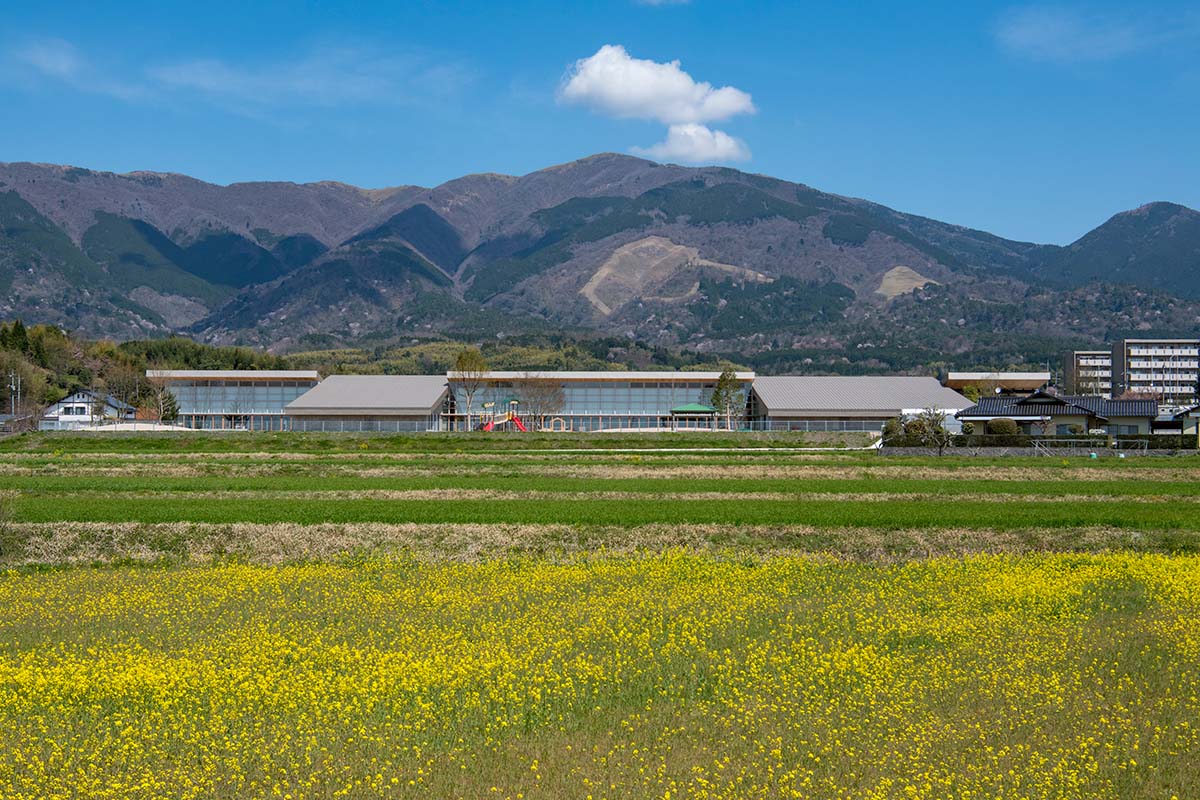
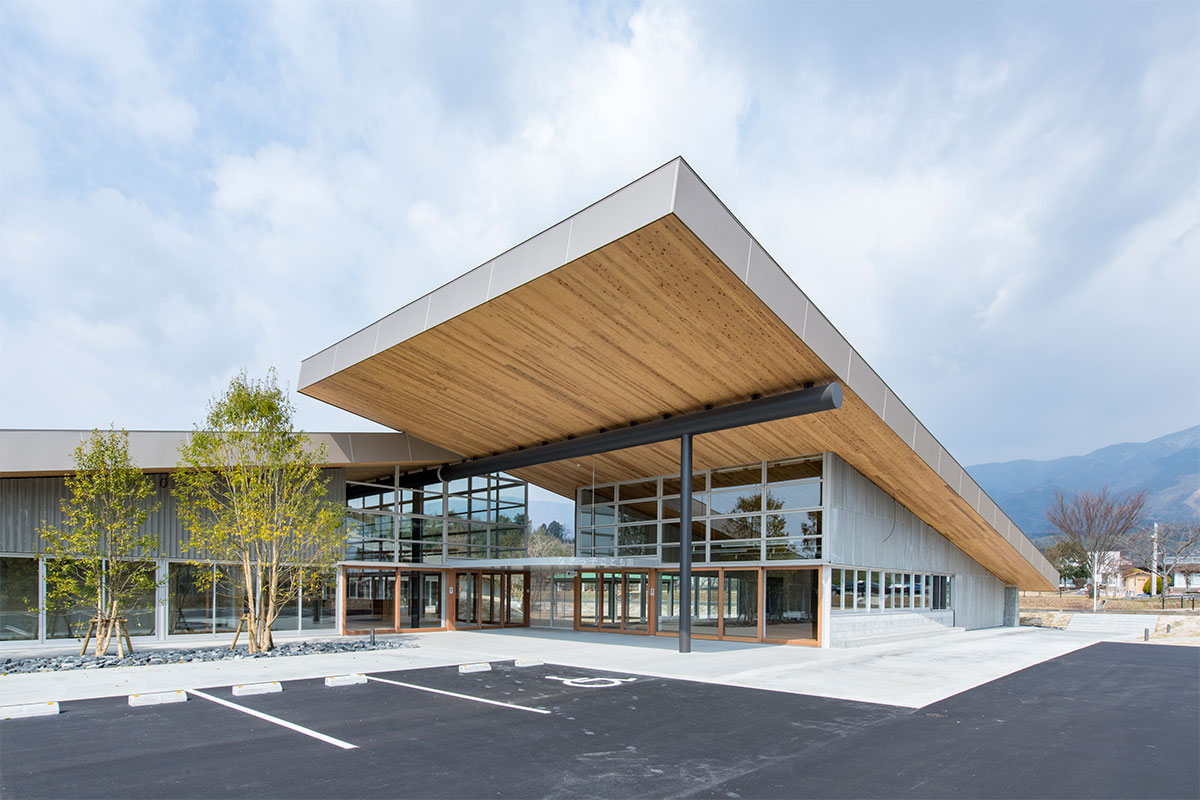
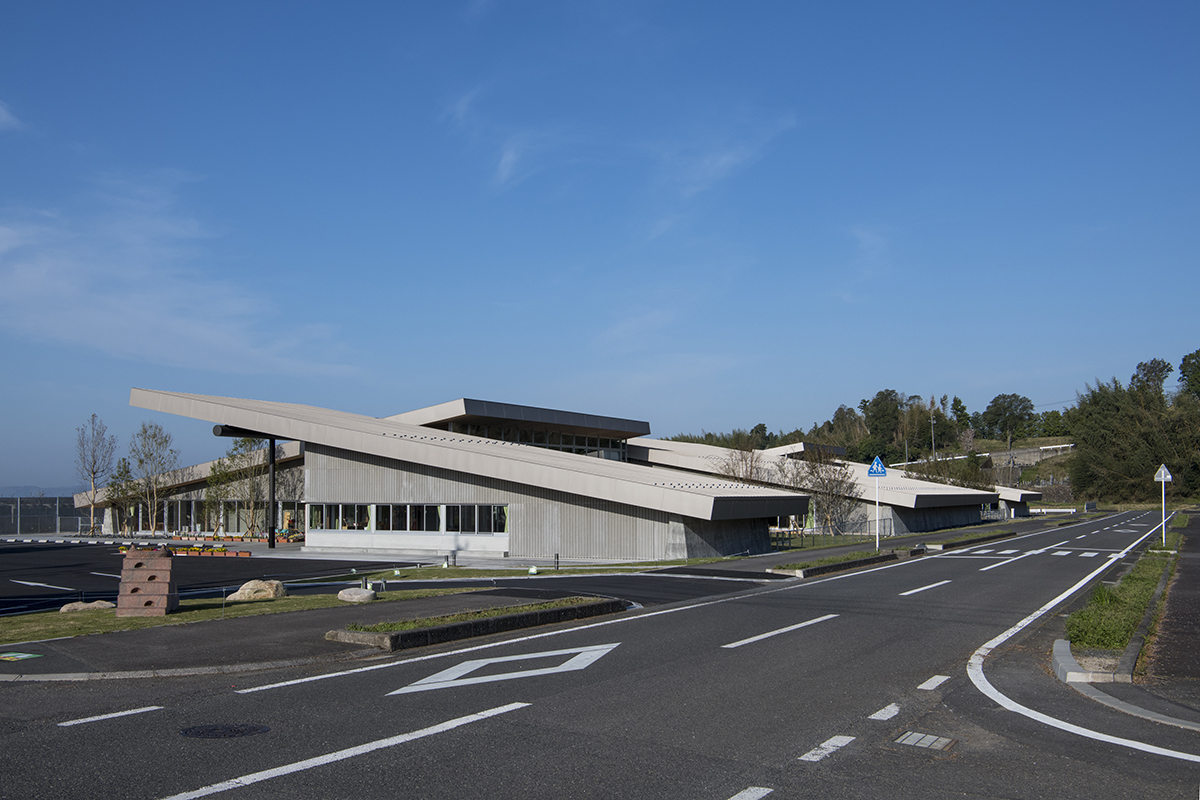
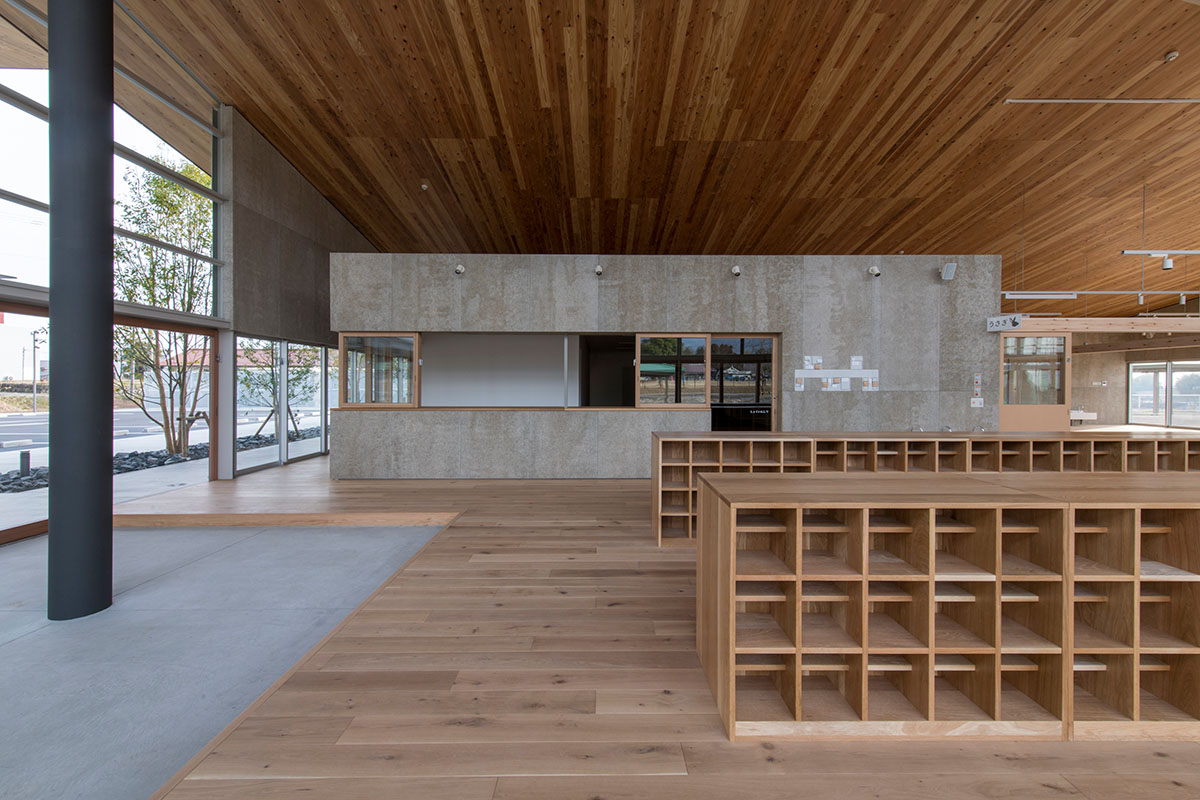

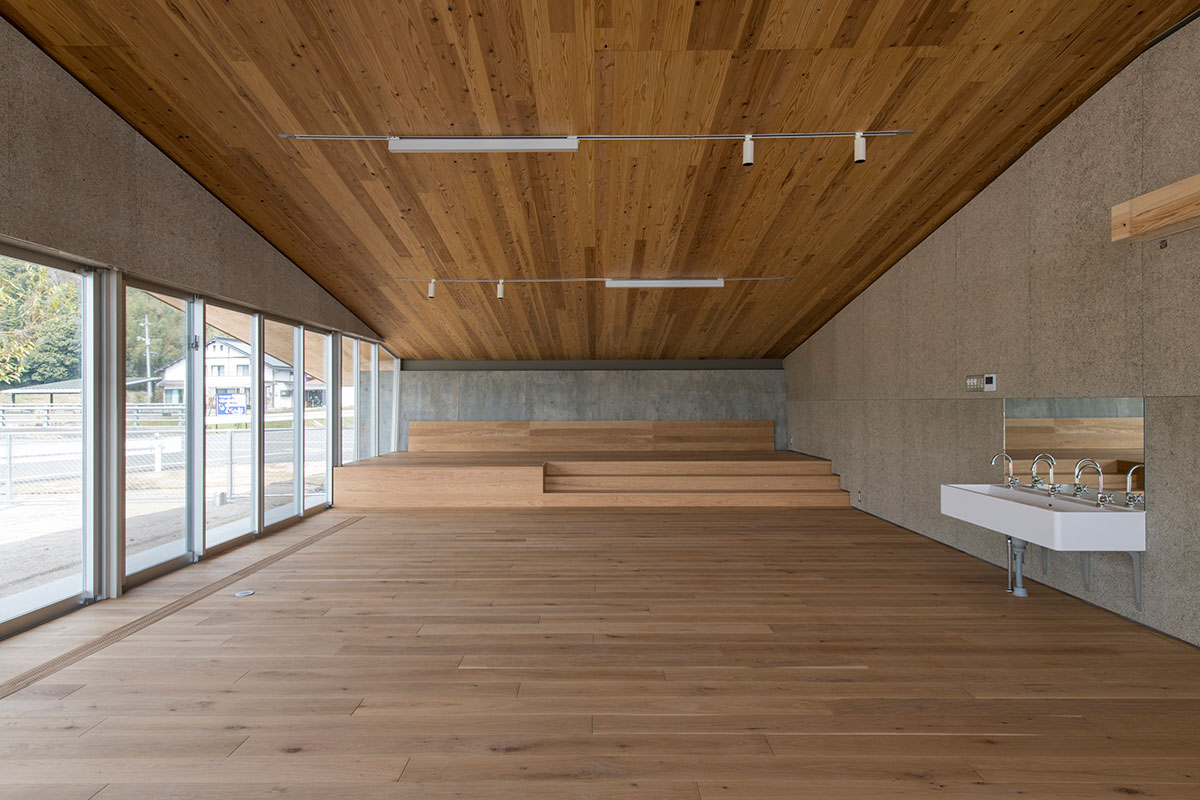
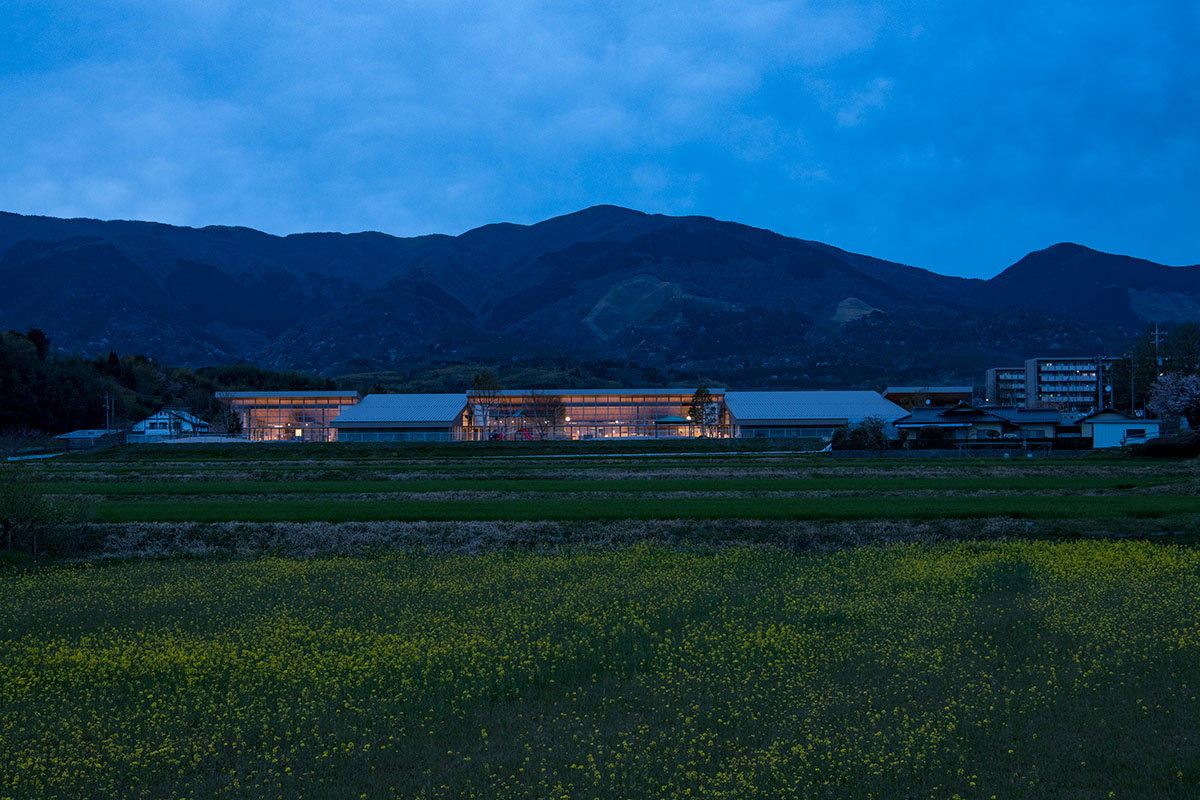
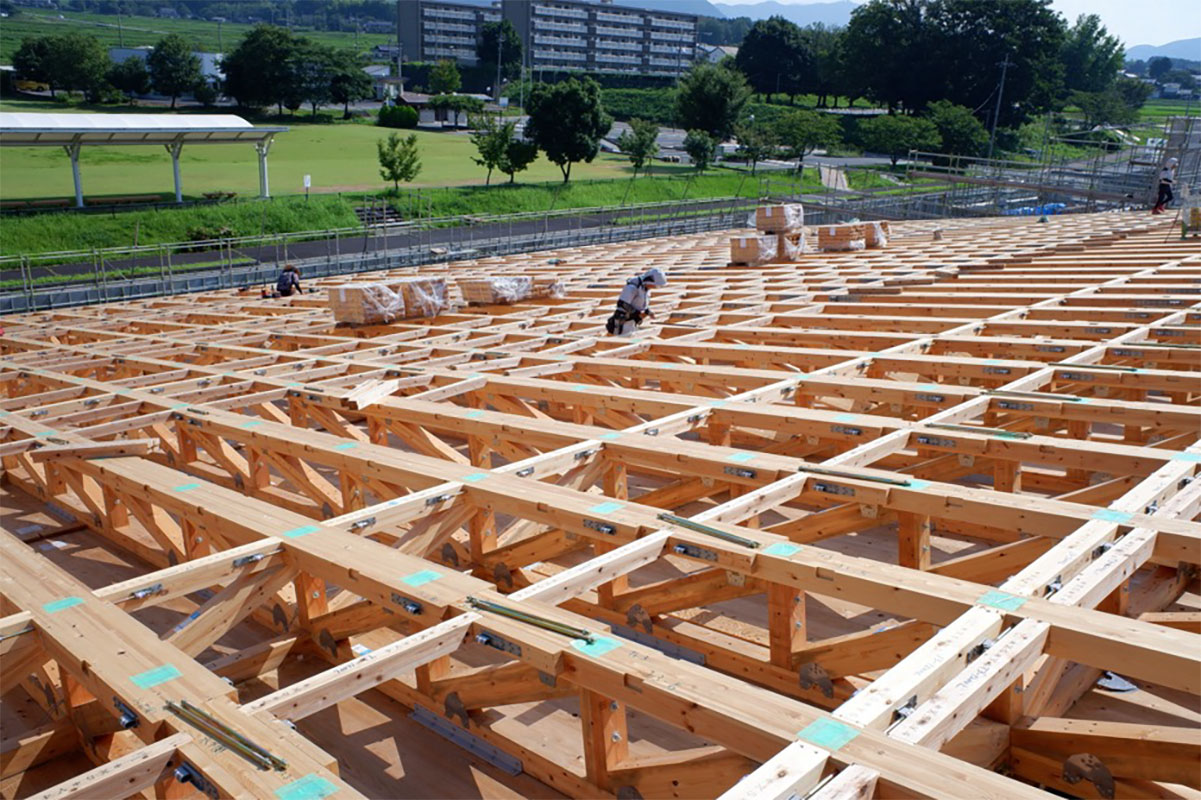



Nagikko Kindergarten / なぎっ子こども園
土地が育てるこども園
南へ向かって緩やかに降っていく斜面には田畑が広がっている.北の方には,平らかな頂が東西に伸びる那岐山が,町の背景のように控えている.岡山ではあっても内陸山間部であるため比較的雨量は多く,地域では「広戸風」と呼ばれる強風が,特に夏の終わりにかけて,土地の上を速く走る.秋には濃い霧が地面を覆い,冬場には積雪もある.町はそんな変化の大きな自然環境の中,それを拒絶するわけでも,逆に受容し切るわけでもなく,ほどよく均衡するように,土地と社会が重なり合っているような印象を受けた.子どもたちは生の自然と直に接していることで,健康な身体を手に入れるだけでなく,量と質を備えた多様な情報を日々得ているのだろう.東京から出向く度に羨ましく感じ,そんなところにも全国一の出生率の理由があるのかと考えたものだった.
町が,それまで町内に3園あった教育・保育施設を統合する0~5歳児までを対象とした幼保連携型認定こども園を構想し,2019年のプロポーザルの結果,私たちがその設計を担うことになったのだが,最初に考えたことが,先に述べた町の印象を拡張したような「奈義の土地」そのものが子どもたちを育てるような施設である.
ランドスケープ的建築/建築的ランドスケープ
見出したのは,東西に伸びる「鉄棒」のような鉄骨造の架構列に,南北から交互に建て掛けるように配された数枚の大きな「木版」,という単純な形式である.
屋根となる木版は並置される集成材によるトラス梁の下弦材をCLT板として一体化したもので,その確かな面内剛性によって横力を水下側の鉄筋コンクリート壁体に効率よく伝えるため,鉄棒は垂直力だけを支えれば済み,プロポーションはスマートである.
鉄棒に沿った中心軸には「なぎみち」と名付けられた長さ100mほどの通り状の空間が生まれ,それを挟み込むようにしてひだ状に,木版下の保育室や遊戯室等を配した.「なぎみち」はまさに「道ばた」のような,前もって用途の定められない自発性を発露する空間として使用されるのと同時に,両側の保育室に収まりきらない活動を補完するバッファ空間でもある.
そこに両側から接続する保育室等は中心から端へ向かうにつれて天井高は低くなり,なぎみち側の明るく活動的な大空間から,しっぽりとした暗がりの身体的な小空間へと連続的に変化していく.どう使うのも自由な「なぎみち」も含めて,子どもたちは土地を解釈するようにして,活動や気分に即して時々に,自分の居場所を発見していくことになるだろう.
奈義の自然を引き込んだような庭を複数生み出す「内外が入れ込んだひだ状の空間構成」も,雨天時には子どもたちの運動の場ともなる庇下の「なぎみち」が屋内外を繋ぐ「縁側的な中間領域」であることも,これらはすべて奈義の土地と子どもを近付ける建築的な工夫であるが,むしろ振り返れば,半ば奈義のランドスケープの一部としてデザインしていたようにも思えてくる.
イメージ・ネットワークとしての風景
完成したこども園は,東西に棟を伸ばすその姿によって背後に控える「那岐山」のようでもあるし,この地域の収穫期の田浦に見られる「ハサ掛け」のようでもある.あるいは,広戸風を避けようと低く伏せられた屋根型は周囲の切り妻屋根の「おうち」のようでもあり,ある人は指先を軽く組み合わせた「母の両手」のようだとも言っていた.隣接する奈義町現代美術館の別館のようだともしばしば言われる.ただひとつの幼保施設へとイメージは収斂せずに,スケールもさまざまな地域の風景と,次々に連想のリンクを結んでいるのである.町の風景/ランドスケープとなる建築は単一のイメージを押し付けるのではなく,住民それぞれの解釈を喚起し,土地ならではの要素と無数に結ばれることで,土地のイメージのネットワークを深め強化するものなのかもしれない.奈義町の子どもたちが,フィジカルにもイメージでも土地と強く結ばれることでその恵みを存分に受け取り,元気に育ってくれることを望んでいる.
ー
「新建築」2024年5月号
data:
主要用途:幼保連携型認定こども園
敷地面積:8,635.22m2
建築面積:2,806.12m2
延床面積:2,636.19m2
階数:地上1階
構造:鉄筋コンクリート造+鉄骨造 一部木造
principal use:kindergarten for preschool and kindergarten for elementary school students
site area:8,635.22m2
building area:2,806.12m2
total floor area:2,636.19m2
number of stories:1 story above ground
structure:reinforced concrete + steel frame, some wood
photo credit:
Ryota Atarashi / 新 良太

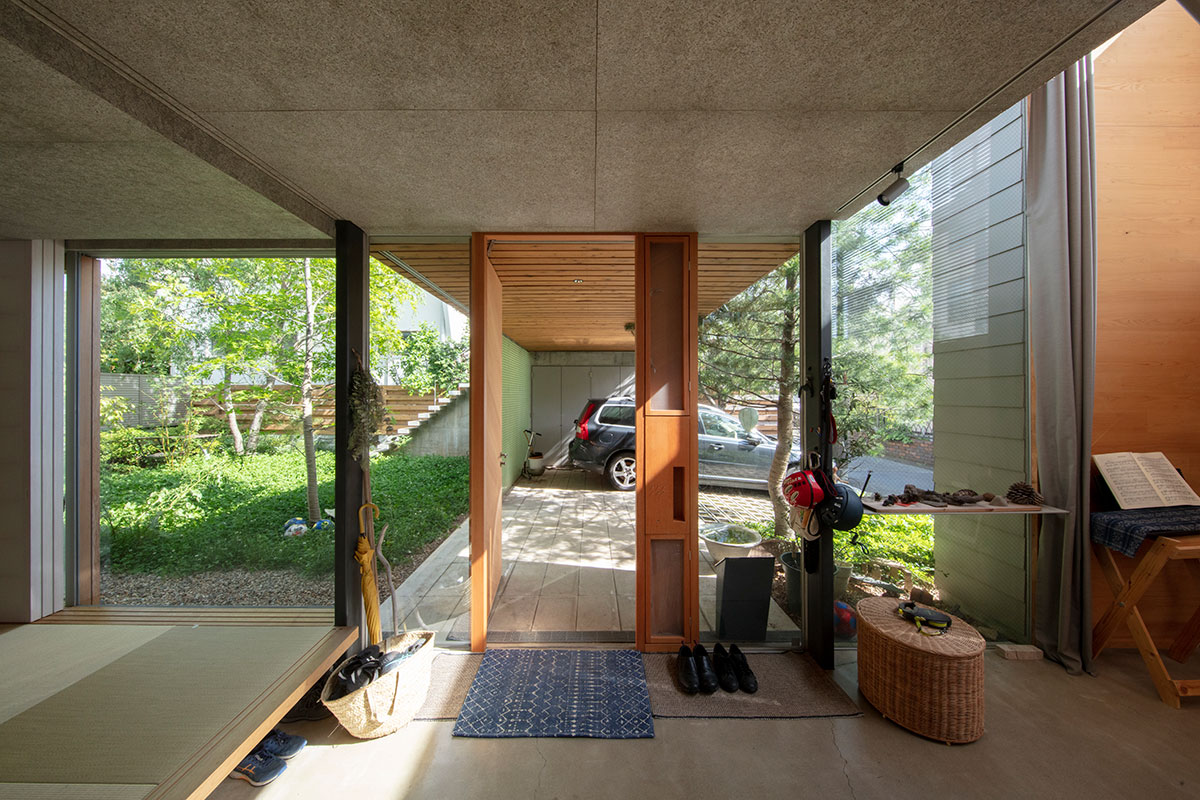

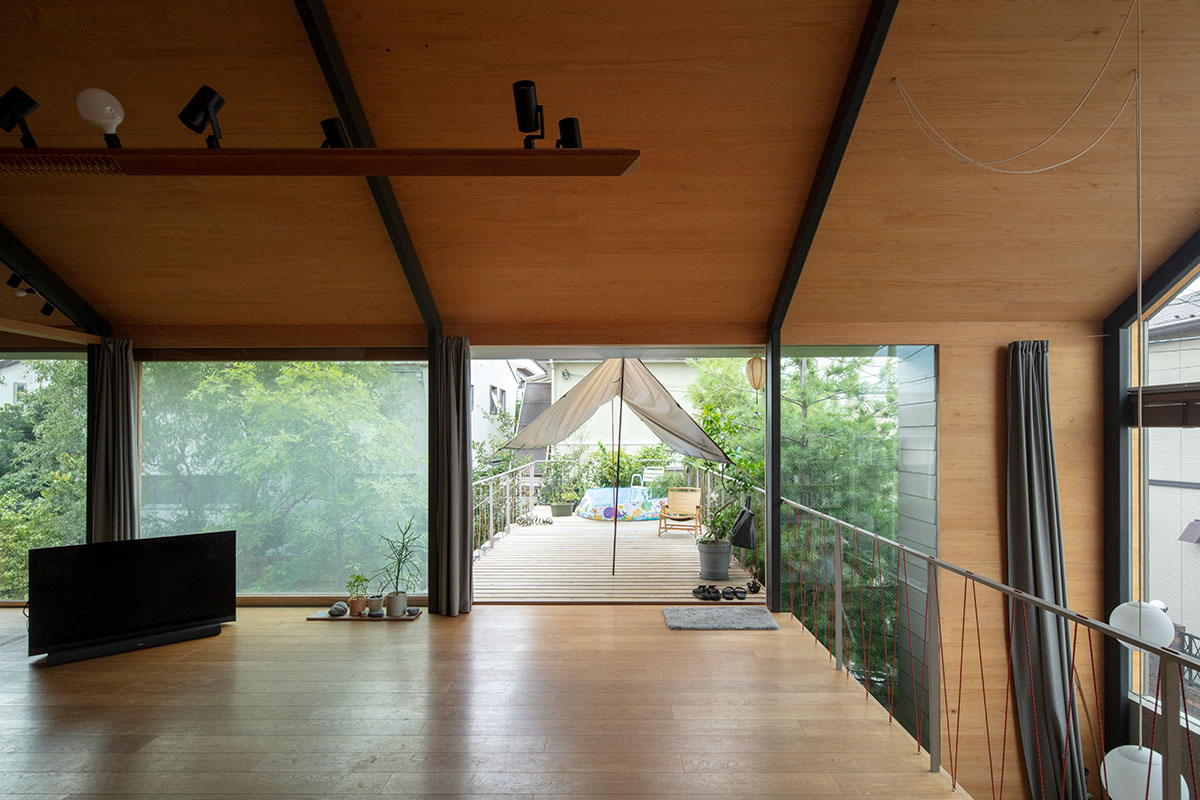
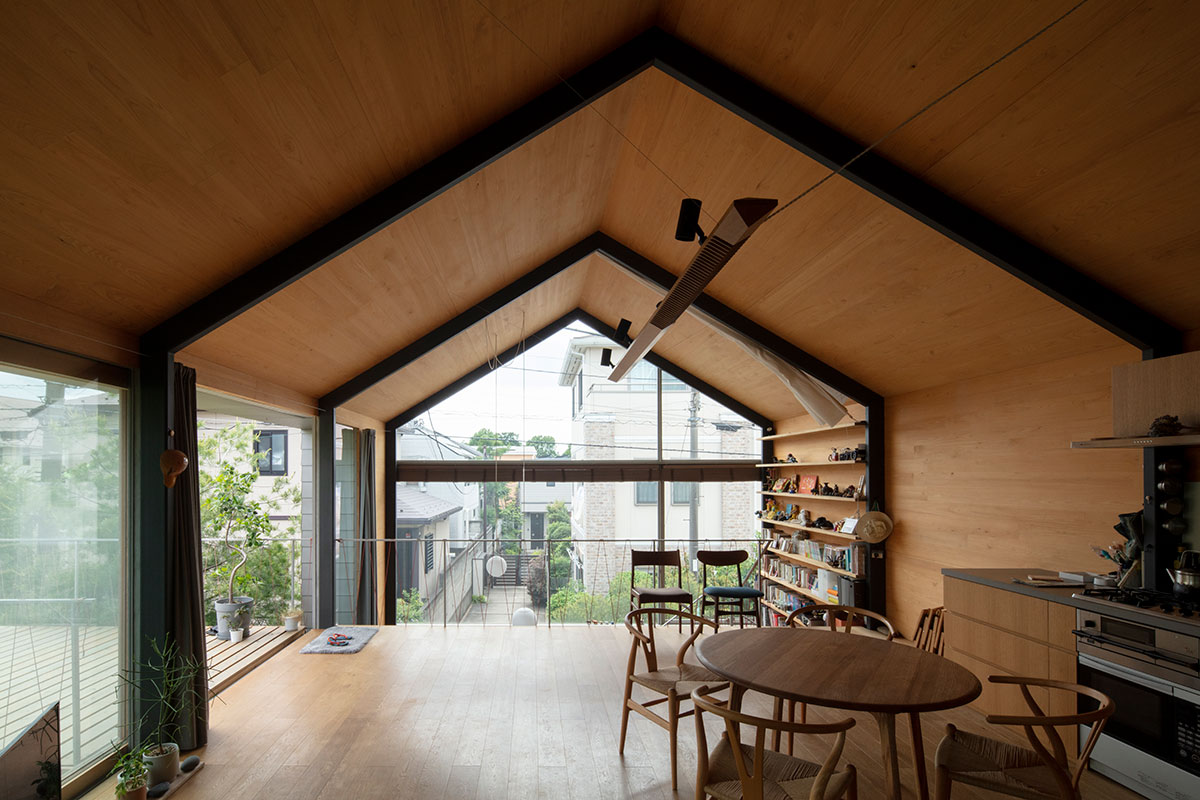
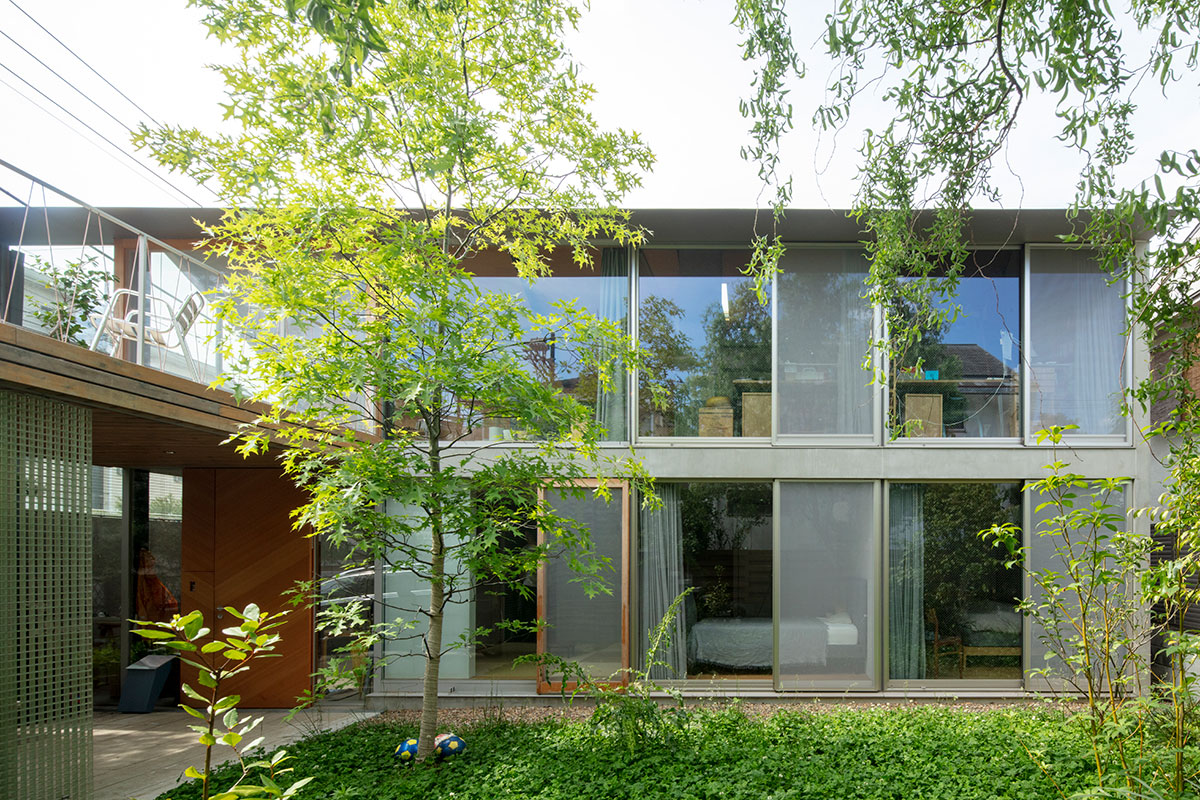
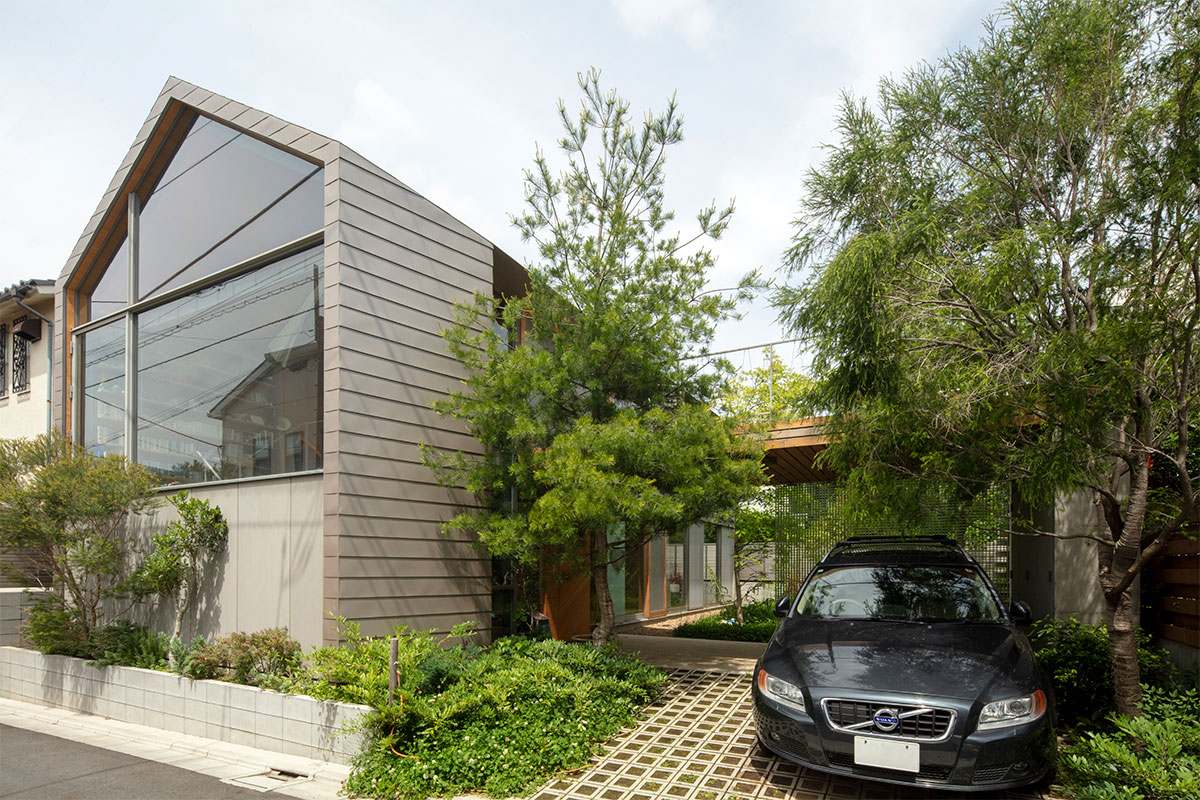
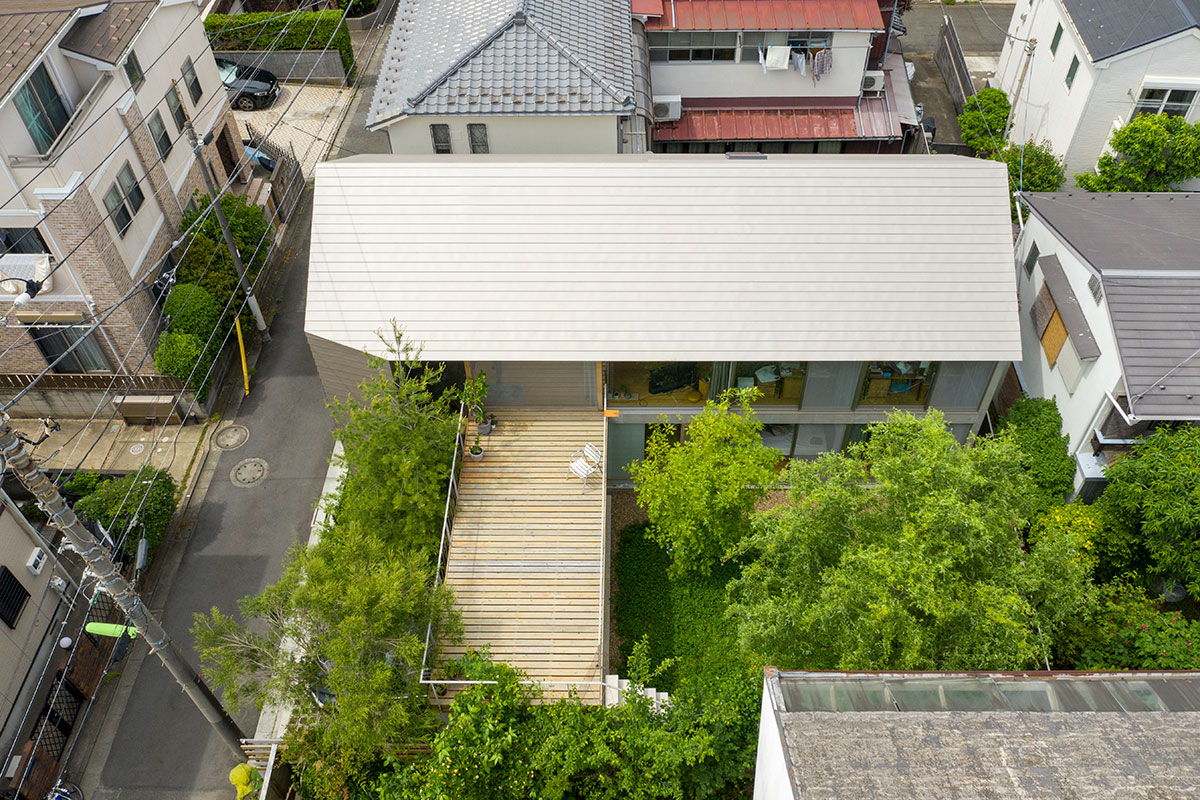
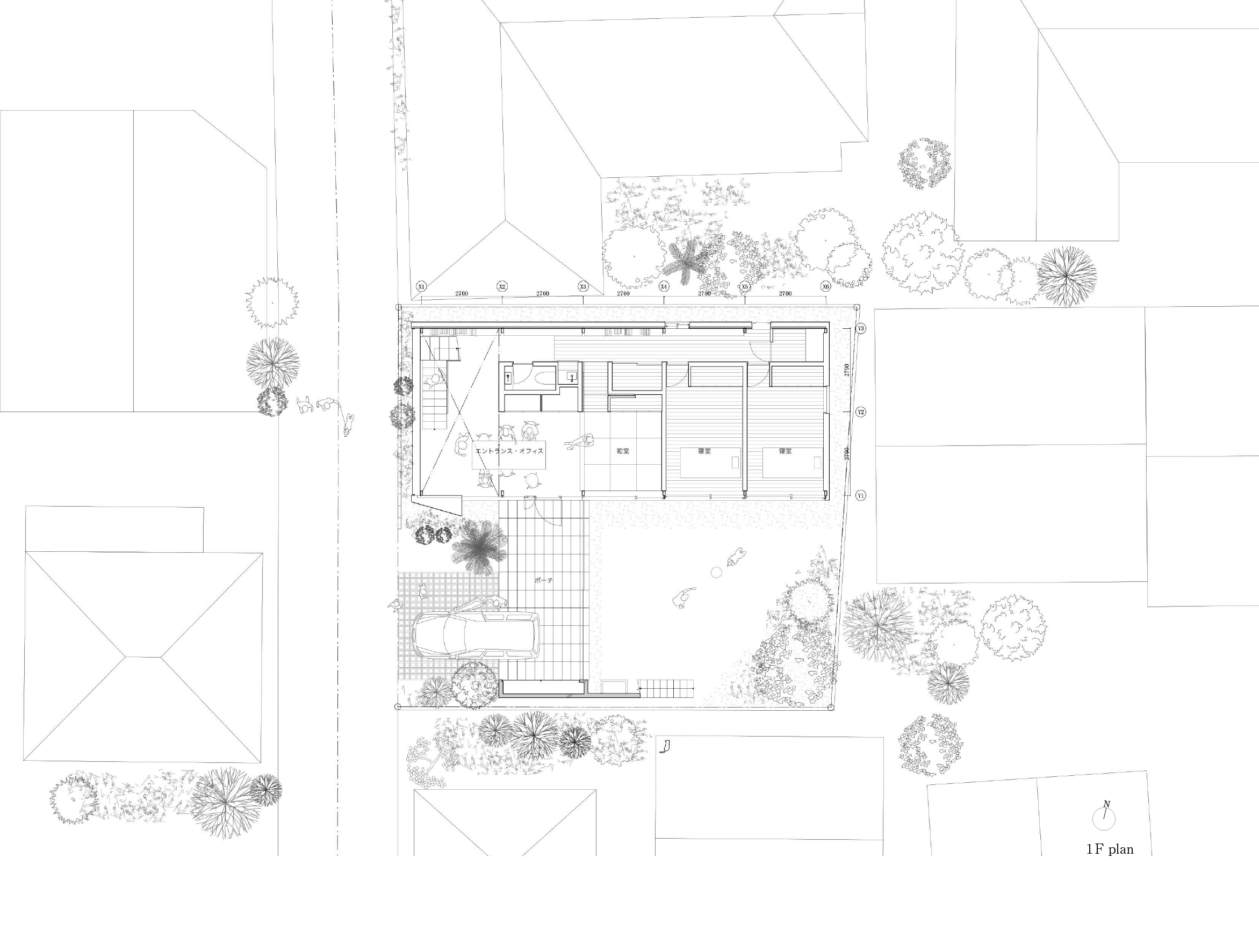

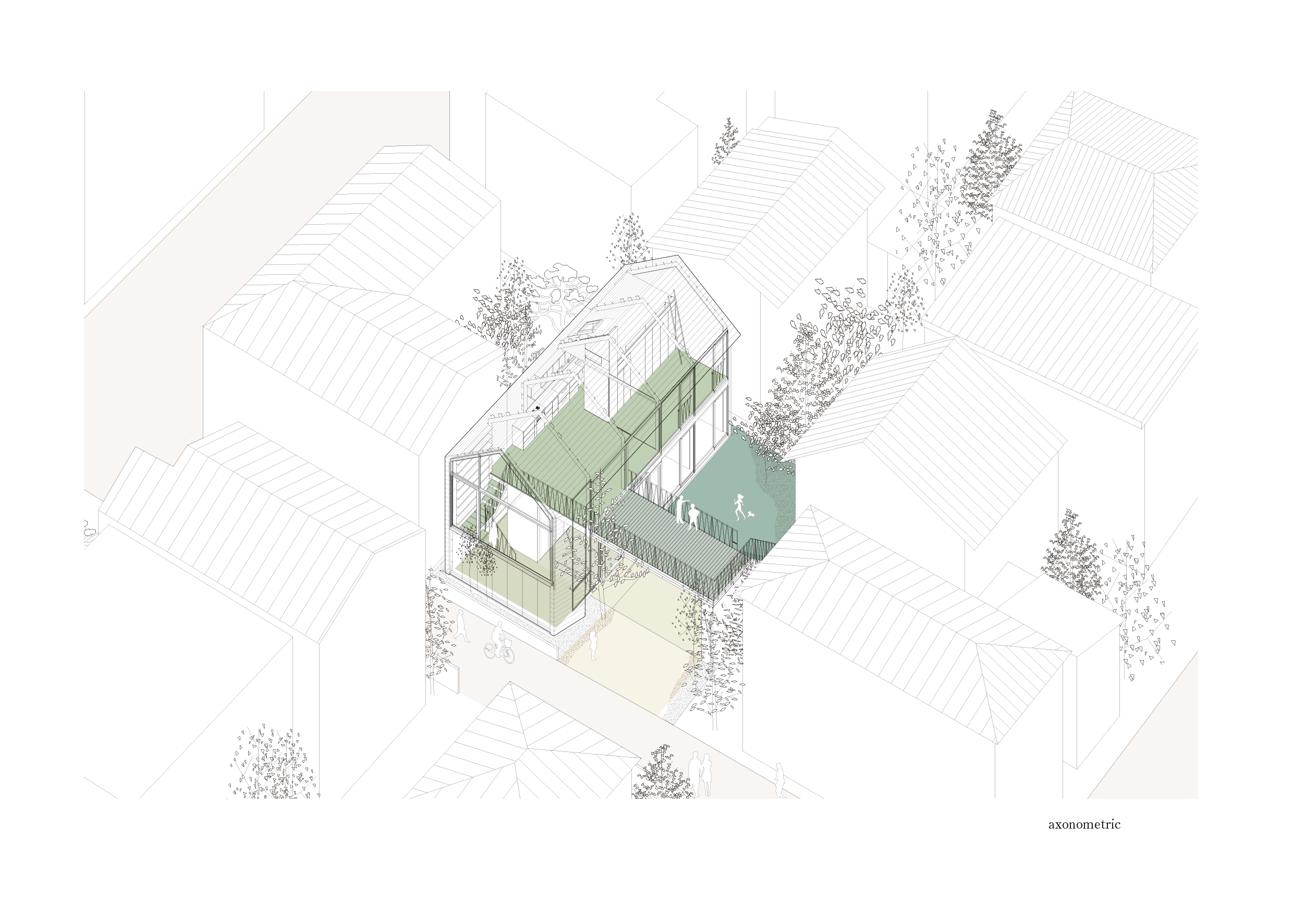
Primal House / 素地の家
住まいと成していく住まい
よく山を歩く。見晴らしのいい高所から遠くを眺めるのは登山の大きな楽しみだが、道中の、目の片隅に入ってくる山の近景の様相を見ることも好きだ。春先の雪の残る森なら木立の立ち上がった根の窪みに雪風から守られたひと晩のビバークを思うし、雨がちな夏山なら、オーバーハングする岩の下に雨に濡れない快適な寝床を想像する。クッションがありそうなハイマツの上もよさそうだ。
何を見つけ喜んでいるのかというと、住まいの可能性とでも呼ぶものだろうと思う。何しろ、倒木の狭間や高い位置の股木の付け根に、オコジョやモズになった気分で巣に適した環境を見出しその後の営巣まで想像してしまう。住処となり得る可能性を環境の中で見出すこと、そして、それに手を加えることで住まいと成していくことは、生物の、そして特にHomo Faber (工作人)である人間の基本的な本能であり、歓びなのだろう。
見出し、成していく、住まい
そもそも住宅という機能は副次的なものだ。生き物にとっての倒木の隙間や木の又などはもちろん、洞窟住居や立木を掘立て柱とした初期の住居建築でも既存環境の副次的なものとして住機能を見出していたし、さらには何世代も使い継いでいく民家や町家などの建築では、住まい方は当然として、時には機能さえも使用者の入れ替えごとに更新されるわけだから、いつもその時どきの新たな住まい手が、その住宅建築の1次的な成立要因であったことはなく、ある種、副次的といえる。
このように住宅には、程度の差こそあれ、常に既存環境から住まいを見出し、住宅と成していくという、副次性があるのは当然なことなのだろう。むしろ、二十数年程度の寿命しかもたないために、時どきの一般的な暮らしの様式にプリセットされた住宅として与えられるという、この国の近代以降の住宅供給の状態こそが特殊だ。
住まいの「素地」
だから住宅というものも、もうそれ以上手を加える余地のないように完璧にセットアップすることや、あるいは住まい手の行為を作品の意図通りに固定する状態というよりは、よい住まいの可能性というのか、住まいと成したいと思われる基底的な「素地」として手渡したい。それは、代々の住まい手が後に手を加えても失われることのない普遍的強度と、逆にだからこそ得られる変化への「物理的・心理的な鷹揚さ」を有したものとしておく必要があるとも考えている。
それは、われわれの最初の住宅作品である「おおきな家」(本誌0608)で、住まいとしての初期状態を「空間」とそれを成立させる「物質」の、それぞれの根源的な価値である「大きさ」へと還元し保証しようとしたこと。そして、空間の構成や物質の構築というマクロな位相と、素材の肌理や細やかなプロポーションといったミクロな位相は吟味するように集中してデザインしつつも、その中間スケールの領域は敢えて手放し、住まい手に委ねてしまうといった方法などに連なるものだ。
重なる構築性ー自由な改変を許容する構造
この自邸でもそんな、住宅となる以前の、よい住まいとなり得る可能性素地のようなものとして、設計を行うことを考えた。
具体的には軽量鉄骨(75×150mm, t=6mm)による家型の柱・梁フレームを2,700mmピッチで並べ、これを厚さ60mm(t=20mm×3プライ)のCLTで包む筒状の形式を開発した。CLTは両肩の柱梁ヒンジ部と棟のヒンジ部で折れるので折板効果のある桁行材としても機能しているけれど、どちらかというと、テクトニックなフレーム構造とステレオトミックな壁(面)構造が重なったような構造形式と表現した方がいいかもしれない。この構造形式の「重なり」は、ある特定ケースの構造としては冗長ではあるが、フレーム構造と壁構造の両形式が互いに補完するように機能することで、それぞれ単独では獲得しづらかった、妻側・平側を問わず位置・量共に制約のない開口の可能性や、自由な床スラブ配置などを実現した。さらには無垢な木材であるCLTがどこでも構造的手がかりとなるので、モジュールに束縛されない自由で容易な部材取り付けを可能にすることなど、計画時の基本的な融通性と居住後のカスタマイズの自由度を、構造的健全性を確保したままに保証するものになった。
素地を街に落とす
次にこの構築のシステムを敷地周辺環境にざっくりと応答させる。
まず、その単純な素地である筒状の躯体を東西に長軸を取り敷地の北半分に置く。その出口は西を向き、西側空地とその奥の近隣公園の高木の景観を取り込み、南側は種々の樹木を植え込んだ庭とするので、こちらにも大きな開口を設けるという基本的な構えを取った。この後はカスタマイズの初期段階になる。先の構えに対して直交するように南北に細長いテラスと、その下に庭と街を仕切るFRP製グレーチングの可動壁を付加的に取り付けることで、基本的に私的領域と街を切り分け、次に上下階に関係が生まれるように西側の2階床を抜いてしまう。そうして、前面道路に面するテラス下からエントランス、吹抜けのセミパブリックなSOHOを介し2階のリビングエリア、さらにテラスから外階段を降りて、プライベートな庭とそれに面する寝室へと繋がるシークエンスを設定し、街と私的領域の間にグラデーショナルなパブリック~プライベートの階調を生み出したところで計画段階での操作は留めることにした。ウクライナ民話の森に落とされた「てぶくろ」が近いか。その後の住まいらしくしていく諸々の調整は、居住後のカスタマイズに引き継ぐことにしたのである。
終わらないプロセスの始まり
この時点での自邸は、先の山歩きの中で見つけた木の洞のようだ。頑丈で暖かく、敷地周辺へと見晴らしが効きながらも見られることはなく、全面が木でできているから住まう中で好きなように手を加えることもできる。私たちはこの可能性としての住居を、住み込む過程で、世代間で受け渡しながら住まいへと成し続けていくのだろう。その初期条件、可能性としての素地が十分であるかどうかが、建築家としての私の住宅設計についての関心ごとなのだ。
発見し住居と成していく日々の時間、つまり共に住まうもの同士で手間と暇をかけるプロセス、こそが住宅の本体なのだろうと、最初の住まい手としての私は、覚悟しつつ、楽しみにしている。
ー
「住宅特集」2023年2月号
data:
主要用途:住宅
敷地面積:198.97m2
建築面積:97.71m2
延床面積:141.45m2
階数:地上2階
構造:鉄骨造+木造 一部鉄筋コンクリート造
principal use:private residence
site area:198.97m2
building area:97.71m2
total floor area:141.45m2
number of stories:2 story above ground
structure:steel construction + wood construction partially reinforced concrete construction
photo credit:
TakuHata/畑拓














STROOG社屋
ドミノから、次のシステムへ
空間的にも時間的にも、アウトラインのない建築のシステムはできないだろうか、と考えてきた。
もちろん私たちにはドミノ・システムという、どこまでも拡張可能で、産業構造を含めて広く普及した思考と構造の方法があるのだが、あの自由と言いながらもグリッドモデュールという絶対的な基本単位が存在していることには、人間を均質的に捉える思考がその基礎に据えられているようで、カタにはめられる気持ちの悪さというのか、違和感を消し去れないでいる。
アウトラインを持たず、グリッドモデュールからも自由な空間的・構築的なドミノに代わるシステムはないものか。そのヒントになったのは、このSTROOG社の代表の自邸である「立山の家」と、その展開である「LIAMFUJI」になる。この2つの仕事は、共に壁面を一枚で形成するほどの大断面集成材で作られていて、その巨大な壁=梁による十分な曲げ応力と、これも十分なスタンス幅による鉛直方向に剛な接合によって、上下層で構造がグリッド状の「通り芯」から自由になり、その結果、空間もまた断面的に新たな関係で接続されることになった。これらの時点では、平面的にはグリッドが踏襲され、空間システムも完結していたので、これをほぐし、時間的・空間的にアウトラインのないシステムへと向かうことを考えた。
STROOG本社でとったのは、長さはまちまちの幅3000mmのCLT原板を複数用意し、これに任意に切り込みを入れ、井桁状にノックダウンするように組み上げる方法である。CLTは直交積層合板という和名の通り直交する2軸に強軸を持つため、どの部位も鉛直に抵抗する柱と水平に抵抗する梁の性質を両有し、なおかつ無垢材であるので切り込み位置はミリ単位で自由になる。これと切り込みの噛み合い深さがそのまま接合スタンスとなってラーメンが成立する構造的合理性と合わせて、立体的にグリッドモデュールに束縛されないシステムが成立する。またアウトラインは完結せずに、ほつれるように空間的・時間的な余地へと解放されているので、生命体のように場面場面で必要性や環境の変化に適合しながら、どこまでも成長していくことも可能になる。
そして生み出された建築的空間は、これを現実化したCLTのラミナと同じように、方向性のある空間が直交するように組み上げられ、そのように異方に積層する空間群を、斜めに抜ける関係性が縫い合わせるといった、全く新しい空間性が生まれている。この均質ではない空間の関係性と、CLTの質量の周囲に生まれるアトモスフィアとが重なることで生まれる場所性は、ドミノシステムの持つ均質さとは全く異なる質のものになった。
新しい木材が生む、新しいシステムである。それは、ドミノの普遍性は引き継ぎながらも、より多様な、人の居場所を生み出していく生命的なシステムとなったのではないかと考えている。(原田真宏)
ー
「新建築」2023年1月/新建築社
data:
主要用途:事務所
敷地面積:905.04m2
建築面積:494.02m2
延床面積:499.64m2
階数:地上2階
構造:木造(CLT造)
設計期間:2019年11月~2020年12月
工事期間:2021年6月~2022年12月
principal use:office
site area:905.04m2
building area:494.02m2
total floor area:499.64m2
number of stories:2 story
structure:timber(CLT)
design:2019.11 - 2020.12
construction:2021.6 - 2022.12
photo credit:
Ryota Atarashi / 新 良太














ROVAL
鉄の森
大阪府枚方市を敷地としたROVALの新社屋兼発送センターの計画。同社は常温亜鉛めっき塗料の国内最大手メーカーであり、社屋はその製品性能の実証実験を兼ねるため、鉄を主体構造とすることが求められた。効率的な管理のため発送センターとオフィスは同じ空間の中に併置されることになったが、発送センター向けの大スパンを基準として、一般流通規格の重量鉄骨型鋼によって従来型の格子状の架構を設定すると、人間のスケールと構造のそれとがどうにも合致せず「社員の方々が日々を過ごす就労時間を豊かなものとしたい」という社長の思いに応えられるようには思えなかった。そもそも一言でオフィスと言っても、そこでの行為の質も様々であり、それらに随意にフィットしようと思うと格子状構造の一律さはもとより、型鋼の規格の割り付けも段階が荒すぎるようだ。
そこで発送センターとしての大モジュールから、細々と設定すべきオフィスのモジュールまで、スケーラブルなモジュールを可能にする構築/構成のシステムを求めることにした。
それは型鋼ではなく、スチールプレート(St-Pl:鋼板)を用いたものだ。St-Pl:16mmをレシプロカルに組み合わせた単位を基本とするが、そのサイズ・縦横(X /Y)比は、オフィスのアクティビティや発送センターの空間の必要性に応じて様々に変化し、それにつれて高さ(Z)もまた力学的に応答して変わることで、場所性にさらに多様さを加えている。各プレートは両端をピンとなる接合として単純梁とし、プレート上辺は直行する角パイプ列(150×150×4.5@600)で拘束されることでcut-T的に適当な構造として機能する。また柱は基礎と一体となったRC造片持ち形式で、レシプロカル単位の中心に生じる四角形で掴まれ架構と接合されるが、時にレシプロ中心の四角形は柱型より大きく、その隙間は熱抜きを兼ねたトップライトとなって自然光を取り込んでいる。
STROOG本社に続いて、モジュールフリーでオープンエンドな新しい架構システムの探求である。求める空間の質の多様さに始まり、それに応じて架構が変化し更に場所性が揺らぐその有様は、ところどころに落ちる木漏れ日のような光や、それぞれ幹から差し伸ばされた枝のような梁の形態的な効果と相まって、“鉄の森”のようにも映る。自然の森と同様に、この無機質な森もまた、人々にどこに居てどう使うか、つまり主体的な解釈を促し続けることになるのだろう。
ー
「新建築」2023年5月/新建築社
data:
主要用途:事務所、研究所、倉庫
敷地面積:5746.91m2
建築面積:1182.01m2
延床面積:1639.67m2
階数:地上2階 塔屋1階
構造:RC造+一部鉄骨造
設計期間:2018年12月~2021年6月
工事期間:2021年6月~2023年1月
principal use:office, laboratory, warehouse
site area:5746.91m2
building area:1015.37m2
total floor area:1182.01m2
number of stories:2 story
structure:reinforced concrete, steel
design:2018.12 - 2021.6
construction:2021.6 - 2023.1
photo credit:
Ryota Atarashi / 新 良太








STROOG LAB
data:
主要用途:試験棟
敷地面積:563.52m2
建築面積:237.07m2
延床面積:449.69m2
階数:地上1階
構造:木造(CLT造)
設計期間:2020年6月~2020年12月
工事期間:2021年6月~2022年12月
principal use:laboratory
site area:563.52m2
building area:237.07m2
total floor area:449.69m2
number of stories:1 story
structure:timber(CLT)
design:2020.6 - 2020.12
construction:2021.6 - 2022.12
photo credit:
Ryota Atarashi / 新 良太
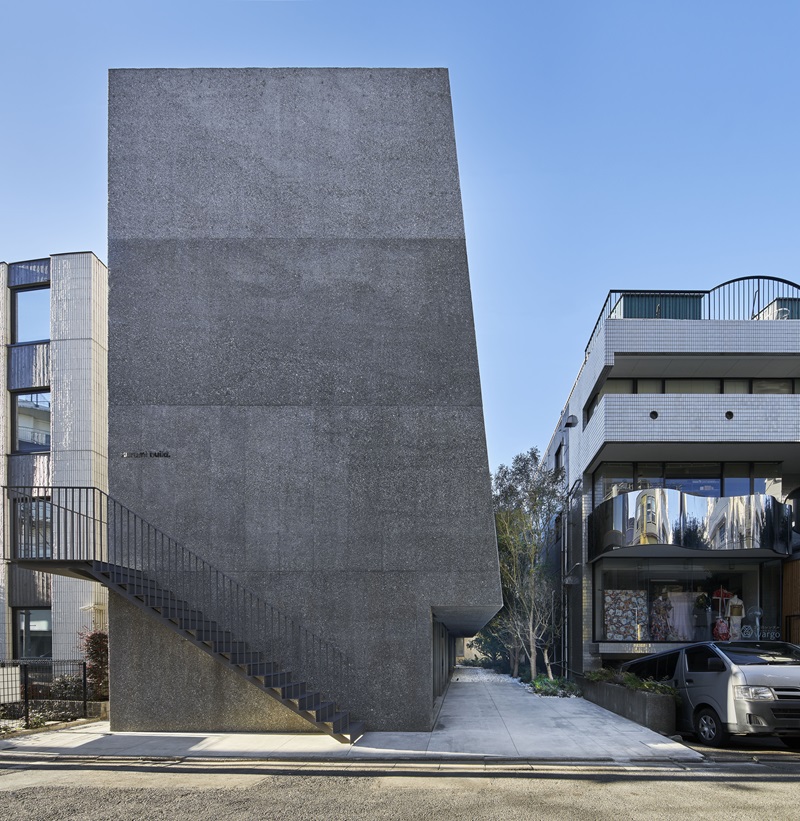
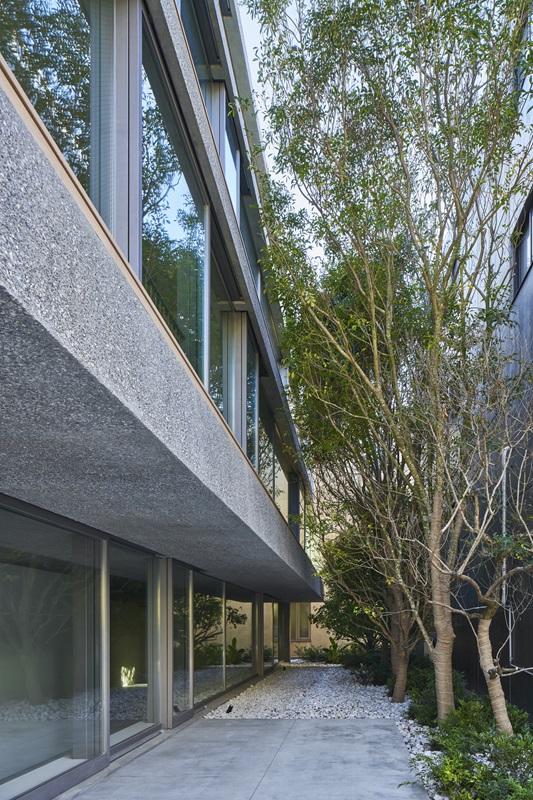

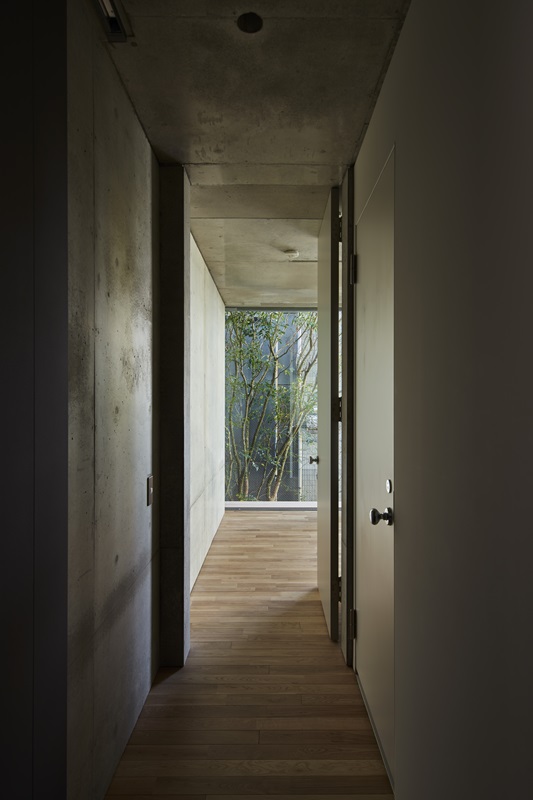
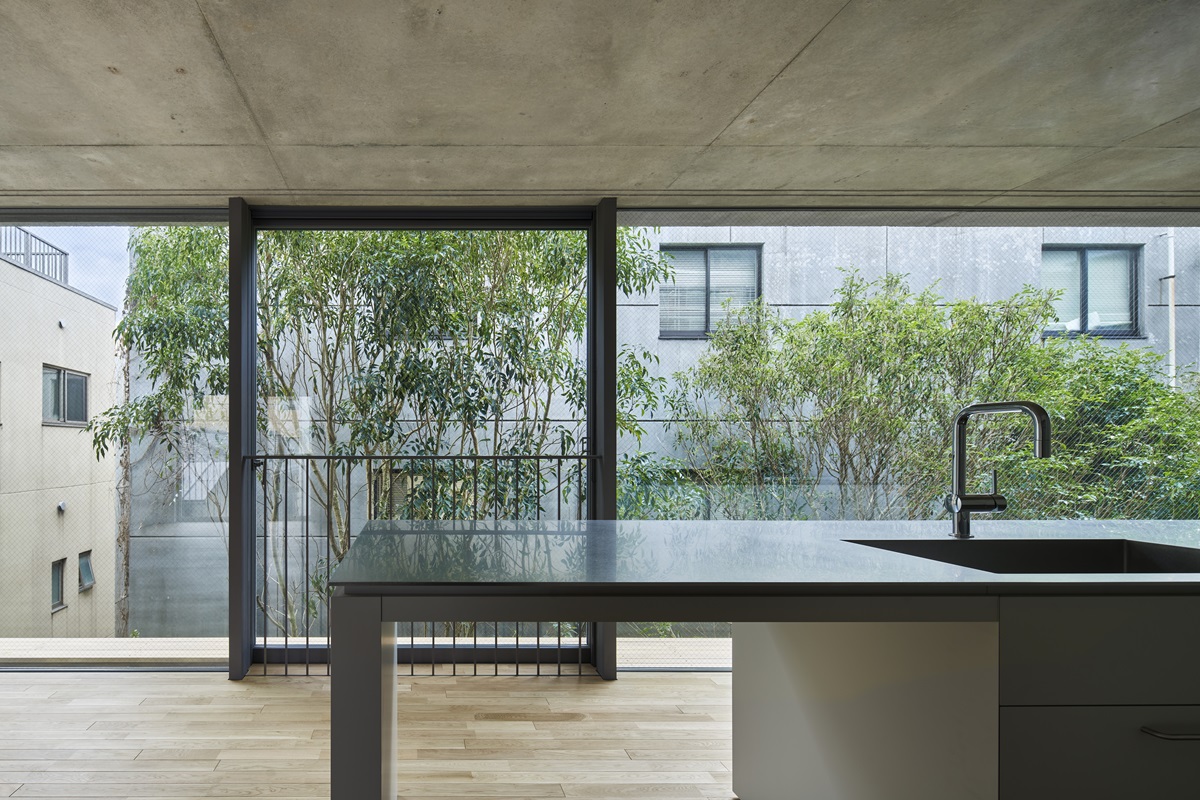
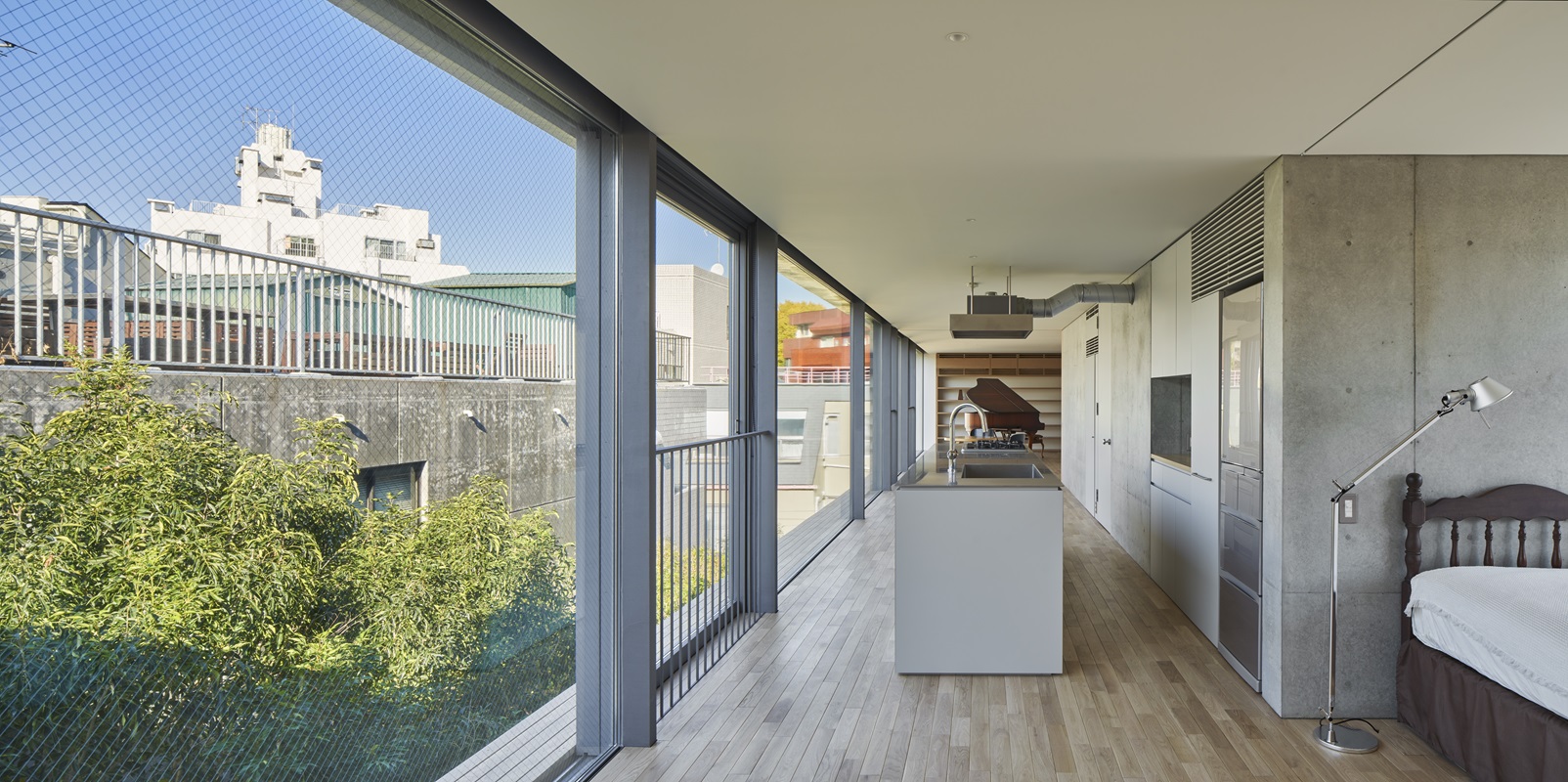
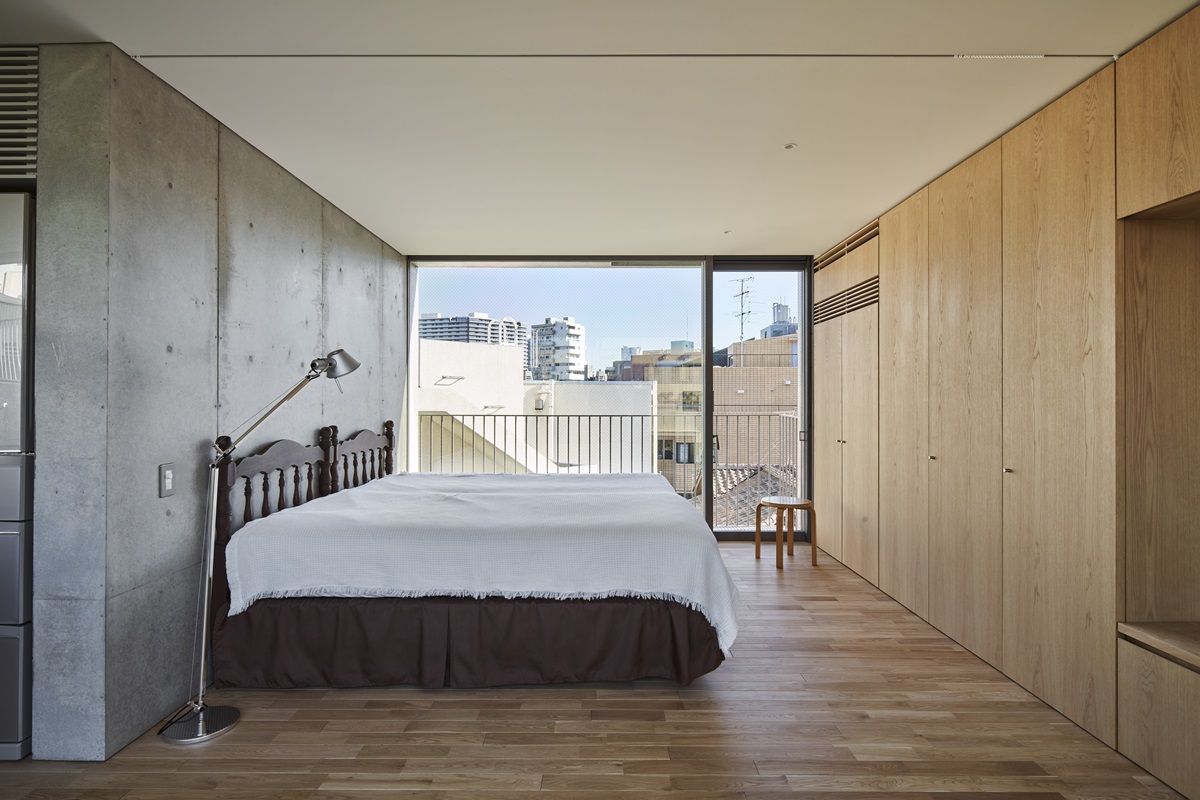

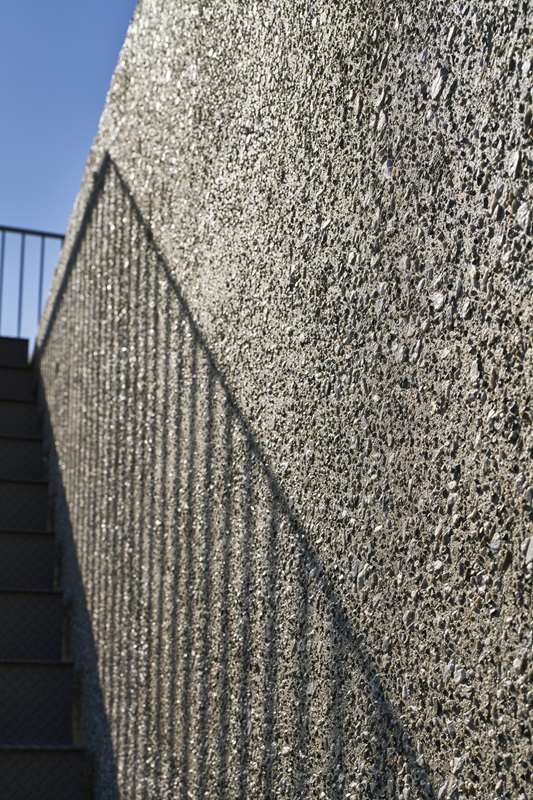

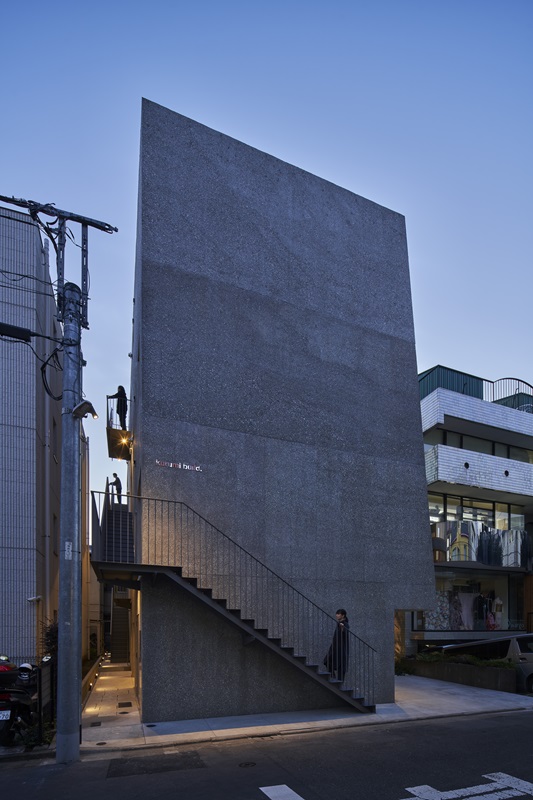
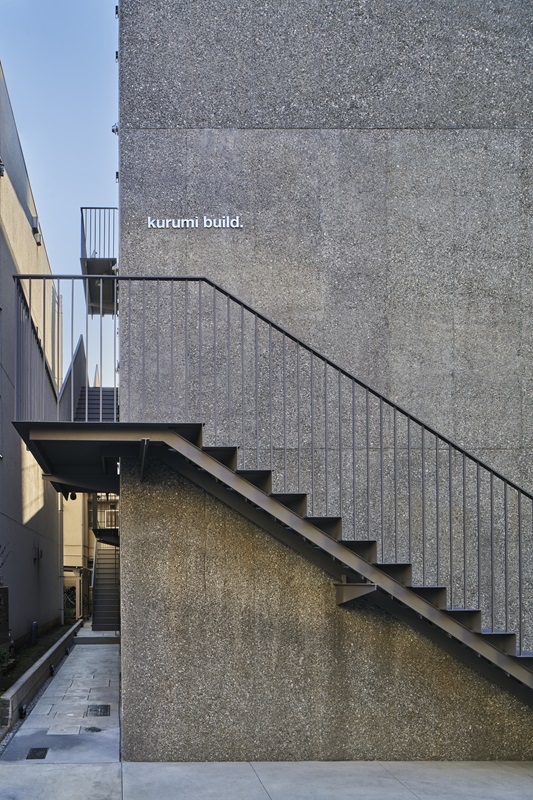
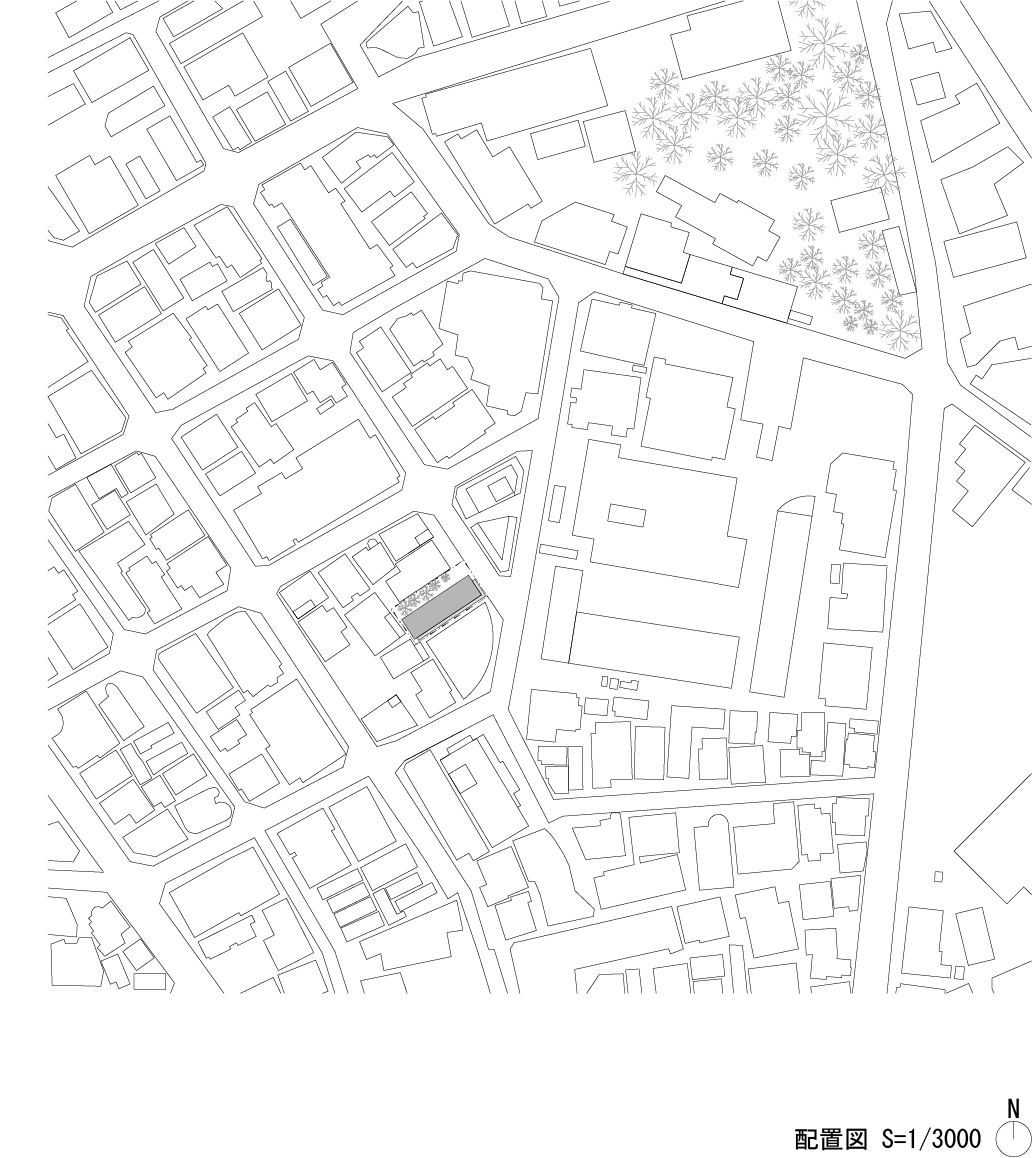


KURUMI BUILD.
南に寄せ、北へ開く
千駄ヶ谷の鳩森神社近く、アパレル系のアトリエや問屋に小さな事務所群、それらの合間に住居が程よく混在するエリアに敷地はある。
施主家族は代々ここで生まれ育ち、もう亡くなられた祖母は著名なピアニストで、その娘である母親と一緒に町の子供たちにピアノを教えながら暮らしていた。この祖母や母親に限らず、職住が一体、もしくは近接してある暮らしぶりが、この地域特有の魅力になっているようだった。
ここに最上階を施主の住居兼ピアノ教室、最下階をテナント、その間の2層を賃貸住宅とする計画を依頼された時、上述のような町と繋がった住と職のあり方を引き継げないかと考えた。
今回のような東西に長く南北に狭い敷地形状に集合住宅を計画する場合、東西を長軸とする建築ボリュームを北側に寄せ、南を採光用の庭とし、反対の北側長辺を片廊下とするのが定石だ。しかしそうすると、そもそも薄暗い片廊下には、採光のない北側へと押しやられた水回りユニットが並び、およそ人の居場所ではなくなってしまう。このいわば「人気(ひとけ)の真空地帯」が、町と集合住宅の関係を完全に断ち切ってしまっているのである。
そこで今回は定石を反転して建築を南側に寄せ、その南側をアプローチ、逆の北側を街に開いた緑地とする配置計画とした。ボリュームはバスケットのフェイドアウェイシュートのように後ろ斜め上空へと仰反ることで北庭に光を届け、居住者は通常のように隣棟の暗い北壁面ではなく、直達光のない北面性を生かしたパノラミックな大開口から、明るい緑の木立を眺めて暮らすことになる。反対側のアプローチは、一本階段として町に直に接続する明るい街路のような空間となり、各賃貸住戸の南東・南西の角部屋(これらの角部屋は、敷地割の状況から南に寄っても明るい)に公共的な性格を与えている。実際にここは、小さな商業やアトリエ、SOHO等として使用されており、この地域らしい町と接続した職住のありかたが継承されている。
できあがった建築はクルミビルと名付けられた。RC洗い出しの柔らかな質感とコロンとした佇まいともよく似合う名だけれど、木の実を介して人と親密な関係をもつクルミの樹と、ちいさな職を介して町と親密に関係するこの集合住宅の、何かほのかな繋がりを示しているような気もして、少し嬉しく思っている。(原田真宏)
ー
「新建築」2022年8月/新建築社
data:
主要用途:共同住宅
敷地面積:242.24m2
建築面積:156.04m2
延床面積:495.21m2
階数:地上4階
構造:壁式鉄筋コンクリート造
設計期間:2019年6月~2020年10月
工事期間:2020年11月~2021年11月
principal use:Housing Complex
site area:242.24m2
building area:156.04m2
total floor area:495.21m2
number of stories:4 stories
structure:Wall type reinforced concrete structure partly
steel structure
design:2019.6 - 2020.10
construction:2020.11 - 2021.11
photo credit:
Koji Fujii / 藤井 浩司















Tone of Seashore / 海辺のトーン
一、二、三
大洋を南に見晴らす斜面状の住宅地。その海岸側最前列に敷地はある。水平線へと広がる風景はもちろん、南からの海風と大気に満ちているような自然光は既に心地よく、求められた週末住居の環境としては十分で、むしろ余計な建築的操作はそれを濁らせてしまう気さえした。
では、最小限の建築的操作とは何か。天地開闢ではないけれど自然環境は線を引かれ分割されることで、意味が定まり人の世界=空間に変わる。この環境に線を引き分割するという根源的な操作を無数に繰り返すことで、日々、私たちは空間を設計しているのだろう。そこで建築の根本にまで立ち返るように、海というひとつの環境(一)を、ふたつに分け(二up/二down)、そして、更に3つに分割する(三up/三mid/三down)という操作のみに、設計過程を還元することにした。
まずふたつに分けた時、環境は分化し空間に転じ、更に3つに分けたことでその意味が複層化した。それはそのまま場所性の違いとして、たとえば「リビング越しにビーチまで見下ろすワークスペース(一↔︎二up↔︎三up)」や「リビング足元を介して水平線を眺める暗がりのキッチン(一↔︎二up↔︎三mid)」、「ゲストルームを通して庭へ抜けるエントランス(一↔︎二down↔︎三down)」などとして様々に現象している。それは空間同士の多様な関係であると同時に、海という原自然との距離や奥性のバリエーション、つまり場所性のトーンである。
これらの空間の関係は視線や導線だけでなく、風や光によっても繋がれる。二と三の空間の合間には、分割を構造的に接続する階段室が配されるが、構造体であるRC部分以外はストライプ状の木製とすることで、風と光の通り道として機能している。特に風は、南面する開口から入り階段室を昇って重力換気によってハイサイド窓、あるいは北側「三up」の段違い窓の開口方建部から抜け、海からの爽やかな空気を室内全体に届けている。
さて、操作はこのように最小限としたが、それを表現の目的にする気にはならなかった。海辺の緩い気分に「無」であろうとする強い意志(たとえばミニマリズムの)は似合わないからだ。一、二、三というごく単純な分割は、海という自然から人の空間へとつながる穏やかなトーンとなって、しずかに居場所を生み出してくれればいいと思っている。
ー
「住宅特集」2022年9月/新建築社
data:
主要用途:週末住宅
敷地面積:329.38m2
建築面積:130.62m2
延床面積:280.84m2
階数:地上3階
構造:RC造+一部鉄骨造
設計期間:2019年9月~2021年1月
工事期間:2021年2月~2022年4月
principal use:weekend house
site area:329.38m2
building area:130.62m2
total floor area:280.84m2
number of stories:2 story
structure:reinforced concrete, steel
design:2019.9 - 2021.1
construction:2021.2 - 2022.4
photo credit:
Ken'ichi Suzuki / 鈴木 研一














Entô
日本海に浮かぶ隠岐島。
太古からの地形や生態系が保存された独特な景観で知られており、2015年には、ユネスコ世界ジオパークに登録されている。
ここを訪れる方々のホテルとして、海士町が主体となってこの「Entô」は計画された。町は島全体をホテルと見なす「“島を繁盛させる”海士町観光基本計画」を策定していて、その実行という位置付けである。この構想は、島全域が観光資源であることはもちろん、ホテル運営全般に町民皆が直接・間接に関わることで島の産業の復興や関係人口の増加を図る地方活性化計画であり、「Entô」はその象徴であり実現を担う存在となる。
島を訪れ、まず見るべきものはその独特な自然の景観である。
都市部のホテルであれば土地利用効率から「間口/奥行き」は「狭く/深く」なるものだが、この計画では逆にそれを徹底的に「広く/浅く」反転させ、長い間口側は全て開口部としている。その結果、室内環境に占める自然景観の割合は極限まで高まり、宿泊者はジオパークそのものに抱かれているかのような宿泊経験を得ることになる。また、この客室空間の「浅さ」は、海士町という離島ならではの「人間味のある島民の日常」との距離の近さを生み出してもいる。外廊下形式で、レセプションを介さずに外部と直接行き来できる部屋と町の関係は、ホテルというよりもコテージや民泊に近いのかもしれない。島全体をホテルと見做すコンセプト通り、維持やアクティビティなど各種のサービスの多くはホテルの枠組みを越えて島の方々によって直に行われるが、ここでの交流を含め、「ホテル暮らし」ではない「数日の島暮らし」は他所では得難い印象を残すことだろう。
ここまでは空間フェイズの話だ。これを現実のものとするためには、「離島」という特殊な状況への「構築」面でのストーリーも考える必要がある。
隠岐島の中でも海士町の位置する島前エリアは人口1万人を割り込むほどで、当然ながら、ホテルを実現できるほどの建設産業は存在しない。現地での作業を最小化し、本土でほとんどの作業が終わってしまうような、そしてジオパークに相応しい親自然的な新しいプレファブのシステムが求められた。
提案したのは、大版のCLTを用意し、これを本土において仕口・継手に留まらず、サッシや設備スリットまでコンピュータ連動の加工機によって、3Dモデル通り細密にプレカットしておくシステムである*。大版のCLTは構造・界壁・断熱・仕上げまでを兼ねてしまう複合材なので、島ではこれをプラモデルのように組み立てるだけで、ほとんど完成してしまうことになり、島での建設力は短期・少量の投入で済む。福井のCLT加工場〜海士町の現場〜東京の意匠・構造事務所と、モノと人はほとんど移動せず、ネットを介しての加工データのやり取りで工程は管理されたが、この実質的な「リモート構法」であることは「離島」という地理的制約をキャンセルするにも有効であり、covid-19による移動制限下となっても工事進行への影響を最小限に抑えることにも貢献した。これらの省工程・省移動によるLCCO2削減やマスティンバーによるカーボンストレージ効果も、ジオパークの思想に共鳴するものであることは、改めて言うまでもない。
(*この新しいプレファブシステムはかつての化学建材系のそれとは異なり、地元大工や木工系職種の参画も可能なので、
少ないながらも存続してきた地元の生業の保全にも貢献し、将来のメンテナンスを可能にもしている)
「Entô」という名称は、日本海にポツンと浮かぶ情景を思い浮かべて決められた。
360°の自然にぐるりと囲まれてあるということは、社会力の保護の中にある都市生活とは異なって、飾りない自然との応答がある。それは厳しくもあるが、充足した存在の喜びともなるだろう。
そんな、自然世界と自身の応答に耳を澄まし、存在を確かめられるような直截なホテルになれば、と考えている。
ー
(原田真宏)
data:
主要用途:ホテル+ユネスコ世界ジオパーク拠点施設
敷地面積:5,666.21m2
建築面積:781.38m2
延床面積:1,639.67m2
階数:地上2階 地下1階
構造:木造(CLTパネル構法)+一部RC造
設計期間:2018年5月~2020年3月
工事期間:2020年3月~2021年5月
principal use:hotel + UNESCO Global Geopark facility
site area:5,666.21m2
building area:781.38m2
total floor area:1,639.67m2
number of stories:2 story 1 basement
structure:timber (CLT), partly reinforced concrete
design:2018.5 - 2020.3
construction:2020.3 - 2021.5
photo credit:
Ken’ichi Suzuki / 鈴木 研一















流山おおたかの森S・C FLAPS ・ 南口都市広場
完成しない都市の始まりをつくる
流山おおたかの森駅周辺はとても若い街だ。
今世紀に入ってから開発が本格化し、それ以前は延々と続く平坦地に田畑が広がるだけであったという。今もそのお陰だろうか、駅名の示す通り、時には絶滅危惧種のオオタカが飛来するような豊かな自然が都市に重なった、魅力ある生活環境を作り出している。その都市開発の駅東側最後の1区画が今回の敷地であり、これで一応の「都市の完成」を見ることになる。
しかし逆に、ここで考えたことは「いかに都市を完成させないか」ということだった。戦後以降の様々な新規の都市開発を見聞きし、その結果を体験してきた者として、従来の静的な「理想形としてのマスタープラン」の「完成」を目指すという開発手法をそのまま信じるのは難しい。もっと言えば都市を、完成を前提に捉えるのではない、もっと動的で、時間的にも空間的にも開いた状態として構想する方が適切ではないのだろうか、と思うところがあった。そのような視点から既存の街を見たとき、事業主であるディベロッパーがその最初期から主導的に開発に関わりつつも、他の業者の参画を排除せずに、複合的かつ段階的に整備されてきた駅周辺の、良い意味で統一性の希薄な状況はポジティブな可能性として感じられた。その特徴を活かして私たちが「完成」すべきは、むしろ「完成しない都市の始まりの状態」であると考えたのである。
“丘”であり、同時に、“すり鉢”であるように
既存の周辺環境を眺めてみると、駅前広場を中心に、二つの駅舎とそれに対面する大規模ショッピングセンター、それらに掛け渡された空中歩廊、といった諸要素が形態的な統合性もなく、それぞれの顔をしてバラバラと配されていた。この個々の要素の自律性という既存都市の特性を肯定しながら、そして群としても機能する様に、新しい建築の性質を決定することにしたのである。
それは建築単体としては凸型の「丘」として、広場を含んだ周辺施設との都市的な群としては凹型の「すり鉢」地形となるように造形するというものである。建築計画学では平面的に内を向き合うカーブした配置をソシオペタルと呼び「集中」の効果を生むとされ、逆に外側を向く配置をソシオフーガルと呼び「解放」性を生み出すとされるが、それは都市計画にも適用できる。魅力ある都市には周囲を囲い込まれた“すり鉢”的な集約感のある広場が常にあり、かつ都市全体を見晴らす“丘”もまた同時に存在するもので、これらは平面的なソシオペタル/フーガルに1次元を加え立体化した様なものだ。
重なりあう都市
今回、固定的なマスタープランに代えて、将来にわたって都市の成立を保証する計画手法として、そんな「丘/すり鉢」という基礎構造を新たに導入したのだが、それは個々の都市要素の自律性を上から圧するものではなく、あくまで「重なり合う状態」で共存している。具体的には、建築は北/東側で半分ずつ食い込み合った「丘」=ひな壇状の幾何ボリュームとして自律させつつ、同時に新設した円弧状の木質空中回廊や周辺施設と合わせて、駅前広場を底とした「すり鉢」地形ともなって都市的な集中を生み出すように構成している。商業施設としてはトレッキングルートのような縦動線を外周にまとうことで人々の往来を外部化し、賑わいを都市に表出しながら、行き止まりのない立体的な回遊導線を生み出し、周辺施設も含めた立体都市を成立させてもいる。
丘の頂上にある屋上広場まで登ると街の現在が見晴らせるが、若い都市生活者たちが思い思いに新しい街を自分の居場所として活用し始めている様子が見てとれる。都市環境にオオタカの棲む自然が重なってある様に、全体の計画と個々の営為は上/下のヒエラルキーもなく重なることで、多様な人々の主体的な参画が促されているのである。ちょっと散らかったリビングルームのような多層的で動的な状態を「都市の始まり」として肯定し、デザインで明示することで、活力溢れる都市が自走していくよう意図したのである。(原田真宏)
ー
「新建築」2021年5月/新建築社
data:
主要用途:商業施設・空中歩廊・都市広場
敷地面積:2919.83m2
建築面積:2454.71m2
延床面積:11297.18m2
階数:地上6階 塔屋1階
構造:鉄骨造
設計期間:2018年7月~2020年1月
工事期間:2020年1月~2021年3月
principal use:commercial facility, pedestrian deck, city square
site area:2919.83m2
building area:2454.71m2
total floor area:11297.18m2
number of stories:6+PH1 stories
structure:stee
design:2018.7 - 2020.1
construction:2020.1 - 2021.3
photo credit:
Ryota Atarashi / 新 良太















hotel Siro
I like hotels that remind me I’m really staying in the city.
You may think I’m stating the obvious, but how many of you can say you’ve really experienced the city after spending a night in a hotel there?
Usually, you enter a hotel from the street through the front door and reach a rather secluded lobby where you check in. You ride in a box as the elevator takes you up, walk down a dimly-lit corridor, open the door to your room and pass through the narrow space in front of the bathroom before finally reaching the space you’ll spend the night in. Enveloped in many layers, the room is so isolated that you find yourself separated from the city of Tokyo, and I think you must be aware only that you’re staying in a certain hotel brand.
I always feel that this must be really boring for the traveler. So, what we wanted to create here was a hotel where guests would experience the uniqueness of the city.
The hotel’s design brings Tokyo’s layered streets directly into the building. Every flight of stairs, which directly connects each floor with the city, has a different design, just like stairs in hilly cities like Nagasaki and Onomichi. The stairways lead to a loggia-like open-air hallway where breezes can blow through. Every room is directly accessed from this Tokyo roji alleyway-like hall. The rooms include this engawa-like access from the hallway and a doma entryway, both reminiscent of a ryokan traditional inn, making them novel, contemporary yet Japanese. By opening the shoji screens and sliding doors, you can revel in the cityscape of the Ikebukuro district spreading out below, and find your wanderlust fulfilled.
I’ve heard that a traveler is called “a wandering bird (wandervogel)” in German.
I hope you will relax and sleep in this hotel is if it were a perch in a city you’re flying over, nestled in the city’s embrace.
data:
主要用途:ホテル
敷地面積:170.78m2
建築面積:107.18m2
延床面積:962.47m2
階数:地上10階
構造:鉄骨造
設計期間:2017年4月~2018年9月
工事期間:2018年10月~2020年4月
principal use:hotel
site area:170.78m2
building area:107.18m2
total floor area:962.47m2
number of stories:10 stories
structure:steel frame
design:2017.4 - 2018.9
construction:2018.10 - 2020.4
photo credit:
Ryota Atarashi / 新 良太


















A&A LIAM FUJI
旅を内包するホテル
ホテルは旅の中にある。
そして旅の魅力は、遠く見知らぬ土地をさまようことで、日常帰属する社会の文脈や保護から離れ、世界を清新な目で眺めることにあるのだろう。しかし直に世界と接するのだから、
それは喜びであるのと同時に不安でもある(だから旅の途中の安心できるシェルターとして、ホテルは重要な存在となるのだ)。
この不安と喜びは、社会の既定の認知を揺るがすことで新たな視座を提示するアートの本質でもある。この意味で旅とアートは同質だ。
官民一体となったアートによる街づくりである「岡山芸術交流」と連動し、アーティストと建築家が協働する都市内分散型ホテルプロジェクト「A&A」は、岡山の日常生活の只中にアートを仕込む企てである。アートを旅と読み替え得るなら、今回実現すべきは、従来の「旅の中のホテル」の反対、つまり「旅を内包するホテル」であると考えた。
有限なホテルの中に、広大な旅の経験を折りたたむ。このために導入した原理はとても単純だ。
それは、h:2600mm×t:210mmの岡山産CLT板を「田」の字型に組み、これを三段ズラしながら重ねるだけ、である。
h:2600mmという壁=梁成は、その巨大な曲げ剛性と長い接合スタンスが保証する「剛」の接合によって、上下階で通り芯を共有するという木造の原則から建築を自由にし、
その結果、例えば1階の第1象限の空間は、従来のように2階の第1象限のみの直下ということにはならず、
2階の第1・第2・第3・第4象限と重なることになる。この関係をそれぞれ上下動線で接続し複数層重ねると、接続のバリエーションは無限に増加し、
動線はまさに旅のように延長しつつ、迷路化していく。極めて単純な構成/構築の原理が、旅の複雑な現象を生み出すのである。
木の迷宮のような室内は岡山県産CLTをそのままあらわしとしているが、これは外壁を波板スレート+木毛セメント版t25の認定形式で構成し、
防火構造の外壁としたことで、安全かつ安価に実現したものだ。周辺の特徴のない都市景観を遮り、空へと向かう垂直の開口方向は、
日常から離れた旅の経験を演出しつつ自然光をふんだんに取り込み、分厚いCLT壁の防音性能と合わせ、県庁所在地である大都市の只中にありながら、明るく静かな抽象的な空間を生み出した。
協働したアーティスト、リアム・ギリックによる巨大な文字列は、気象学者・真鍋淑郎による地球環境問題を論理的に表現した数式である。
この環境問題に代表される社会的に構造化してしまった諸問題の解決には、その束縛から離れた子供のような直截で客観的な視点(例えばグレタ・トゥンベリのような)が必要となる。
盲信を揺るがせるアートと、旅そのものである建築によって、人々を日常にいながらにして迷わせ、一時、社会の外部へと連れ出してしまうことを目論んだのである。
ー
「新建築」 2020年1月/新建築社
data:
主要用途: ホテル
敷地面積: 238.20m2
建築面積: 78.08m2
延床面積: 104.99m2
階数: 地上2階
構造: 木造(CLT造)
設計期間 2017年6月〜2018年11月
施工期間 2018年12月〜2019年9月
principal use : hotel
site area : 238.20m2
building area : 78.08m2
total floor area : 104.99m2
number of stories : 2story
structure : timber (CLT)
design : 2017.6-2018.11
construction : 2018.12-2019.9
photo credit:
Ken'ichi Suzuki / 鈴木 研一















data:
主要用途:週末住居
敷地面積:1316.57m2
建築面積:534.59m2
延床面積:506.89m2
階数:地上3階
構造:RC造
設計期間:2016年7月~2017年7月
工事期間:2017年8月~2018年10月
principal use:weekend house
site area:1316.57m2
building area:534.59m2
total floor area:506.89m2
number of stories:3 stories
structure:reinforced concrete
design:2016.7 – 2017.7
construction:2017.8 – 2018.10
photo credit:
Ken'ichi Suzuki / 鈴木 研一















Peninsula House
Building a land
A building can be made by two kinds of actions. One is to build a frame on the land. Another is to work on the land itself, or to create a land.
Wood and steel structure belong to the former group, and reinforced-concrete (RC) structure and masonry belong to the latter group. It is understandable if you think about building a house of wood.
To make upper structure is, needless to say, to construct a frame, and it can be said that to make lower part of RC foundation is to work on a sound land at low humidity. Although there is a gap in proportion, those two components make a building.
We, as living organisms, would feel sympathy and find value to ephemerality of a frame, because it stands and destined to rot and fall down eventually. In contrast, to land, we might expect and aspire to obtain permanency that guarantee good condition for survival timelessly. When we confront land in respect to architecture, there is always intention to create something like a foundational quality that promise good life beyond time.
At the tip of a peninsula, in the site facing ocean in the east, we set our stance on how to confront the site: It was to fully capture the building as a “land.”
The site has strong attraction; innocent nature of ocean, peninsula, and rock mountain which show rich and sometimes dramatic change by season and time. However, there is no protectors from strong wind and wave often attack the land, as it is at the tip of the peninsula, and a sense of threat is always given, and frame building is felt to be insecure.
We thought that what to pursue is to create a geography that expand the attraction of the land and decrease the threat of it. However, at the same time, artificial manipulation introduced into the enchanting but threatening “innocent nature” should be minimum.
In order to design the building that realize above thoughts, firstly we prepared a rectangular-concrete-solid of which size is 30 meter in width, 17 meter in depth, and 11 meter in height. The mold forms of softwood lumber were constructed at an angle that is coordinated with this land’s characteristic pattern, called “cross-lamination.”
We located the rectangular-concrete-solid along seaside in the east and scraped off the southeast upper corner with negative volume of 23 meter in width, 11 meter in depth, and 7 meter in height.
By the work, “horizon plane” raised on the GL+4,000 plane was created so that the building avoids storm surges, and at the same time, “L-block” was created so that the residential area is protected from seasonal wind from the northwest in winter and receives sea breeze from the southeast.(The L-block also trims away the scenery of industrial area covering from north to west of the site.) The space nestled in the wing confronts horizon spreading far east, as well as receive sunlight from south.
Until this point, the process is a kind of reasonable process for architectural geographic formation. Only one thing that we introduced in the process intentionally (or, we could call it “arbitrarily”) is an “angle slit” cutting up to the northeast direction.
It is a large stair inducing people to come under the L-volume and climb up until being released to sky and ocean. This first throw of the flow line of special angle connects inside and outside of the space smoothly, and created sequence to reach the roof terrace from where people can view Mt. Fuji, the last architectural peninsula. We expect that the introduced sequence starting from an angle line makes borderless and harmonious integration of whole space involving specialties of all the senary and environment, and moreover, relationships with suroundings. Those specialties and relationaships were obtained by the geographic works.
I think that we created “the land” architeturally, and by drawing special line on it, we created the “permanent palce to stay for persons.”
ー
data:
主要用途:週末住居
敷地面積:1316.57m2
建築面積:534.59m2
延床面積:506.89m2
階数:地上3階
構造:RC造
設計期間:2016年7月~2017年7月
工事期間:2017年8月~2018年10月
principal use:weekend house
site area:1316.57m2
building area:534.59m2
total floor area:506.89m2
number of stories:3 stories
structure:reinforced concrete
design:2016.7 – 2017.7
construction:2017.8 – 2018.10
photo credit:
Ken'ichi Suzuki / 鈴木 研一















data:
主要用途:寺院/納骨堂
敷地面積:297.07m2
建築面積:222.67m2
延床面積:1202.84m2
階数:地上8階
構造:RC造
設計期間:2016年5月~2017年1月
工事期間:2017年4月~2018年6月
principal use:temple/ossuary
site area:297.07m2
building area:222.67m2
total floor area:1202.84m2
number of stories:8 stories
structure:reinforced concrete partly steel frame
design:2016.5 - 2017.1
construction:2017.4 - 2018.6
photo credit:
Eiji Kitada / 北田 英治




J of JiNS Roppongi Hills
data:
主要用途:眼鏡店
敷地面積:-
建築面積:-
延床面積:41.65m2
階数:地上1階
構造:-
設計期間:2017年3月~2018年4月
工事期間:2018年5月~2018年7月
業務:内装設計監理
principal use:eyewear shop
site area:-
building area:-
total floor area:41.65m2
number of stories:1 story
structure:-
design:2017.3 - 2018.4
construction:2018.5 - 2018.7
scope of works:interior design & construction supervising
photo credit:
DAICI ANO / 阿野 太一
MOUNT FUJI ARCHITECTS STUDIO
















tonarino
data:
主要用途:テナントビル
敷地面積:165122.87m2
建築面積:1383.16m2
延床面積:1494.80m2
階数:地上2階
構造:鉄骨造
設計期間:2016年5月~2016年8月
工事期間:2016年10月~2017年4月
principal use:tenant building
site area:165122.87m2
building area:1383.16m2
total floor area:1494.80m2
number of stories:2 story
structure:steel frame
design:2016.5 - 2016.8
construction:2016.10 - 2017.4
photo credit:
Koji Fujii, Nacasa&Partners Inc / 藤井 浩司 (ナカサアンドパートナーズ)














Chiryu Afterschool
Terakoya for Natural Science
Chiryu city in Aichi Prefecture was the 39th of the Fifty-three post-towns of Tokaido.
The site is along the old Tokaido Street where Honjin (officially appointed inn) was once positioned. It is fair to say that it is the center of the town in terms of local history. Based on such historical importance, a Chiryu-based global robot manufacturing company decided to purchase this ownerless land and make a facility for regional contribution.
The program is a complex of an afterschool(=Terakoya) that teaches natural science through scientific experiments in English, as well as a cafe with kitchen studio in which local people, especially mothers, are able to gather and relax. The client had an intention of displaying the way to internationally succeed through the skills of natural science to the local children, as their company has been achieving.
To match the ambition, we built two pillars: one was to inherit historic context respecting the history of the site, while the other was to conform to the natural science on the ground of science experiment and robot technology background of the client.
Connect with local history
There are many remaining shrines and temples facing to the old Tokaido that create the calm neighborhood nearby. All of their layouts obey the following order: low-eaved gate facing the street, precinct which also works as a public space, and then large-eaved main building in the back. Following this, the gate part that houses a cafe and a staff room was positioned to face the street, then the hall that corresponds to a precinct, extending to the adjacent park (and the landscape of the big tree) and the large space housing classrooms in the back. It is very common that when visiting an old shrine, the line of sight would be smoothly led to sky through a big curved roof of the main temple after walking through the low gate into the precinct. Such experience is also reintroduced by reversing the spatial configuration of the roof to the ceiling warping upward. Moreover, the higher roof of the main volume can be seen beyond the one of low-rafter eave from the old Tokaido: it is the exact appearance of local temples.
Following the principle of natural science
On the other hand, the existence of this architecture is realized by the shape of the catenary curve defined by gravity - the most fundamental element in natural science. The tender roof like a timber cloth, which is supported by two parallel steel Torii-gate-shaped frames, covers the whole space creating architecture for children gently.
This timber fabric was weaved with warp of short laminated European Red Pine sticks (Length: 1500mm, Width: 105mm) and woof of two steel rods(φ22mm) perforating them. Only tension occurs within the structure due to the property of the catenary curve, so this gentle and soft wooden roof frame enables to cover a large-span (up to 20m) pillarless space.
Simple principle, diverse phenomenon
The completed building acquires gentle atmosphere when looking from the old Tokaido, building up a peaceful historical street view together with the shrines and temples nearby. Meanwhile, it appears to be a pure geometric volume when looking from the adjacent park, displaying the principle of natural science that could be easily learnt by children. Furthermore, when entering the interior, there is a tender and relaxed space for the children just like under a sheet. This kind of diverse phenomenon of architecture is not a collection of independent elements, but is developed by one simple principle. We believe it would be able to get a timeless and universal strength by opening toward the regional diversity while still holding an intact principle as a backbone.
ー
『Shinkenchiku』2016.11/Shinkenchiku-sha
data:
主要用途:アフタースクール、地域コミュニティセンター(カフェ+ホール)
敷地面積:997.76m2
建築面積:536.80m2
延床面積:744.70m2
階数:地上2階
構造:鉄骨造(一部木造)
設計期間:2014年6月~2015年3月
工事期間:2015年6月~2016年7月
principal use:Afterschool, local community center(cafe+hall)
site area:997.76m2
building area:536.80m2
total floor area:744.70m2
number of stories:2 story
structure:steel frame, partly wood frame
design:2014.6 - 2015.3
construction:2015.6 - 2016.7
photo credit:
Mitsumasa Fujitsuka / 藤塚 光政
MOUNT FUJI ARCHITECTS STUDIO















House toward Tateyama
The site, which overlooks the rice fields and the Tateyama peaks, is located in Toyama Prefecture of the Hokuriku region.
Here, the client wanted to build a house for a family of four.
We searched for a composition that integrates spaces with two distinct qualities: one that is free and expansive, and opens toward the rich environment; and another that is enclosed to nurture intimate relationships between the family members.
The idea was achieved by placing a wooden, introverted space of a moderate scale over a RC structure that was arranged discretely to freely extend toward the rich surroundings. The resultant composition integrates two separate systems with different baselines over a single plane. The baseline, therefore, does not continue throughout the plan, creating a design which would have been impossible to achieve in the past. However, this forces the upper and lower spaces to cross over each other, causing multiple connections and light interferences, and breathing life into the house as a dynamic phenomenon.
In terms of construction, “liberation from the baseline” is made possible by the large-section laminated timber with 2,100 mm height that holds the upper wooden structure. This gigantic vertical section achieves enough flexural strength to secure the entire floor height at once. Furthermore, it provides enough vertical stance and forms a perfect wooden rigid joint in this direction, making it possible to easily support the structurally “illogical” problems caused as a result of having different baseline on the top and bottom layers.
Although I just wrote “illogical”, when I look at the surrounding environment, there aren’t many examples of purely logical structures (setting principle aside). The peaks of Tateyama, for example, have rocks that overhang in one place and soar in another, which is a form of nature created by having enough quantities of matter. The interest generated by generous wood or concrete mass that exist freely and independently from the baseline is similar to the one we feel when we observe the peaks of Tateyama.
Until now, the baseline had been an absolute limitation in architecture. By liberating architecture from the baseline, we shall see it advance into a new phase, both in terms of space and existence.
ー
『GA HOUSES 149』2016.9/A.D.A.EDITA Tokyo
data:
主要用途:個人住宅
敷地面積:1467.51m2
建築面積:243.98m2
延床面積:192.91m2
階数:地上1階
構造:RC造(一部木造)
設計期間:2012年9月~2013年11月
工事期間:2015年9月~2016年7月
principal use:private residence
site area:1467.51m2
building area:243.98m2
total floor area:192.91m2
number of stories:1 story
structure:reinforced concrete. partly wood frame
design:2012.9 - 2013.11
construction:2015.9 - 2016.7
photo credit:
Ryota Atarashi / 新 良太















KASA
Generous form of ‘an umbrella’
The site locates deep inside a small residential area within Tokai region. There is a forest park consisting of deciduous broad-leaved trees that easily exceed 20m tall behind the site, and a sun garden tended with care for a long time on the south. The neighborhood that has last for over 40 years cultivates a relaxing human relation. People don’t need to lock their houses; abandoned old house and its garden are used for hangout of housewives. Instead of standing opposite to each other, peaceful nature and the small society are combined together. There comes a fabric of organic relationship bringing out space for fertile life, or saying local culture.
When a rebuilding project was scheduled here, a typical form of a house -- with clear distinction between inside and outside by walls, was not seemed suitable for this place. However, in terms of psychology, ‘house’ without unity and centrality did not work for the client’s family of 3 generations either.
So the solution was the form of ‘an umbrella’.
The form of ‘the hanging roof’ with one center column supporting a spindle shaped roof enabled peripheral wall to stand free from structure because they no longer needed to bear compressive force(a little tensile force endured to prevent falling down.) This was convenient to set up ‘boundaries’ corresponding to diverse relationships among the surroundings. The shape of space whose center located the highest, and the existence of the central column would provide unity and warmth in daily life in this house.
In concrete, the timber square-shape hanging roof with a central column was stretched east and west along the shape of the site. In addition, the central column was offset east of geometrical center to create a ‘gentle-slope deck on the roof like a hill’ facing the western forest. The hanging roof was located on the axis of the neighborhood, and peripheral walls under the roof were rotated by ‘9 degrees’ from the roof in accordance with the forest and the sunlight. This degree allowed a wide entrance porch under eave as well as a sunny ‘engawa(veranda)’ that directly connected the eastern residential area to the western forest park, by which continuity of the neighborhood became stronger. Besides, hanging roof structure ensured 18m-wide continuous windows and 3m-wide cantilever along the south border beside the spacious veranda.
We put an umbrella on the gentle climate of Tokai region. The opened umbrella will fluctuate gently due to the environmental condition. People would gather under it naturally, and correspondingly live a relaxing life. The architect, who is the eldest son of the client and lives in Tokyo, is imagining such promising future.
ー
『JT』2016.7/Shinkenchiku-sha
data:
主要用途:個人住宅
敷地面積:499.96m2
建築面積:160.29m2
延床面積:231.18m2
階数:地上2階
構造:木造
設計期間:2014年5月~2015年2月
工事期間:2015年3月~2016年4月
principal use:private residence
site area:499.96m2
building area:160.29m2
total floor area:231.18m2
number of stories:2 stories
structure:wood frame
design:2014.5 - 2015.2
construction:2015.3 - 2016.4
photo credit:
Mitsumasa Fujitsuka / 藤塚 光政














Roadside Station in Mashiko
ー
data:
主要用途:道の駅
敷地面積:18011.88m2
建築面積:1595.26m2
延床面積:1328.84m2
階数:地上1階
構造:RC造(一部木造)
設計期間:2013年8月~2015年8月
工事期間:2015年9月~2016年9月
principal use:Roadside Station
site area:18011.88m2
building area:1595.26m2
total floor area:1328.84m2
number of stories:1 story
structure:reinforced concrete, partly wood frame
design:2013.8 - 2015.8
construction:2015.9 - 2016.9
photo credit:
Mitsumasa Fujitsuka / 藤塚 光政











House in Araiyakushi
Embrace aspects of the city directly
The surrounding of the site is a dense area of dwellings and commercial buildings. There are many land allotments before the war. The client’s request was a home office for a family consisting of 3 generations. The city has existed for a long time, and there is no clear urban axis. The existing houses crowded together with diversity in type of structure, scale, and use. Without planning, they developed in chaos but converge at characteristic and interesting balanced state, which seems to show us very Japanese aspects of cities.
Classically, monolithic ‘plus’ volume was usually built as a symbol of order to contrast a disorderly site background like this. However, it would just come down to one factor of dis-order, and discard the benefit of the city’s characteristics as well. Thus, we believed it is better to embrace dis-order as aspects of the cities positively and then convert it into a new quality of architecture.
This housing, functioning as office and residence for 3 generations, indeed possessed a certain volume. But instead of squeezing it as a square volume into the existing city, we decided to rather ‘infiltrate’ it through urban elements such as neighborhood, streets, existing trees, garden-stones, old well, shrine, etc. As a result, the outline became a complicated ameba-shape having several folds, which remained the aspects of the city. For uneven ‘human lives’, it can be also read as preferable ‘topography’.
In order to convert such urban topography into ‘the place of human’, the only architectural process, if it’s appropriate to say, was ‘a rectangle courtyard’ that located as a ‘minus’ architecture volume in the center of the complicated plan. It of course allowed comfortable lighting and ventilation while several folds were used as characteristic rooms suitable for various lives. In addition, a decent distance and space were secured among each family. Although parents and children were independent households, they were also integrated by inner ‘order’, namely the rectangular courtyard as well as the climbing beams sloping towards that courtyard with the same gradient.
By looking back what we had done, we found that it might just simplify a normal and prolix process -- placing ‘a simple architecture’ in ‘a diverse city’ and then create ‘residential diversity‘ inside -- into directly grasping ‘a diverse city’ as ‘residential diversity’. It might also reverse the way of architecture, the unlimited ‘ordering’ of cities by connecting city and individual life through reversing the inside and outside of architecture imitating the inward outside, the courtyard.
In any case, I believe ‘the future’ of architecture, which starts from ‘the end’ of urbanization, is very interesting.
ー
『JT』2016.1/Shinkenchiku-sha
Order infiltrating into the city / construction method without outline
For a long time, ‘order’ has been close to the center of my interest.
Clear ‘order’ established by social cooperation is essential to materialize the existence of extremely plural architecture, which is able to secure scientific rationality (i.e. structure, construction, material, energy,) as well as correspond with sociological rationality (i.e. economy, law, custom, historical culture). However, the world is a dynamic environment where all matters of universal nature continue to originate in. Although it is perfect at some point, static order could fail to function due to its completeness. From what I understand, the ‘coolness’ quality of completed order results from its fundamental character conflicting with us who are actually dynamic existence.
Nevertheless, as I said, it is nonsense to take ‘disorder’. Only does the support from complicated and incomplete order enable possibility of architecture in disorder ‘style’. What I desire is the order that has not been completed. We call it ‘open order’ or ‘flexible order’. It is the order, which will not lose its integrity that endures temporal changes and allows new participation from the outside.
One thing that I use as a model is order of creatures. It is a dynamic order keeping its integrity as an organism while still embracing usual changes of external environment and time. It is simple and efficient rather than conspicuously weird. For example, a kind of plants spreads its branches and leaves at every 144 degrees (called ‘phyllotaxis’) in order to prevent overlapping and therefore catch more sunlight.
By using such ‘open order’, I would like to realize architecture for the living world.
ー
『JT』2015.1/Shinkenchiku-sha
data:
主要用途:個人住宅
敷地面積:755.61m2
建築面積:289.34m2
延床面積:333.96m2
階数:地上2階
構造:木造 (一部RC造)
設計期間:2013年6月~2014年6月
工事期間:2014年7月~2015年6月
principal use:private residence
site area:755.61m2
building area:289.34m2
total floor area:333.96m2
number of stories:2 stories
structure:wood frame, partly reinforced concrete
design:2013.6 - 2014.6
construction:2014.7 - 2015.6
photo credit:
Toshiyuki Yano / 矢野 紀行












YUI BOX
Design for "1g"
Materialization is the process that translates metaphysical geometry into physical existence. It is perhaps a common sense in architectural design that when physical materials and abstract geometry approach ultimate balance, the in-between ambiguity will generate aesthetics of strength. Rather than appreciating specific decorativeness, “Shihara” is the jewelry brand whose concept focuses on the ongoing “strength” within jewelry that is identical to architecture aesthetic mentioned above.
The certain demanded quality of materialization of Platonic geometry is, for instance, equivalent to that“1g”real gold in the pair of regular-tetrahedral earrings, the brand’s representative work. The essence of such “1g” is the pure geometry revealed. Meanwhile, the stretching “transparent tension” is also what is ought to be displayed here.
All we pushed in the design was just placing a “right angle”, the most fundamental element of Platonic geometry inside the rough-concrete volume where finishing was completely eliminated. This “right angel” consists of 100mm-thick showcase and full-length one-way mirror. The showcase seems to be doubled in length through the reflection of the mirror. Its back was a white surface coated with sheet of steel where extremely thin shelf board of 0.55-mm-thick tempered glass cantilevered and was fixed by magnetic force. The magnetic fixation method that utilizes lightness of jewelry is for the sake of free display layout. Besides, the frameless door appeared to be float in the mid-air without massiveness as the highly transparent tempered glass was held by stick hinge cantilevering from the floor.
The above design operation was exerted for minimization of mass and induction of an environment with pure geometry balance. Consequently, the space was fulfilled with “transparent tension” which had the same quality with jewelry of “1g”. We considered whether Shihara’s shop environment realized the overlap of metaphysical and physical world.
ー
『Shoten Kenchiku』2015.8/Shoten Kenchiku-sha publishing Co,Ltd
data:
主要用途:ジュエリーショップ
敷地面積:-
建築面積:-
延床面積:20.9m2
階数:地上1階
構造:-
設計期間:2014年9月~2014年11月
工事期間:2014年11月~2014年12月
principal use:jewelry shop
site area:-
building area:-
total floor area:20.9m2
number of stories:1 story
structure:-
design:2014.9 - 2014.11
construction:2014.11 - 2014.12
photo credit:
Daisuke Ito / 伊藤 大介
MOUNT FUJI ARCHITECTS STUDIO






Hill House
The site is located halfway up a hill that gently rises from the seaside.
On the south a horizon extends beyond the Pacific, on the west a range of peninsulas can be viewed, on the north foliage of countryside forest surrounds the plot, and on the east about two hundred years old broadleaf trees spread their canopies as if covering the half of the site.
Since four sides respectively have its distinctive scenery, it is not suitable to set "front/back" to architecture as typically done.
Instead, a form that enables "all four side front" was to be sought.
Two large laminated lumber of a large section with 2,200 millimeters high beam, assembled in complete point symmetrical four square frames, were made. Middle points of each side of the beam are sandwiched with combined columns made of natural woods.
Then, they are raised up in the air at 2,200 millimeters gap, which is same as the beam height, so as to create a watchtower-like structure that its spatial corners are fully open to the outer environment.
In addition, the frame body of 2,200 millimeters high beams, which should be named walls rather than beam members, includes space by becoming a kind of space frame.
Whether to add it to the upper layer or the lower layer is arbitrary. That is, a minimum three-dimensional matrix, whose all sides respectively have two digits, is composed. Making the most of it, slabs of each square were placed either at the upper or the lower edge of beams, and so the height of ceiling and the eye level or a way to enclose the space and shading were manipulated. Thus, we intended to transform the existing abundant natural environment to a cozy living milieu.
Nonetheless, my interest resides in the fact that architecture as a structural being is composed of a complete symmetrical order, setting aside the freeness of response to the surrounding environment of this spatial composition.
An order independently stands in the flux of nature that variously alters. Completed and became a part of the world's existence, I feel that to-be-generated wave or whirl of the surrounding of the setting is the subject of design.
ー
「GA houses 141」 2015.3/A.D.A.EDITA Tokyo
data:
主要用途:個人住宅
敷地面積:826.23m2
建築面積:90.27m2
延床面積:275.85m2
階数:地上3階
構造:木造
principal use:Culture Center
site area:826.23m2
building area:90.27m2
total floor area:275.85m2
number of stories:3 stories
structure:wood frame
photo credit:
MOUNT FUJI ARCHITECTS STUDIO









Mount Fuji World Heritage Center
ー
data:
主要用途:文化施設
敷地面積:7000m2
建築面積:4200m2
階数:地下1階 地上2階
構造:鉄骨造(一部木造)
principal use:Culture Center
site area:7000m2
building area:4200m2
number of stories:2 stories + 1 basement
structure:steel frame, partly wood frame
photo credit:
MOUNT FUJI ARCHITECTS STUDIO















Log H
A log house of steel
My interest lies in the 'shinkabe' (plastered wall with exposed timber pillars) rather than the 'ookabe' (wall where pillars are plastered over), and in what follows beyond.
Whereas 'ookabe', a plain surface that hides its framework inside, accentuates 'spatiality' by reducing itself as a presence that only shows the 'side' of a space, 'shinkabe' not only points to the space as a 'side' but also adds to the living environment the 'locality' that well-constructed material things radiate around by exposing architectural framework on its surface.
Another type of wall that goes beyond 'shinkabe' is the 'log house/azekura',generating an even stronger locality. As the name suggests, the log house's wall surface is made up exclusively of 'round timber (=Log)', the structure material, whose strong physicality generates an intense locality. The log wall, devoid of plain surface as a 'side', places it self at the exact opposite of 'ookabe' which expresses nothing but a pure 'space', and maybe is a presence expressing a pure 'location' - with 'shinkabe' placed somewhere in between.
We chose this 'log house' style when it came for us to design a house for a couple on a site in a corner of very commonplace newly-developed housing lots in Metropolitan Tokyo. But here the log house is made of H-steel with a large section 700 x 350 x 16 x 25(mm) mostly used in construction of large scale buildings, in stead of round timber. H-steel's 'material properties' such as enormous weight and strength, mathematical regularity distinctive of roll-milled H-steel, and gentleness expressed in rounded corners, were assembled into a log house shape and intensified/amplified in an attempt to furnish a desirable 'locality' to a featureless,newly-developed residential area.
We expect that this intellectual yet gentle and strong locality will be one (or a 'seed' of locality) worthy of the new urban area that is different from the rugged, rustic locality of a regular log house that is an accumulation of round timbers.
ー
『JT』2014.9/Shinkenchiku-sha
data:
主要用途:個人住宅
敷地面積:85.07m2
建築面積:35.86m2
延床面積:97.27m2
階数:地上3階
構造:鉄骨造
設計期間:2012年10月~2013年6月
工事期間:2014年3月~2014年7月
principal use:private house
site area:85.07m2
building area:35.86m2
total floor area:97.27m2
number of stories:3 story
structure:steel frame
design:2012.10 - 2013.6
construction:2014.3 - 2014.7
photo credit:
Koji Fujii, Nacasa&Partners Inc / 藤井 浩司 (ナカサアンドパートナーズ)
MOUNT FUJI ARCHITECTS STUDIO















Salon in Kazo
Two constructs, two compositions
The site locates in the suburb of Kita-Kanto with population around 100,000. It is 5 minutes’ walk away from the station and surrounded by low-rise shops, parking, and dispersed commercial buildings of 4 or 5 floors. An indeterminate scene of so-called suburban city spread under the clear blue sky which is unique to Kita-Kanto. The client who was born in this region was also a local beautician with the best reputation. He used to work in a tenant building, therefore we were asked to design an independent beauty salon which would house a better future and become a perpetual culture base within the region as well.
The requirements were explained in seemingly contradictory terms: “to be new yet keep perpetuation”, “to be closed to daily life scenes while open to the upper-level nature”.
The resolution we applied here is to conduct overlap between “two constructions” and “two compositions”. Usually one construction is used to realize a space. But this answer is not good enough for two paradox questions. Instead, as a response to that complexity, we doubled the construction and composition in the design and therefore raise up the number of relationships among them.
In concrete, we achieved new yet perpetual construction means by valuing the large-sectional laminated timber board whose size has been growing at an unprecedented pace these years following the trend of city’s increasing appetite for wood. As we have easy access to material longer than 2m and thicker than 200 mm for now, timber has been already beyond “linear material”. Considering the fact that ceiling height can be ensured by one single board, it may be the appropriate time for us to consider timber as a “planar material”, or “solid mass” like reinforced concrete wall. Accordingly, the timber walls we prepared were almost as thick as concrete ones and we equally treated both of them in the tectonic sense.
Firstly, two RC walls are placed around the site as the boundary to enclose an “Oku” (deep and far) space and keeps a decent distance from the extremely common scenery nearby. Then, several straight timber walls span 13m are casually laid upon the RC walls, by which the interior is overlapped by a bright and clear space open to the transparent light and air of Kita-Kanto area.
This is how a bright and self-controlled beauty salon environment would be “closed yet open”. Operations of both “construction” and “composition” are quite simple in fact. What grant the design some unique quality are the idea of “less intentions”, “diverse consequences” of overlap between 2 constructions and 2 compositions, and their ratio and assortment.
Neither am I interested in “composition” alone nor “construction” alone. It is “something” concluded by their overlap.
ー
『SHINKENCHIKU』2014.3/Shinkenchiku-sha
data:
主要用途:美容院
敷地面積:493.56m2
建築面積:204.48m2
延床面積:193.39m2
階数:地上1階
構造:RC造
設計期間:2013年2月~2013年6月
工事期間:2013年8月~2014年1月
principal use:Salon
site area:493.56m2
building area:204.48m2
total floor area:193.39m2
number of stories:1 story
structure:reinforced concrete
design:2013.2 - 2013.6
construction:2013.8 - 2014.1
photo credit:
Akinobu Kawabe/ 川辺 明伸











THREE AOYAMA
The neutrality in the centre of Tokyo
Usually, commercial buildings are expressed in a way that is far from neutral. Because they are appointed as the spokesmen for the company’s products, therefore the design supposed to be hyperactive in order to stand out from competitors. Due to the mutual competition among neighbors, especially in the heart of dense commercial area, this “pressure” of design becomes so obvious that we nearly have to cover our ears to get rid of it. The residents of the city would probably like to protect themselves from such pressure they live with by squeezing or shutting down their senses unconsciously.
On the other hand, the client is a natural cosmetic brand who aims for non-artificial beauty achieved by the restoration of people’s vigor through physical and mental relaxation from various stress. The concept, which the client pursues, is “neutral”.
Accordingly, the motif of the project became the substantiation of a “neutral space” that was capable of leading its users to open their minds and hug the world.
First of all, we decided to use almost 30% area as a blank pocket park, or “unbuilt area”, which located in the corner of the site on the street in order to decrease the urban pressure. Then we oriented each shop facing that “urban blank” to acquire an environment which further stands back from the stress. The design, consisted of three floating L-shaped cement slabs, was extremely concise as well on the ground of our concerns to suppress the unnecessary “voice” of design.
In addition to the building, we also designed the internal spaces of three shops for the sake of their alignment with the concept. As an opposition to the superficial “loud” design, the full employment of “pure material” whose skin remains the same as its core was the way how we dealt with the interior. In concrete, what we used were “coral travertine” which also served as the ingredients for the brand’s products, “Hanchiku” made up of soil used to parent all the lives, and raw hunks of “Japanese Buna (Beech)” picturing an ever green forest. Besides, instead of ornamental finishing, it is large masses of these three materials that we used here as we attempted to reveal an abstruse and high-resolution world of nature rather than one full of superficial icons.
By reducing pressure of our design almost to zero, it became possible for us to feel this micro yet abundant world. And when we reviewed it at urban scale, we found that the neutral world functions much more effectively than any other loud designs within the overexcited surrounding context. We conceive that such “inversion” in commerce indicates the potential that city will develop in a promising direction from now on.
ー
『Shoten Kenchiku』2013.12/Shoten Kenchiku-sha publishing Co,Ltd
data:
主要用途:コスメティックショップ、
カフェ、スパ
敷地面積:434.37m2
建築面積:241.79m2
延床面積:691.95m2
階数:地上3階
構造:鉄骨造
設計期間:2012年12月~2013年8月
工事期間:2013年4月~2013年9月
業務:建築デザイン監修・内装設計監理
principal use:cosmetic shop, cafe, spa
site area:434.37m2
building area:241.79m2
total floor area:691.95m2
number of stories:3 story
structure:steel frame
design:2012.12 - 2013.8
construction:2013.4 - 2013.9<
scope of works:building design supervision・interior design & construction supervising
photo credit:
Takahiro Igarashi / 五十嵐 隆裕
MOUNT FUJI ARCHITECTS STUDIO











Harmonica Yokocho Mitaka
In and Out of Intention
Frankly speaking, the very essence of architectural design is to put the world in order by “intention”.
It has nearly approached critical state to get rid of the chaos, illuminate the gloom, and bring out “the Radiant City” proposed by le Corbusier. This time, on the contrary, we look for something out of intention.
In this context, many university laboratories are studying “Black market”, the remained example of the unintended that developed naturally during post-war period. And now its value has been re-evaluated. However, Shimokitazawa’s black market was withdrawn recently. It is definitely not a secured prospect.
Instead of being retrospectively sentimental, the project this time aimed at connecting significance of Harmonica Yokocho in Kichijoji, the representative of black market, with the future.
What was requested here is “design without intention”, or saying an in-between state “ being designed as well as not designed” which seemed to be self-contradictory in terms of semantics.
To be specific, the attempt was to transform the previous Pachinko shop on the first floor of an office building into a “new black market” consisting of 7 restaurants.
What we applied here was the development of the technique “Tom and Jerry” tested in the project “Sagacho Archives” before.
Each tenant shop was the “Tom‘s space” finished with clear intention of design. They are organized by the unconscious “Jerry’s living place” fluid among where foundation was exposed.
Different from Sagacho Archive, the single Tom-Jerry relationship was pluralized and therefore probably diversified. By complicating it, living place of Jerry was more freed from restrains of intention as uniqueness of design was more weakened.
People live somewhere that is neither a pure radiant city nor a complete “Black market”. Perhaps the distribution of both brightness and gloom is important to a good living.
We believe occurrence out of intention that contrasts with world of intention will be sort of model for urban planning from now on.
ー
『SHINKENCHIKU』2013.12/Shinkenchiku-sha
data:
主要用途:飲食店
延床面積:243.69m2 (改修面積)
階数:地上1階
構造:RC造
設計期間:2013年1月~2013年5月
工事期間:2013年6月~2013年7月
principal use:Restaurant
total floor area:243.69m2 (renovation area)
number of stories:1 story
structure:reinforced concrete
design:2013.1 - 2013.5
construction:2013.6 - 2013.7
photo credit:
MOUNT FUJI ARCHITECTS STUDIO















SHIFT
A Set up for Future
There the site is, in the utmost periphery of suburban development area around Tokyo, which requires you almost 40 minutes’ trip on conventional rail line from city center to reach. The landscape never stops changing in its transition from urbanization control area consisted of green land and farmland to urbanization promotion area dominated by residential area. It should take another 10 (or more) years until the area stabilizes as a calm city.
Disharmony and confusion are inevitable element of transition. However, it doesn’t feel right to force the residents to live in tolerance before the transition ends, which would take a considerable amount of time. As a people living in a country where transition makes usual state, we opted to seek for an architectural method which would go face to face with the shift from present to the future, not a short-time solution.
Adopted was single architectural operation. That is, to shift the upper and the lower parts of a three-layered rectangle volume, half buried in slope topography with almost three meters of vertical gap, by its short side. It would form italic “N” shape which provides unchanging woodland scenery in the south and creates a large terrace, while securing privacy and natural light by creating three-dimensional offset against the adjacent land which is currently vacant and used as parking lot or farmland but would be packed with houses in the near future.
The form selected as a “set up” for future urban environment is more than a passive response to the external factor. It autonomously creates space variation. Natural light through the volume holding southern rooms bounces in between the floor of the second floor and the ceiling to reach the double-height space resulted from the shifting composition. Along with the distance owing to the depth of the volume, the light creates “inner feeling” relative to the disorderly growing outside world and gives the living environment a sense of calmness like a cave. Allocation of spaces for “move/stay” is also defined by the axis going across the structure diagonally. Geometrically narrower part serves as a place to move and wider part as a place to stay. The flow lines which never cross at a right angle smoothly connect both spaces to blow organic and changeable sequence into living experience.
What I saw in the new light is a plain simple fact that there is no “completion” to the world. Everything keeps on shifting, leaving distortions and friction as they are. This fact, however, never rules out the existence of “universality”. Sandbanks in the streams somehow keep their shapes. Then why not architecture stays in the stream of time. I sense that “universality of the next level” which can be reached by positively accepting chronal “shift”, not by the traditional attitude to ignore time course, would be the essence of such architecture.
ー
『JT』2014.2/Shinkenchiku-sha
data:
主要用途:個人住宅
敷地面積:638.37m2
建築面積:226.6m2
延床面積:303.95m2
階数:地下1階 地上2階
構造:RC造
設計期間:2011年1月~2012年3月
工事期間:2012年8月~2013年7月
principal use:private house
site area:638.37m2
building area:226.6m2
total floor area:303.95m2
number of stories:2 stories + 1 basement
structure:reinforced concrete
design:2011.1 - 2012.3
construction:2012.8 - 2013.7
photo credit:
Ken'ichi Suzuki / 鈴木 研一















Seto
Public spaces of coastal city
This area faces the Seto Inland Sea and has a configuration of vicinal hills plunging directly into the sea, on the slope of a village which clings to it. The flat lands are naturally limited and a public space for parties and gatherings of people was lacking. So, in addition to seeking for corporate housing for shipyard workers, we tried to create a public space with construction that would take advantage of site conditions on the sloping top of the cliff and be open to the community.
Specifically, we prepared a cantilever escarpment, a volume of accommodation in 3 levels and opened to the local community its rooftop. This opened onto the beautiful scenery of the Seto Inland Sea, which served as a public place with a sufficient space to allow a direct approach through a large staircase from the road on the backside to the north that had a higher situation.
Structural ship hull form
The overhang which has a widely slender top of this particular scarp formed by a guide is intended to create a public space on the terrace and the widest possible area by setting a jump as necessary piles at the end of the escarpment so that no constraints is transmitted to the weakened ground . Nevertheless, what has made this possible is the presence of a continuous wall surface structure extending on three levels and a tower block whose counterweight acts around the opposite side. 3 main structural walls can be considered as beams height of 3 floors (about 10m), and in the short direction taken every 6000 mm at a right angle, they are combined with 4 slabs into a forms of tiles.
Thanks to these, the building in its entirety consists of a rational structure of ship hull with the constituent assembly appearance of a huge ship and constituting an embodiment of a reasonable financial cost.
Link area
The two light courts drilled in the rooftop plaza are transitions to descend to all apartments. Despite the form very efficiently exploiting the area, the interior corridors could be damp and dark without these two courts which also improve the light and ventilation environment in apartments.
The large stair, slope, cor-ten stairs in two light courts, grow sequentially while wrapping this concrete block construction in different ways. The fittings are steel treated with nickel to avoid salt damage.
The circulation of the apartments manages to fit perfectly into the continuity of the neighborhood. The project became a part of the city itself.
A landscape of the future
While satisfying the various demands of nature and society, this building has been defined as a "harmonious form" and its realization did arise as an "autonomous figure” extremely clear and simple, that does not feel like the complex conditions in the background of its construction.
The L-shaped volume of concrete is like a huge ship awaiting the baptism of the sea, and defines the contours of the "vast space that is the Seto Inland Sea." The intention of the architect is going to disappear one day and the building will be taken over by the district as a new sea landscape where Seto assimilated and told in different ways. This is our intention and desire.
ー
『SHINKENCHIKU』2013.8/Shinkenchiku-sha
data:
主要用途:社宅
敷地面積:1934.84m2
建築面積:1098.38m2
延床面積:3095.74m2
階数:地上8階
構造:RC造
設計期間:2010年10月~2011年8月
工事期間:2011年10月~2013年3月
principal use:company house
site area:1934.84m2
building area:1098.38m2
total floor area:3095.74m2
number of stories:8 story
structure:reinforced concrete
design:2010.10 - 2011.8
construction:2011.10 - 2013.3
photo credit:
Ken'ichi Suzuki / 鈴木 研一















mother's house
Architecture as a Verb
I often tend to regard “architecture” as a “verb”.
Speaking of “architecture”, it is, of course, usually used as a “noun” representing a general idea. But in Japanese, the word “architecture (建築)” consists of two Kanji characters which means “to build(建)” and “to construct (築)” respectively. Therefore I feel a little bit odd as it would take away the dynamic meaning of “behavior” which is a certain part of the word if refer it only as a noun.
So is design process. I tried to keep the impression of “substance constructed” and initial emotions following behind. And in order to achieve that, I exposed the frame structure without “stud wall” concealing it, by which the verb nature of “architecture” would persist.
This “mother’s house” is such an “architecture of verb”. The 6mx6m plan without a single column was made possible by a “lamellar structure” of 4 laminated pine arches that could efficiently resist the out-of-plane forces. The exposure of this major structure system expressed the tectonic organization straightforward.
Like a pyramid hip roof distributing loads from the centre, the lamellar structure accommodated an oculus that allowed natural light and created a gentle internal light environment working with the shape of roof and frame. It also provided the chimney effect ensuring fairly sufficient ventilation in the house which located in a dense residential area. On the other hand, the “solidity and fluidity” of the space was just right balanced through the unclosed diagonal structure, by which a small yet sequential and calm living environment was able to be realized.
For the first time, instead of a construction firm, we signed a contract straight with a master carpenter, by which we were able to get deep involved with craftsmen like a construction supervisor. It also seemed to provide a good opportunity to reflect the architecture of verb as a result of architecture that was “to build” “to construct”. Or, there might be no result in “architecture” since exposure of dynamism in “constructing architecture” naturally brought dynamism of “living a life” into architecture. And these “behaviors” would fuse together and last forever. In that sense, it is that unlikely “architecture of verb”, an uninterrupted continuum of behavior and simultaneously an “endless architecture”, will be “completed”.
ー
『JT』2013.9/Shinkenchiku-sha
data:
主要用途:個人住宅
敷地面積:74.30m2
建築面積:36.00m2
延床面積:72.00m2
階数:地上2階
構造:木造
設計期間:2011年3月~2012年4月
工事期間:2012年5月~2013年1月
principal use:private residence
site area:74.30m2
building area:36.00m2
total floor area:72.00m2
number of stories:2 story
structure:wood frame
design:2011.3 - 2012.4
construction:2012.5 - 2013.1
photo credit:
Ken'ichi Suzuki / 鈴木 研一















Shore house
Near the base of the Manazuru Peninsula, on a hilly topography that slopes toward the south, the site is located where the hill's inclination eases to form a shoulder. Beyond the enclosing greenery composed mainly of broadleaf trees, the expanse of the Pacific Ocean quietly extends to the horizon. The client’s request was for a guesthouse for the family and friends to spend their weekends together.
To construct something in such a rich natural setting, it seemed inappropriate to utilize an urban-style, strictly self-contained order. What became a useful reference was to think of the family's enthusiasm for beachcombing. By taking a variety of materials washed upon the shore and heeding their individual voices and characteristics, the materials come together logically into a form expressing how they hope to be. In this instance, an order is not an absolute dictate but rather a dynamic and supple state that that continuously adjusts through considering the relationship between materials and environment. The goal was such a type of ‘open order’.
Specifically, a column and beam structure made of 38 mm-thick LVL aligned in 830 mm span is made into ‘L-shaped wall and roof’ units that are formed by supporting them with natural wooden beams and columns trimmed on both sides. These units were prepared in three different scales: large, middle and small. By positioning them so that each partially overlaps with the others, the varying internal and external heights give birth to terraces and irregular corners in different locations. The positions and angles were not determined conceptually by a strict geometry, but rather scaled in reference to a variety of specific influences, such as the landscape’s natural contour lines and sightlines to the sea, the location and canopy of existing trees, the voices of the materials expressed through their volume, texture and density, and consideration of the balance between fluidity and solidity of space. Thus the form was determined through a process of adjusting these factors in order to bring them into mutual harmony.
In the completed living space, there is no stiffness resulting from the imposition of a strict order, but there is a close ‘harmony’ arising from all the various elements coming together as if engaged in a mutual dialogue. Because the order adopted in the structure itself is taken from the open personality of the surrounding environment, this dialogue extends to the surrounding natural environment of sea, forest and contour and extends without border. To experience a connection to the world with this type of ‘serene harmony’ seems to be our design purpose.
ー
『JT』2009.12/Shinkenchiku-sha
data:
主要用途:週末住居
敷地面積:998.56m2
建築面積:243.84m2
延床面積:298.15m2
階数:地上2階
構造:木造
設計期間:2010年11月~2011年12月
工事期間:2012年1月~2012年12月
principal use:weekend house
site area:998.56m2
building area:243.84m2
total floor area:298.15m2
number of stories:2 story
structure:wood frame
design:2010.11 - 2011.12
construction:2012.1 - 2012.12
photo credit:
Ken'ichi Suzuki / 鈴木 研一




Stand up, Pen!
This is a pen. “Okiagari koboshi” (tumbling bonze boy) and “Akabeko” (red cow) is a traditional lucky charm common in Aizu region of Fukushima prefecture.
They are made of Hariko or papier mache, by pasting paper on top of mold made of wood or clay. Made out of paper, they are very light and by tucking weight inside, Okiagari koboshi would get up every time it is tipped, and Akabeko would lambently move its head left and right.
Being inspired by these two good luck charms, we have designed a pen that roots for the future of Tohoku.
Since it stands upright on its own, it takes up less space and its back and forth movement renders enjoyable desktop scenery. It would even work as a personal seismograph!
ー
data:
主要用途:ボールペン
寸法:H140xW30
設計期間:2011年11月~2012年1月
デザイン監修:MOUNT FUJI ARCHITECTS STUDIO
企画販売:EJP
製作:株式会社デコ屋敷大黒屋
principal use:ballpoint pen
size:H140xW30
design:2011.11 - 2012.1
design and supervision:MOUNT FUJI ARCHITECTS STUDIO
produce, sell:EJP
construct:Dekoyashiki Daikokuya
photo credit:
MOUNT FUJI ARCHITECTS STUDIO







data:
主要用途:タンス
寸法:
A type:W450xD600xH240
B type:W450xD600xH120
設計期間:2011年11月~2011年12月
デザイン監修:MOUNT FUJI ARCHITECTS STUDIO
企画販売:EJP
製作:福島県大沼郡 会津桐タンス株式会社
principal use:drawer
size:
A type:W450xD600xH240
B type:W450xD600xH120
design:2011.11 - 2011.12
design and supervision:MOUNT FUJI ARCHITECTS STUDIO
produce, sell:EJP
construct:Aizukiritansu Corporation.
photo credit:
MOUNT FUJI ARCHITECTS STUDIO










data:
主要用途:飲食店舗
敷地面積:-
建築面積:-
延床面積:174.76m2
階数:地上1階
構造:-
設計期間:2012年9月~2012年11月
工事期間:2012年11月~2012年12月
principal use:restaurant
site area:-
building area:-
total floor area:174.76m2
number of stories:1 story
structure:-
design:2012.9 - 2012.11
construction:2012.11 - 2012.12
photo credit:
Nacasa & Partners / ナカサ&パートナーズ
MOUNT FUJI ARCHITECTS STUDIO















Geo Metria
Structure of the land
On a brow of mountain range of Hakone, along the Odawara plain is a site.
It’s sunny rolling hillside where once were fruit trees. On the south you can have clear view of distant Sagami Bay. On the north is a mountain that gives shelter from north wind. Deciduous broad-leaved trees cast soothing shadows in summer, and in winter, they shed their leaves and allow weak sunlight to penetrate and to warm the moist mountain soil. And the perfect environment for living was there, waiting quietly to be found.
It didn’t seem right to bring some irrelevant element to “the land” and complete “a house”. My mission as an architect is to draw out the latent “habitability” of “the land”, adjust and amplify it just enough for a man to “live in”. In short, we aimed to construct an architecture totally ordered by “the land”.
The resolution is to reduce the designing step and leave only fundamental constructive factors, setting frames and building a roof. Then we “listen to the land” in making all the decision.
Two set of portal frames (about 12m in length) are combined with delicate angle to fit gentle curve of the place to form a rack assembly with truss structure at midspan. The material used as frame is thin laminated veneer lumber (38 x 287mm). Such choice in material is achieved by efficiently distributing horizontal force on weak axes to back core through ridged-jointed truss on the ceiling. (The cross points in the middle part prevent 6-meter-long beams’ deflection.) These fin-like columns with shelf plates also play a role of semi-transmissive partition that separates the space loosely.
Each beams slant northward to support the roof that has enough pitch to cope with the rainy weather, and differentiate the ceiling height. Together with the ground tilt, this gives the spatial “variation” that complex life requires.
As you see, the features of this site (geomorphic characteristics, amount of rain) bring about special “geometry” to this architecture. It determines the structure and resulting dwelling space and brings harmony among them.
If you, as the origin of the word indicates, decide the order of an architecture (=geometry) by taking a close survey (=metria) of the land (=geo), the consequent architecture will have clear order while keeping continuity to the land.
“Observe the site well and find out hidden geometry.”
That accounts for almost all of our design work and, is essence of it.
ー
『JT』2012.4/Shinkenchiku-sha
data:
主要用途:個人住宅
敷地面積:429.40m2
建築面積:123.95m2
延床面積:155.66m2
階数:地上1階 地下1階
構造:木造 (一部RC造)
設計期間:2010年1月~2011年3月
工事期間:2011年4月~2011年12月
principal use:private residence
site area:429.40m2
building area:123.95m2
total floor area:155.66m2
number of stories:1 story, 1 basement
structure:wood frame, partly reinforced concrete
design:2010.1 - 2011.3
construction:2011.4 - 2011.12
photo credit:
Ken'ichi Suzuki / 鈴木 研一













YOTSUBAKO
Turn the steering "commerce" to "urban space"
The site is near Centre-Kita station, in the centre of the emerging suburban district where the number of young families keeps growing.
Here several large commercial facilities scatter forming a unique suburban cityscape. There is also positive urban planning and many energetic young people. However it is still hard to argue that it is being attractive enough as a town or urban space.
Because the commercial facilities are too self-contained to communicate with other plazas and pedestrian spaces offered by the city plan. It seems to become a conventional routine for the commercial designs to enclose their customers and shopping activities, by which surrounding urban environment loses the vigor it deserves.
On the contrary, many other commercial areas of domestic or foreign historic cities are not only open but also strongly related to the urban space in order to promote the business. A positive “circulation” takes shape here as they share a mutually beneficial relation that commerce becomes one of the charms of an urban space while it is booming because of the urban space.
As design intentions, we focused on this “circulation” and “urban space” itself.
The resolution is the simple composition of four boxes alternatively stacked, which are roughly wrapped by transparent glass skin. The composition further subdivides the contrary relationship between “exterior/interior” into “outside hako · exterior”, “outside hako · interior”, “inside hako · exterior”, “inside hako · interior” and therefore creates a smooth connection between city and architecture.
For instance, two existing public spaces on the different levels, saying “symbol plaza” and “fountain plaza”, are closely connected with commercial spaces by the intermediate territory under the box resembling eaves. A couple sits down on the step of the plaza eating pies they bought at the tenant; at the same time some people relaxing in the café have a look at them. A great number of such interrelationships happen and each space is synergistically activated and utilized.
The two ground levels ascend through the full height atrium to the upper floor where urban and commercial spaces are strongly connected, thanks to the panoramic scenery enabled by the glass skin and terraces on the box.
Moreover, a “public pedestrian corridor” that joins the station nearby and large commercial facilities behind it is taken into the design on the 3rd floor, by which its unity with the city is further enhanced.
In addition to self enrichment inside, the success of commercial facilities in the future largely depends on sustainable, attractive planning of urban space as well. It may be necessary to consider architecture as a part of the “urban space” and “continuity of time”. To achieve that, just conventionally dealing with “surface” is not sufficient. For this time, we were able to go beyond that and get further into the composition including the urban space. But it would be closer to persistent value of city if appropriate construction was applied.
We believe this is the first step of journey towards there.
ー
『SHINKENCHIKU』2012.6/Shinkenchiku-sha
data:
主要用途:商業施設
敷地面積:1335m2
建築面積:1145.8m2
延床面積:7187.1m2
階数:地下1階 地上8階v
構造:鉄骨造(一部SRC造)
設計期間:2008年1月~2009年11月
工事期間:2010年2月~2011年11月
業務:基本構想・基本設計・実施設計
principal use:tenant building
site area:1335m2
building area:1145.8m2
total floor area:7187.1m2
number of stories:8 story + 1 basement
structure:steel frame,partly steel reinforced concrete
design:2008.1 - 2009.11
construction:2010.2 - 2011.11
scope of works:
schematic architectural design,
developed design proposal,
construction documents
photo credit:
Ken'ichi Suzuki / 鈴木 研一


























































































































































































